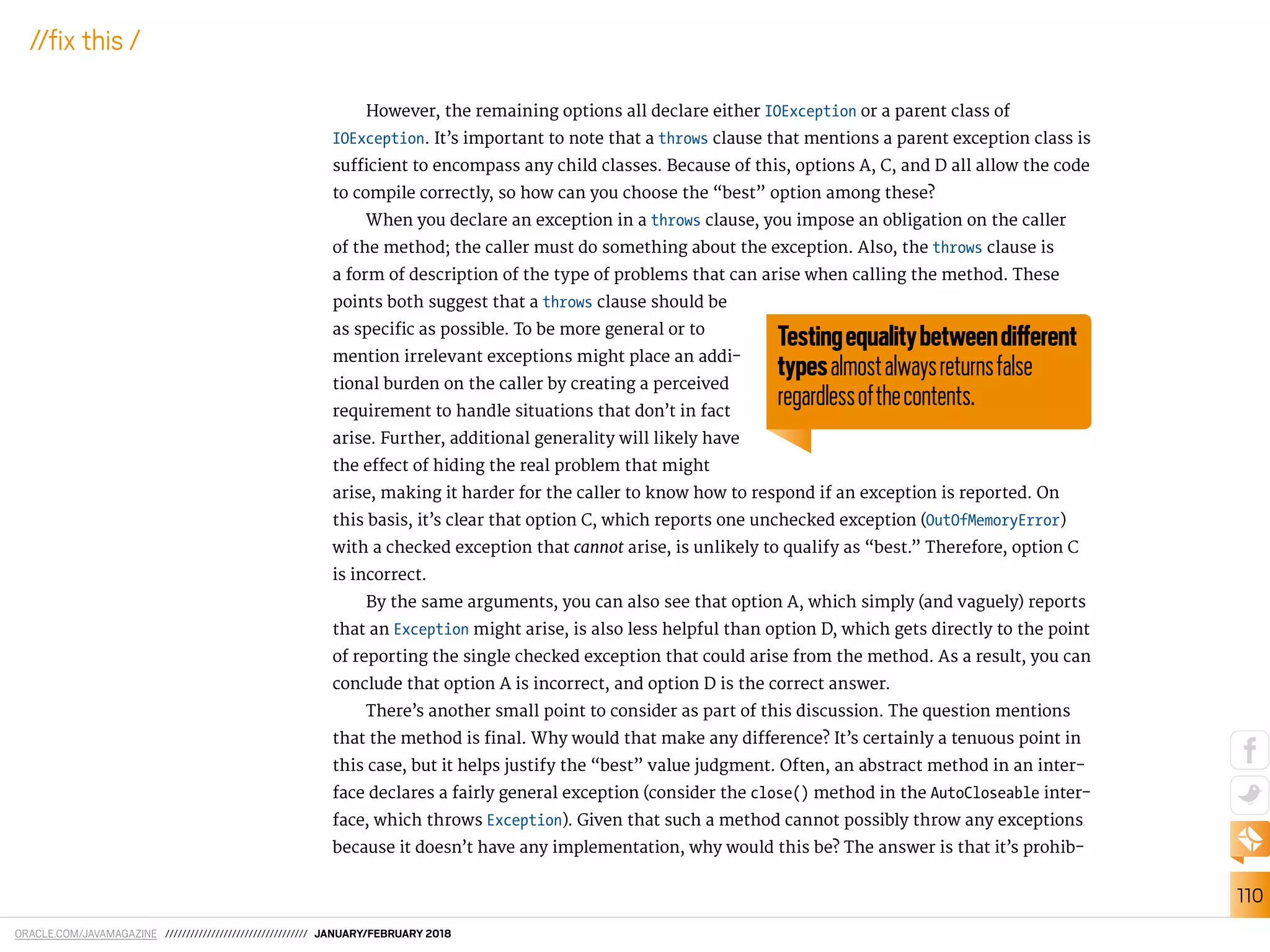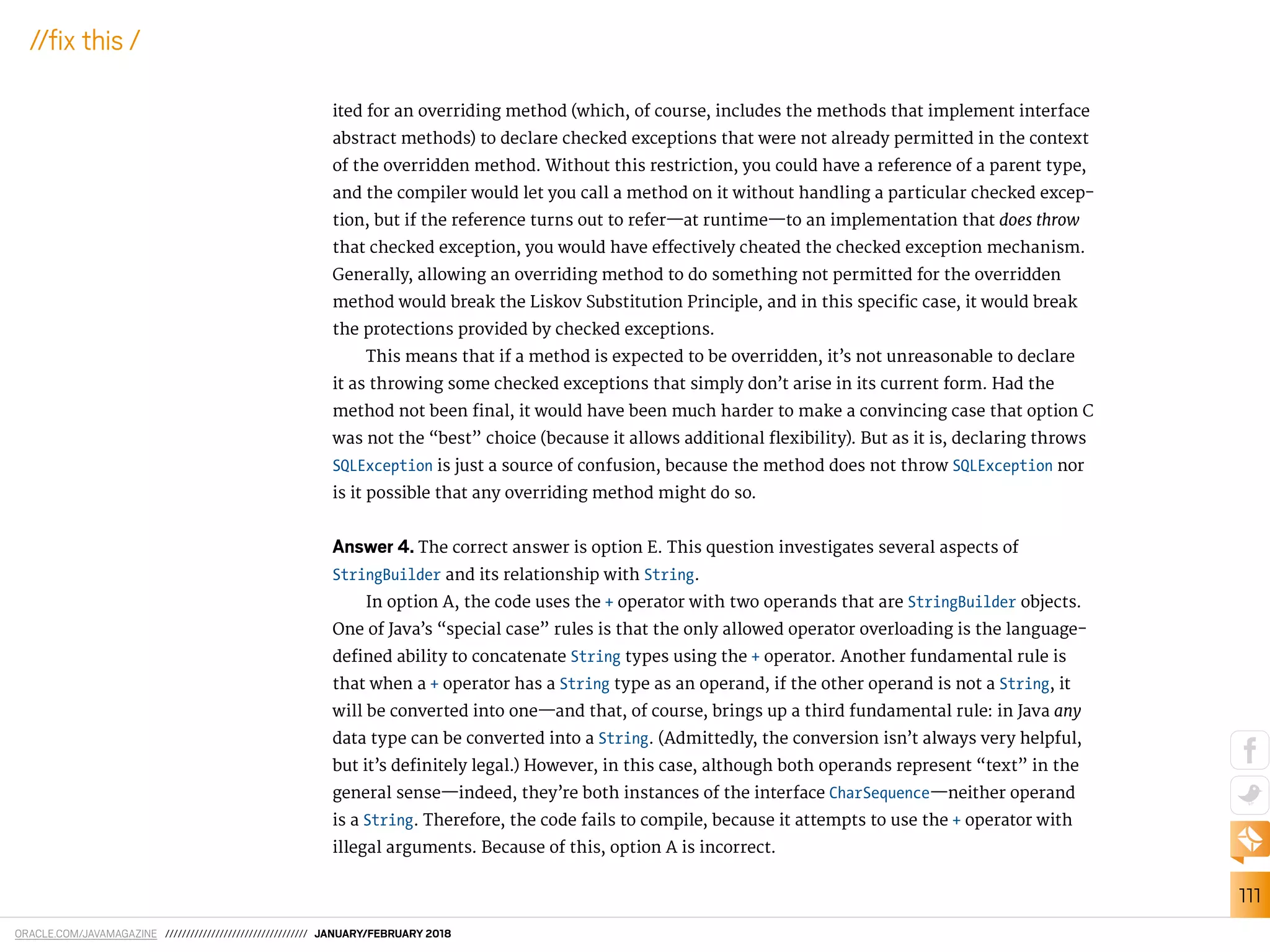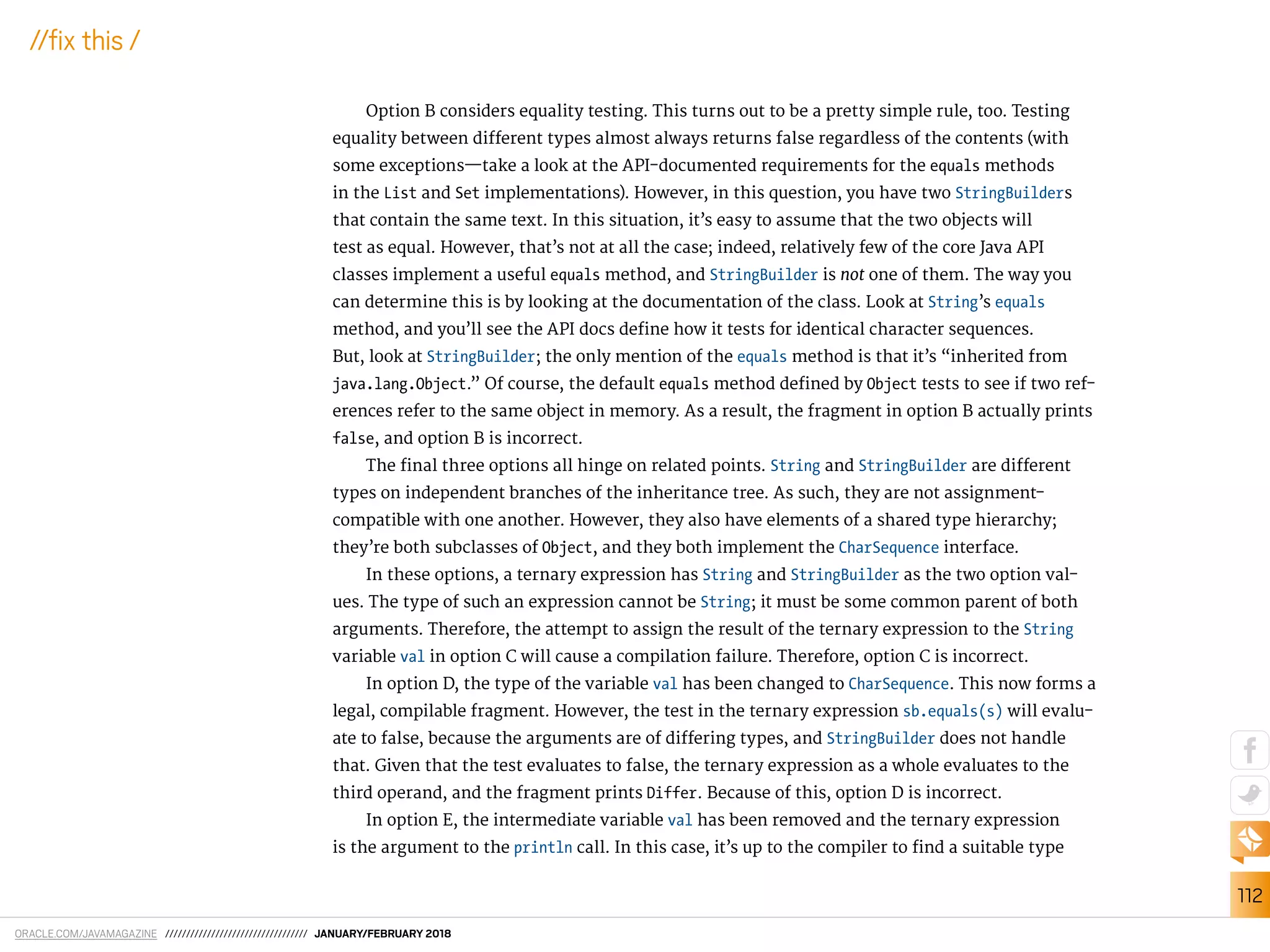The document summarizes trends in modern programming language design showing a preference for static typing over dynamic typing. Some key advantages of static typing mentioned are improved compiler verification, better performance, and increased maintainability for large codebases. While dynamic languages remain popular, new languages are less likely to embrace dynamic typing models due to drawbacks that become more apparent as projects grow in size and complexity over time.



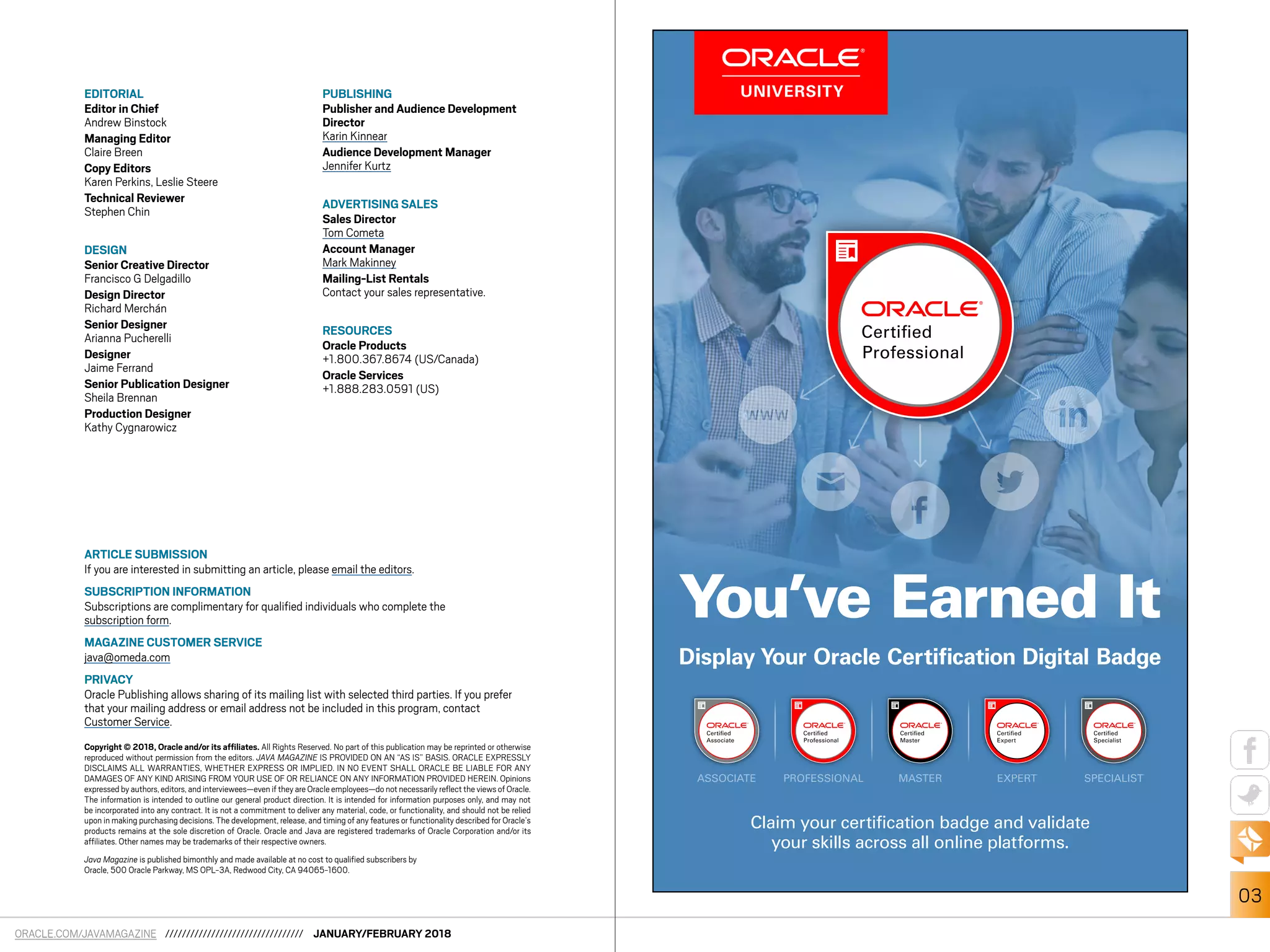

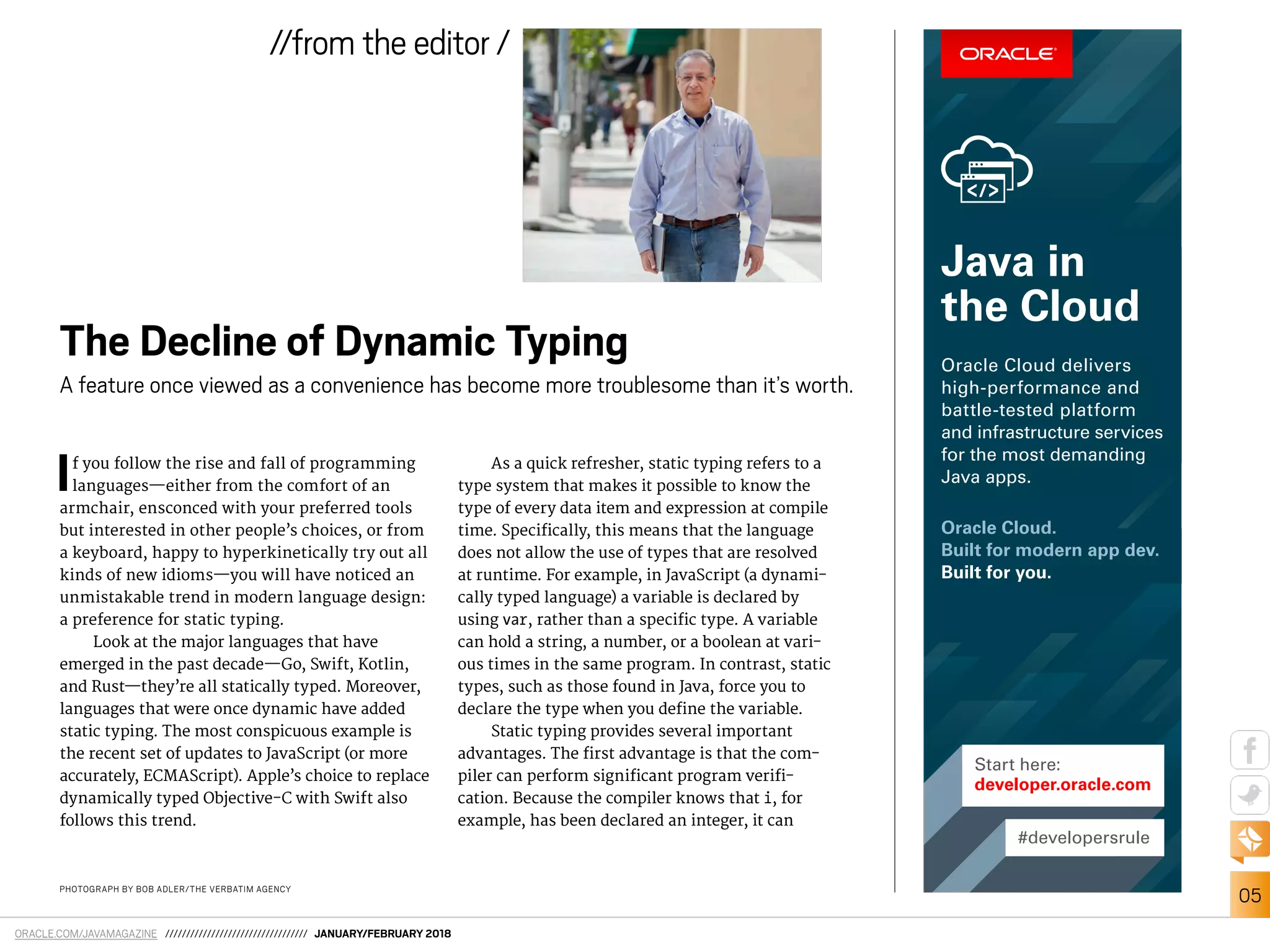

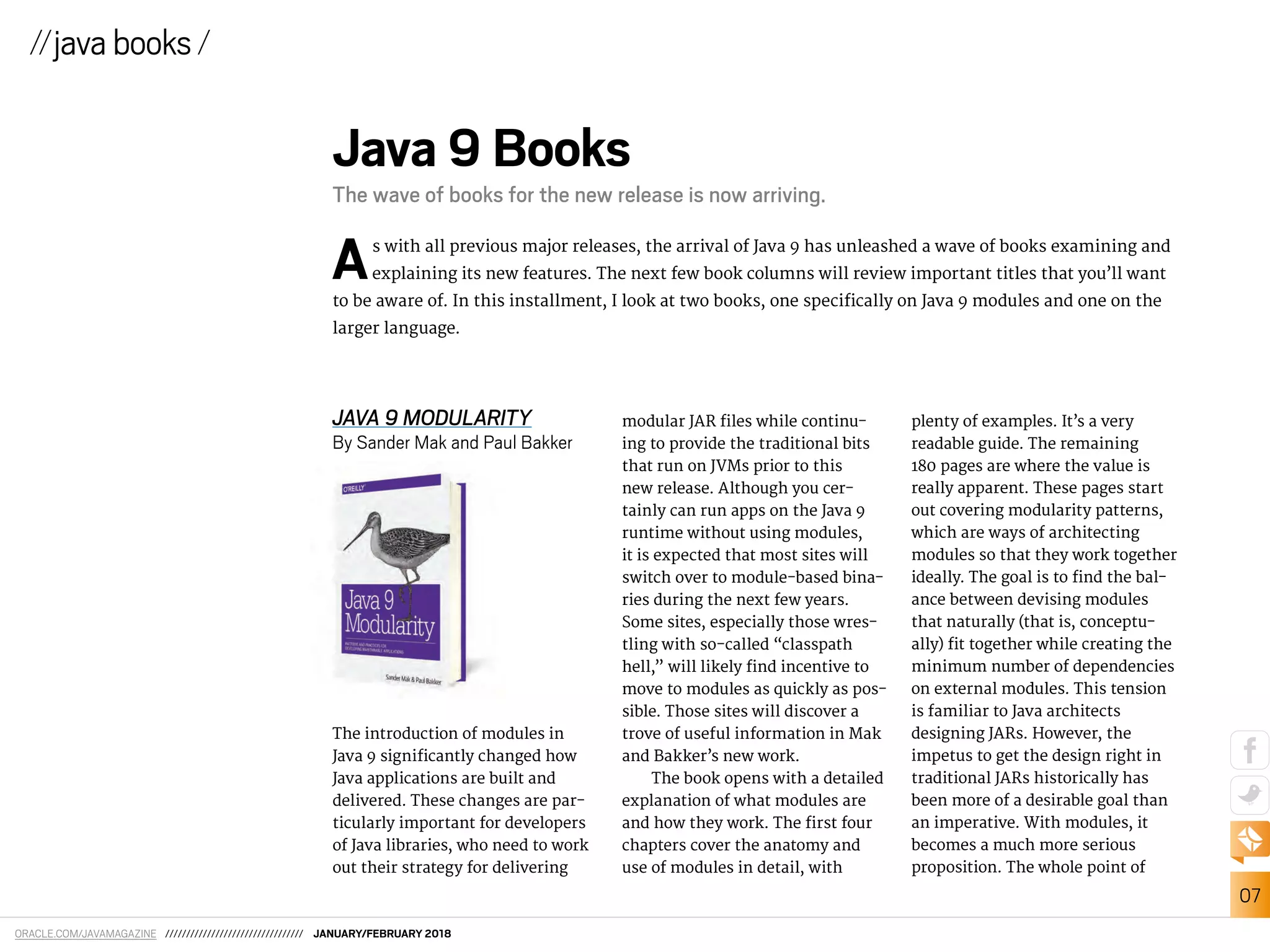
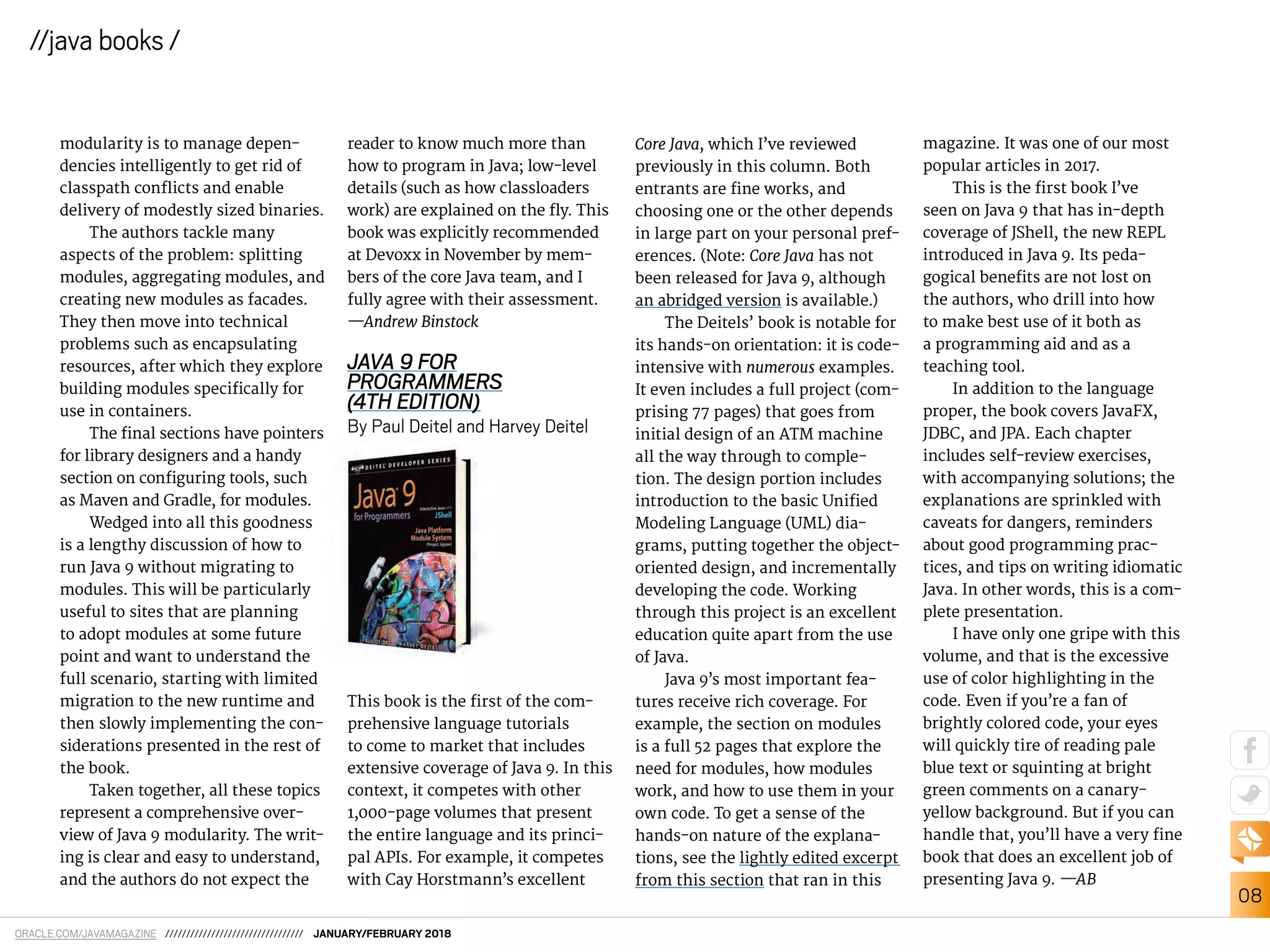

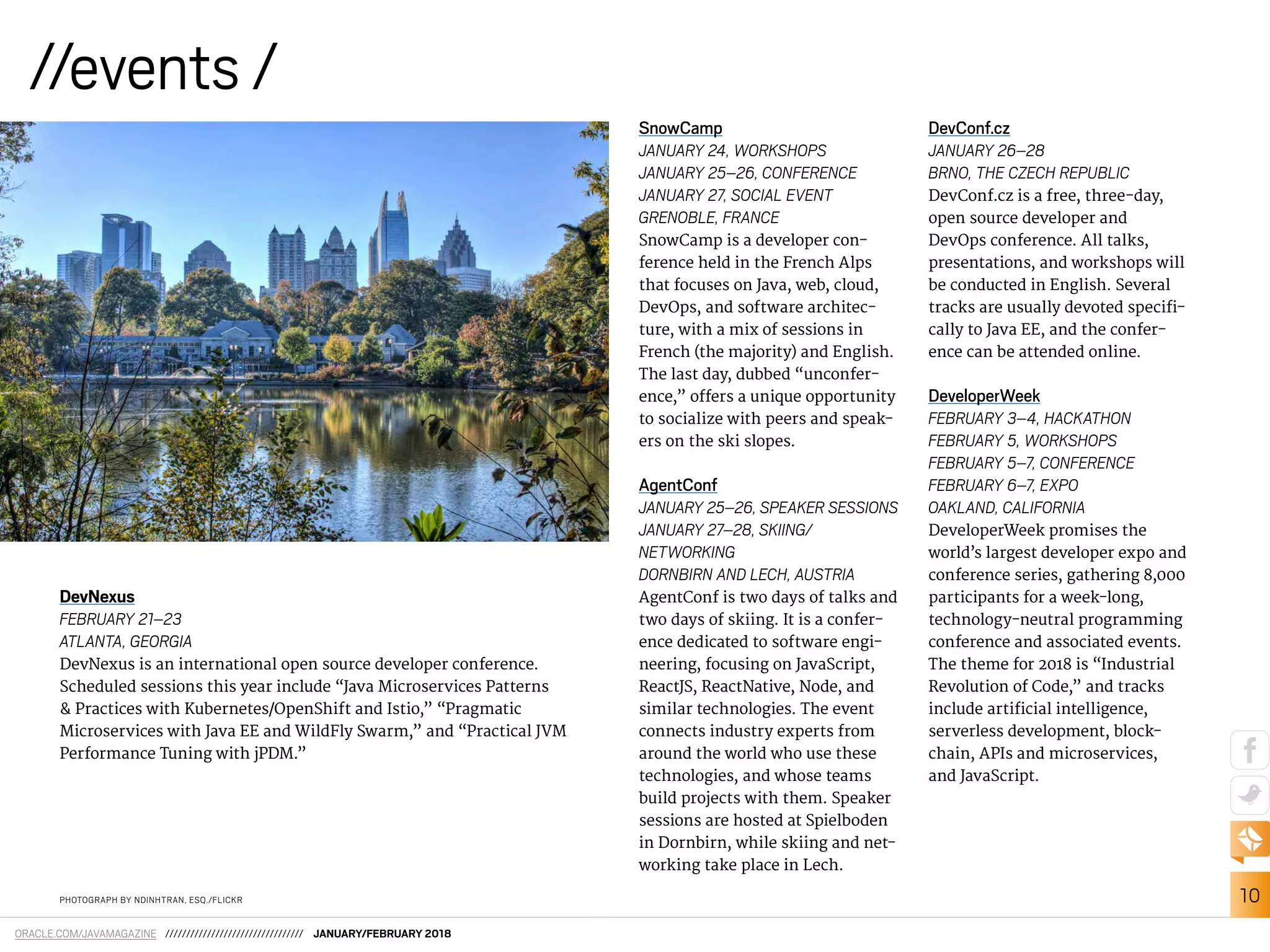

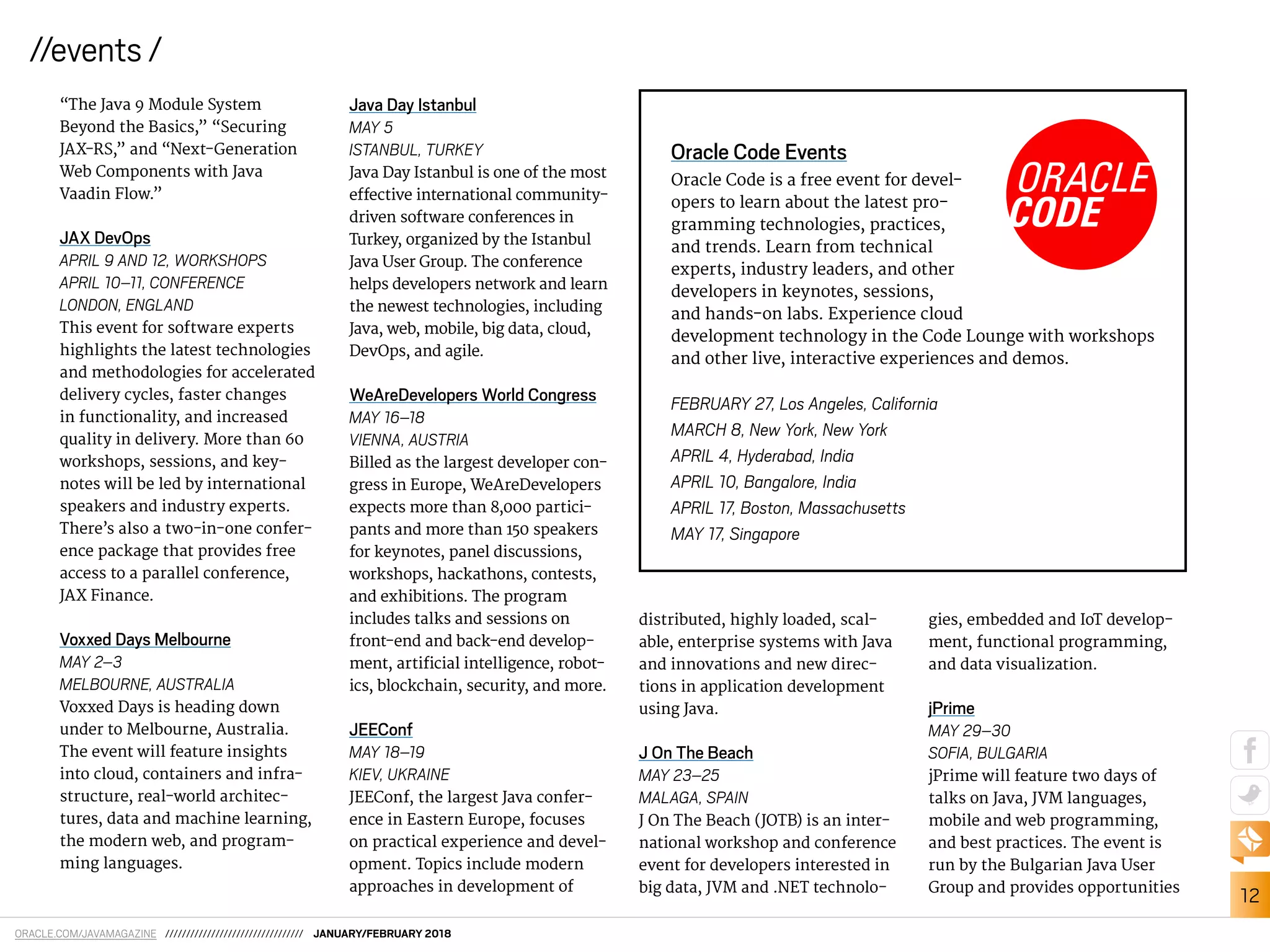


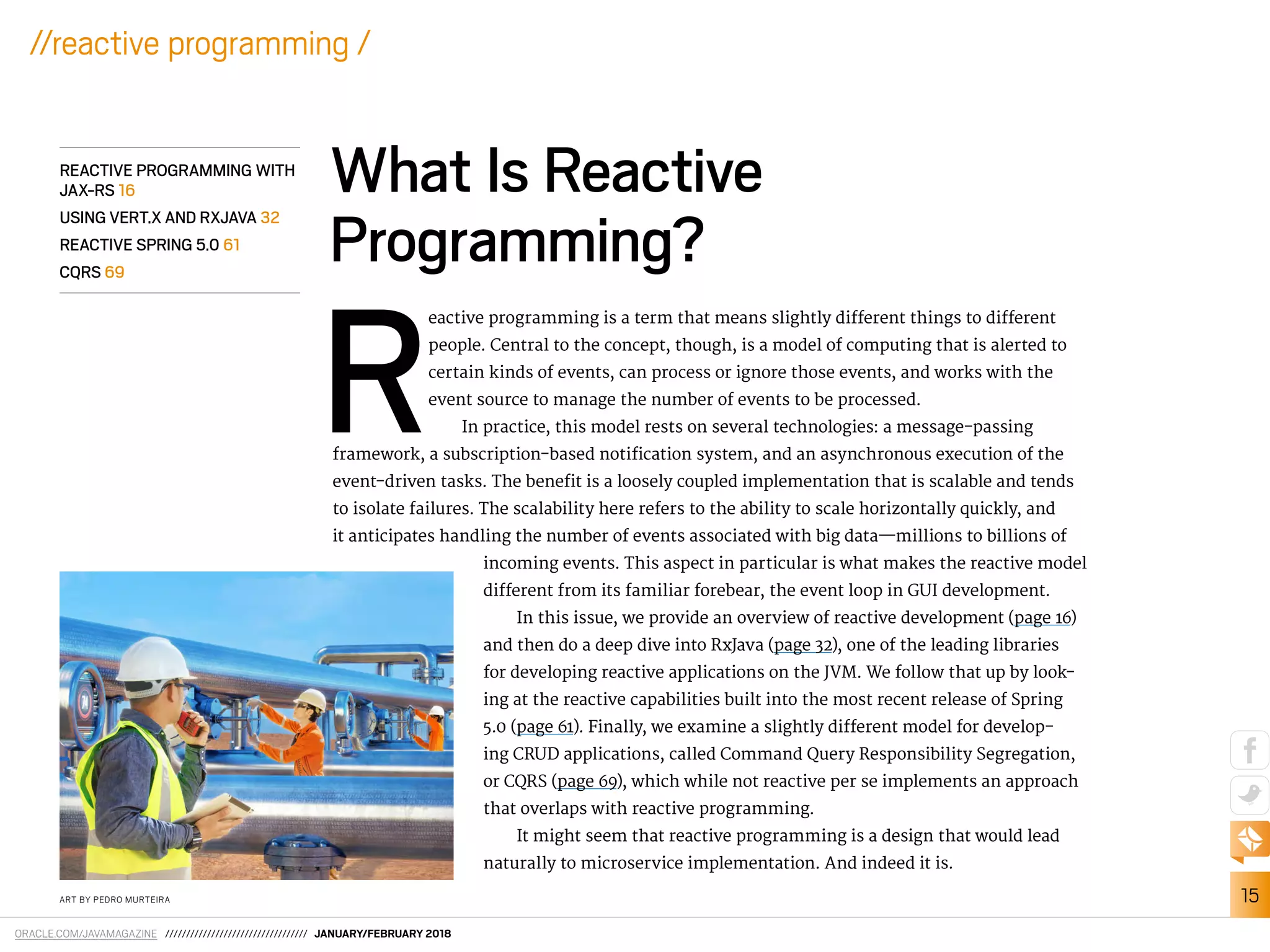
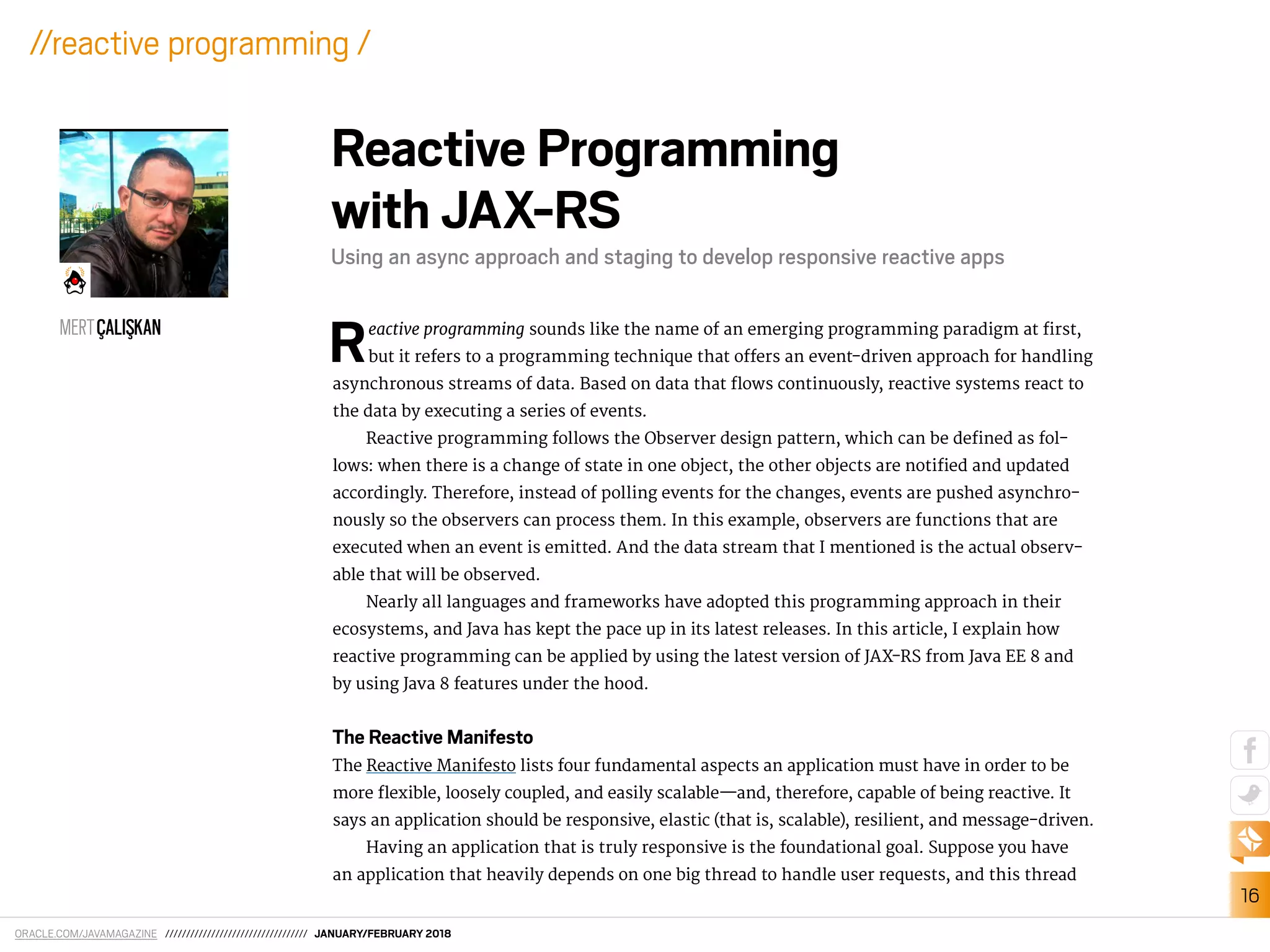
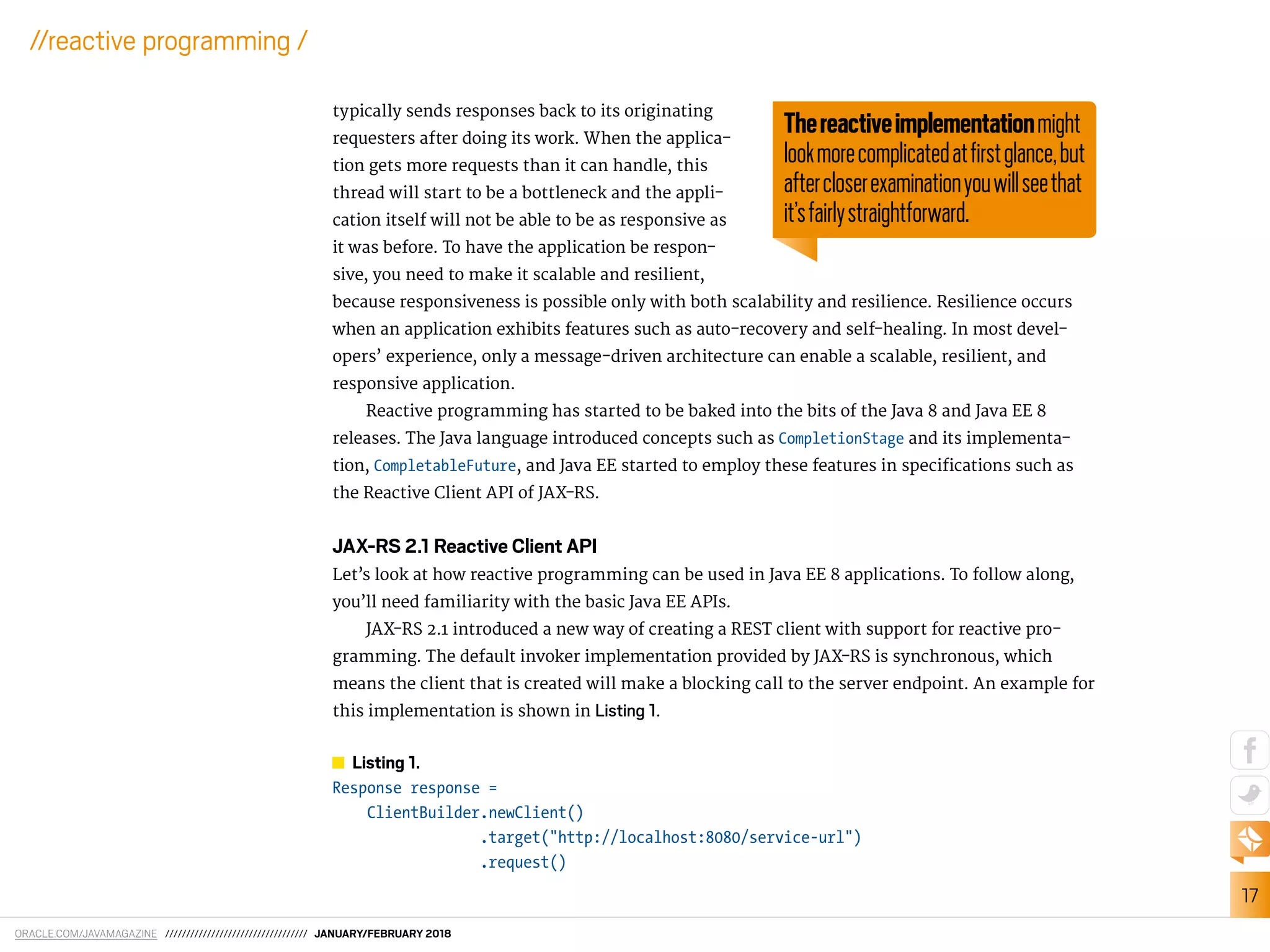
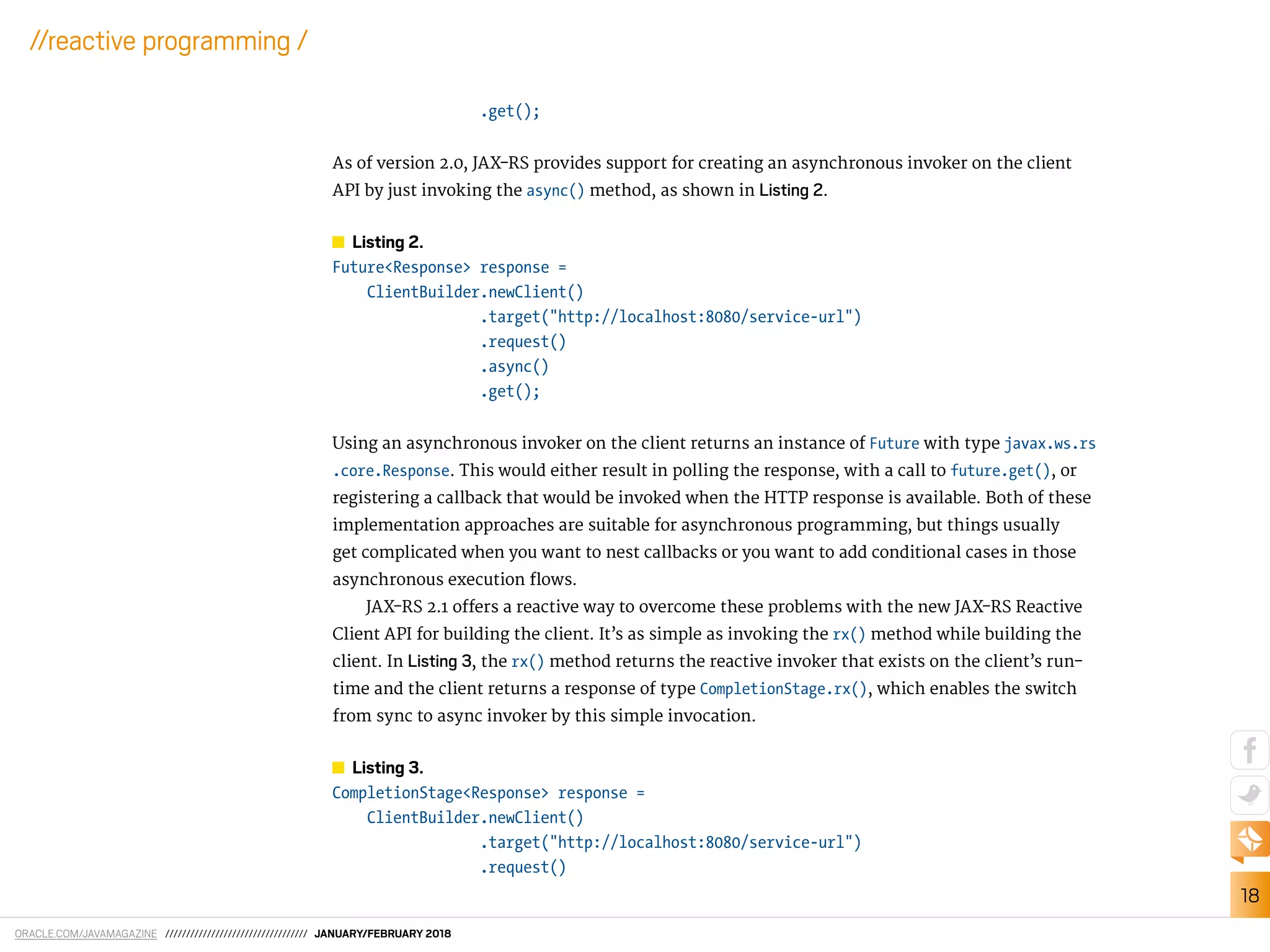
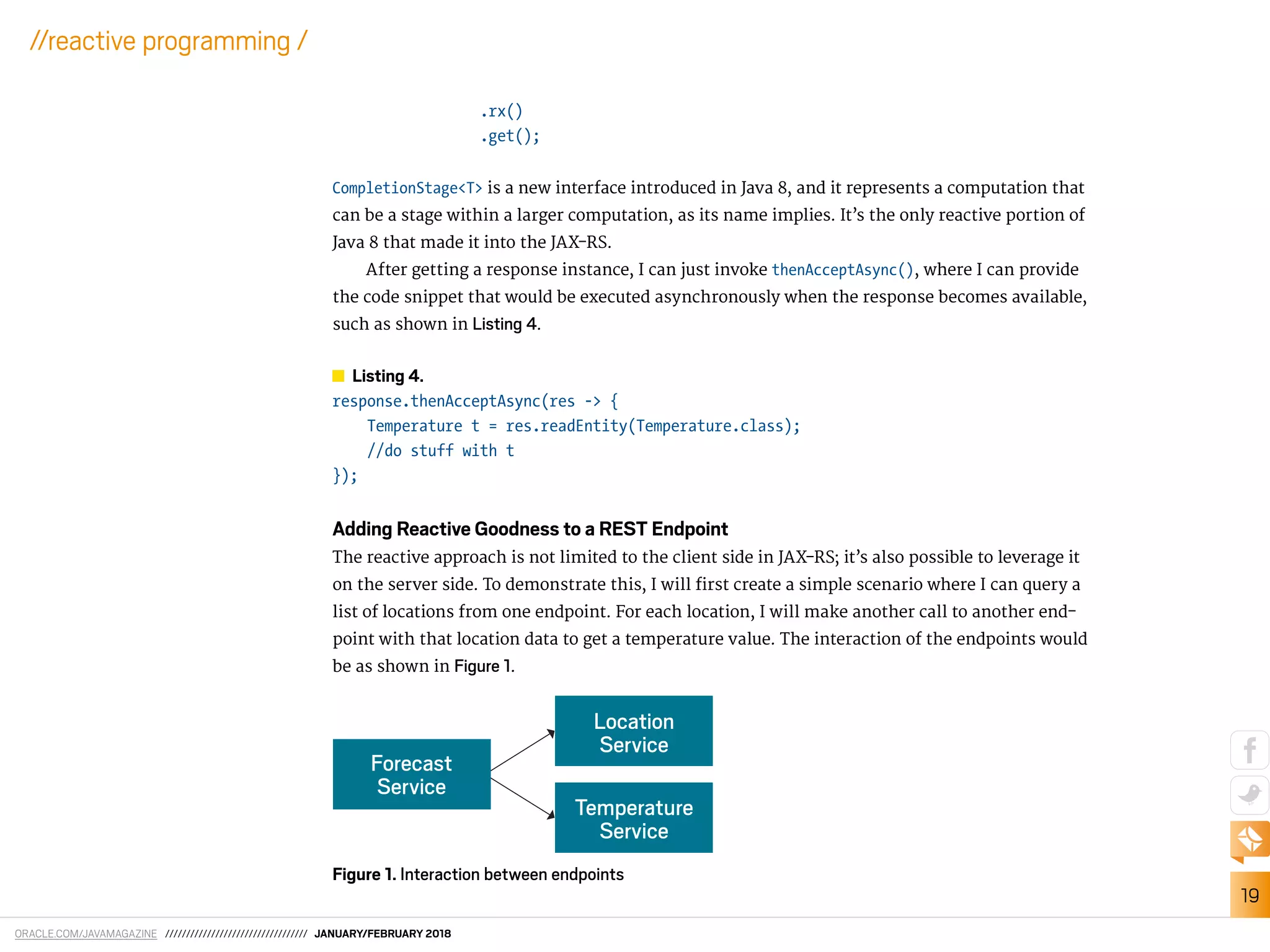
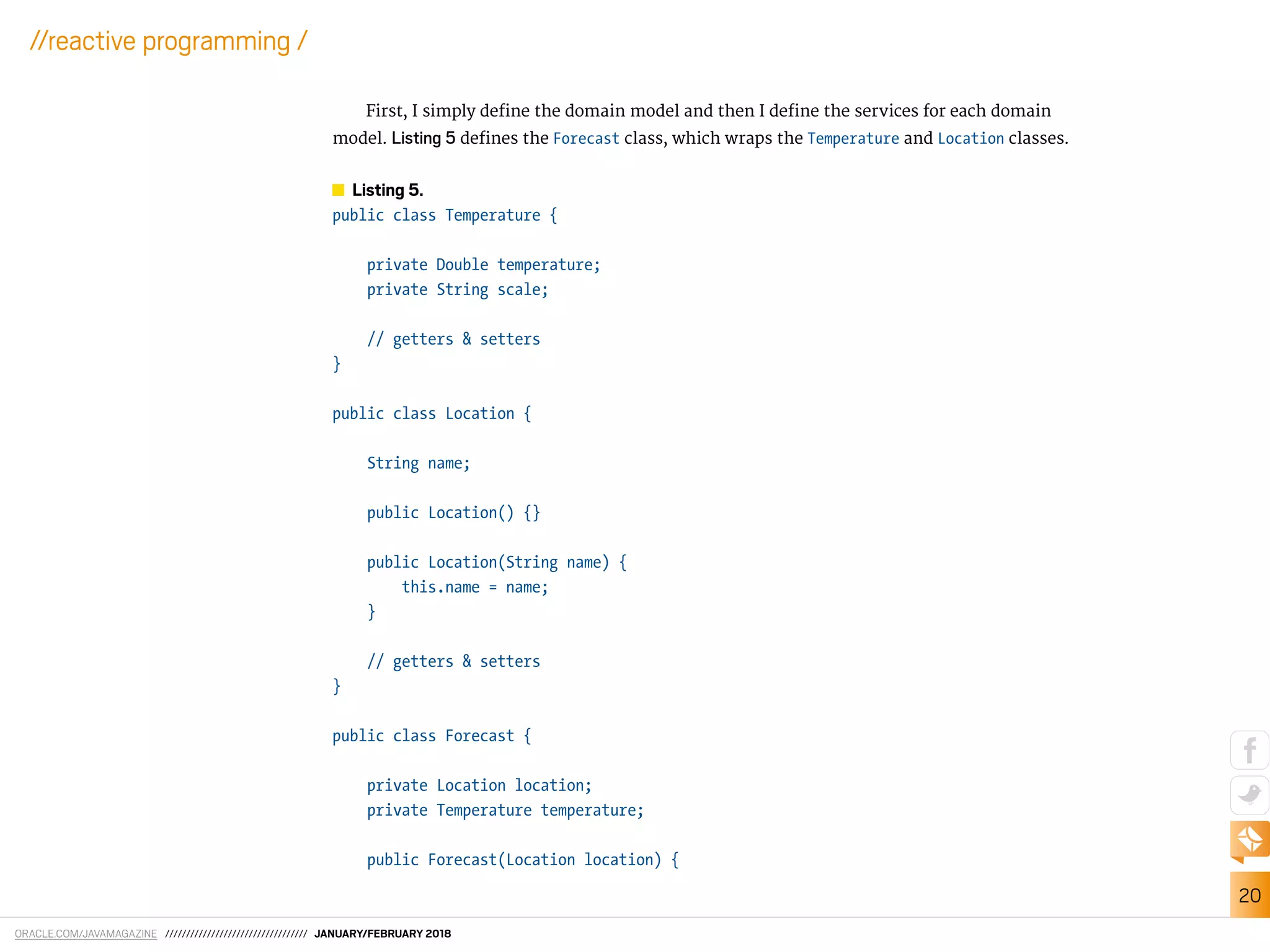
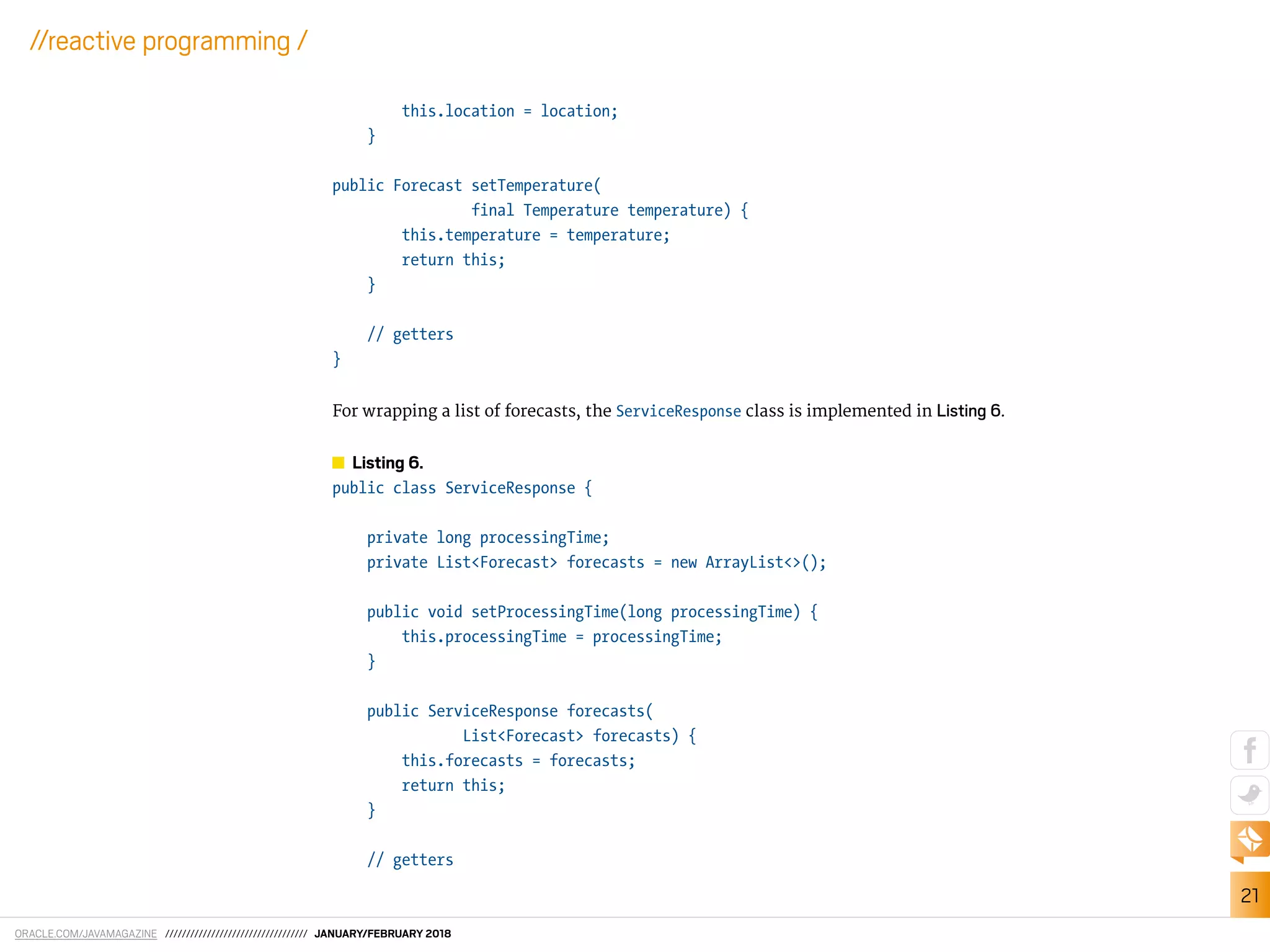

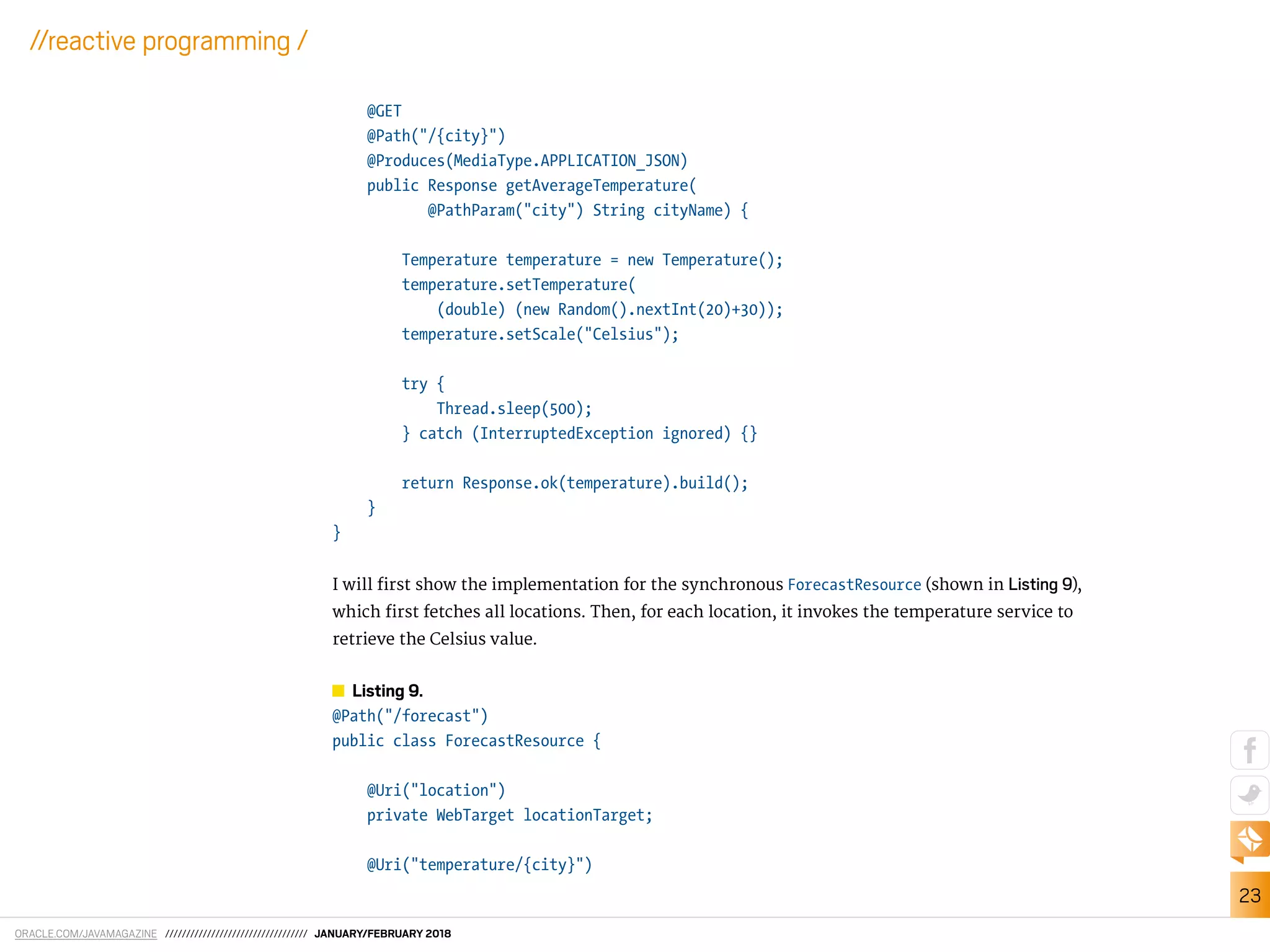
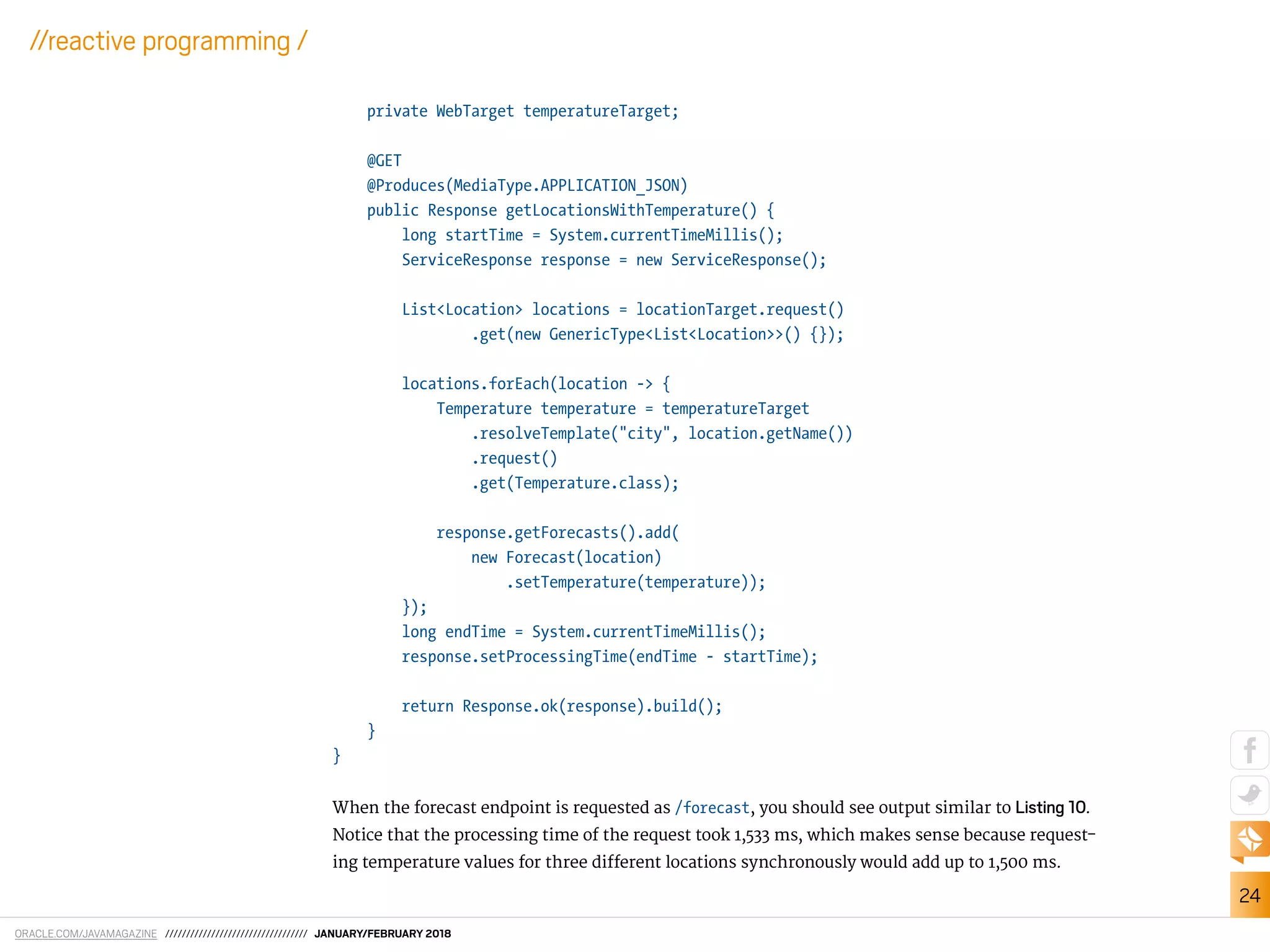
![ORACLE.COM/JAVAMAGAZINE ////////////////////////////////// JANUARY/FEBRUARY 2018
25
//reactive programming /
Listing 10.
{
"forecasts": [
{
"location": {
"name": "London"
},
"temperature": {
"scale": "Celsius",
"temperature": 33
}
},
{
"location": {
"name": "Istanbul"
},
"temperature": {
"scale": "Celsius",
"temperature": 38
}
},
{
"location": {
"name": "Prague"
},
"temperature": {
"scale": "Celsius",
"temperature": 46
}
}
],](https://image.slidesharecdn.com/javamagazinejanfeb2018-181010114542/75/Java-magazine-jan-feb-2018-26-2048.jpg)
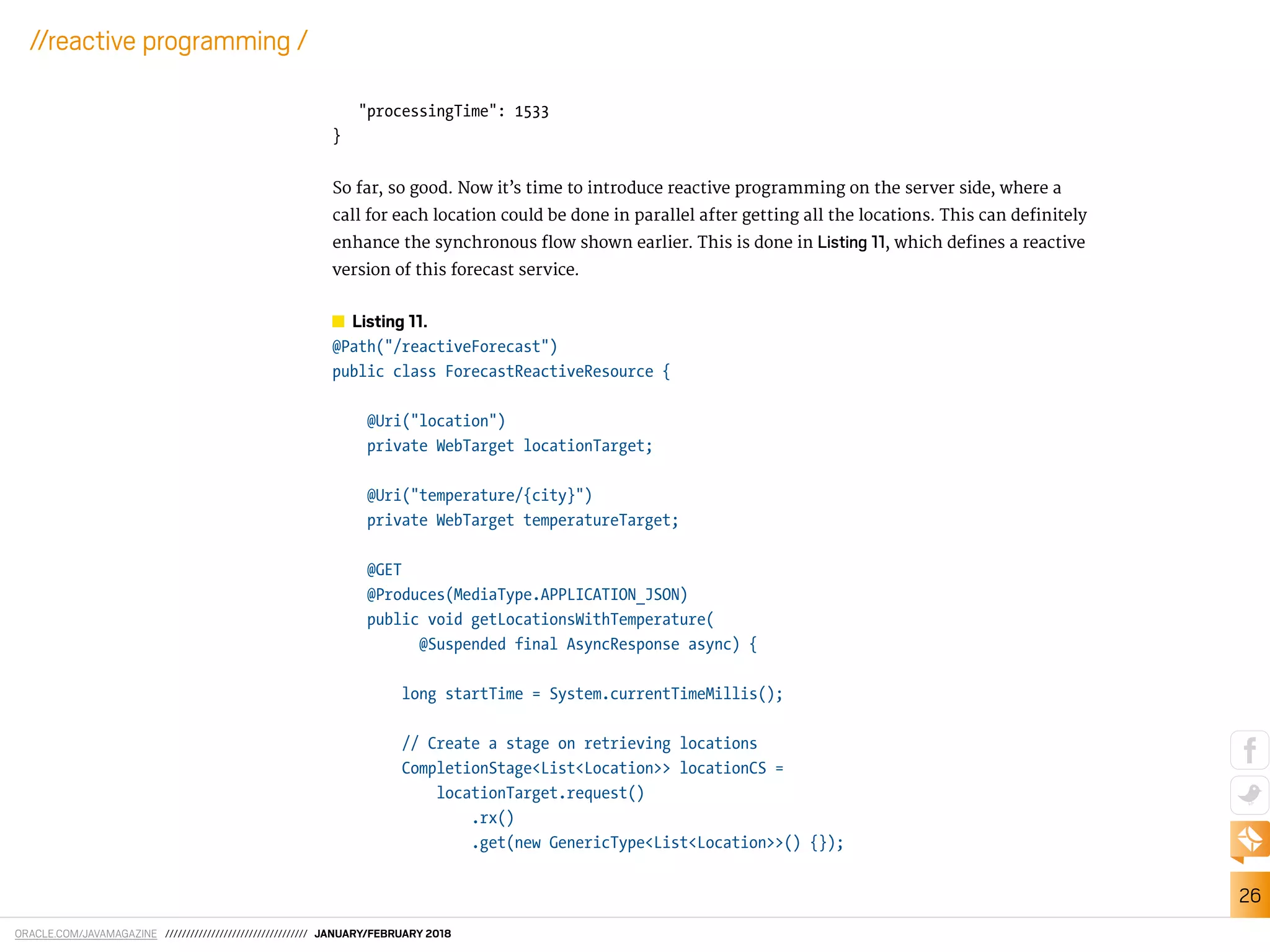
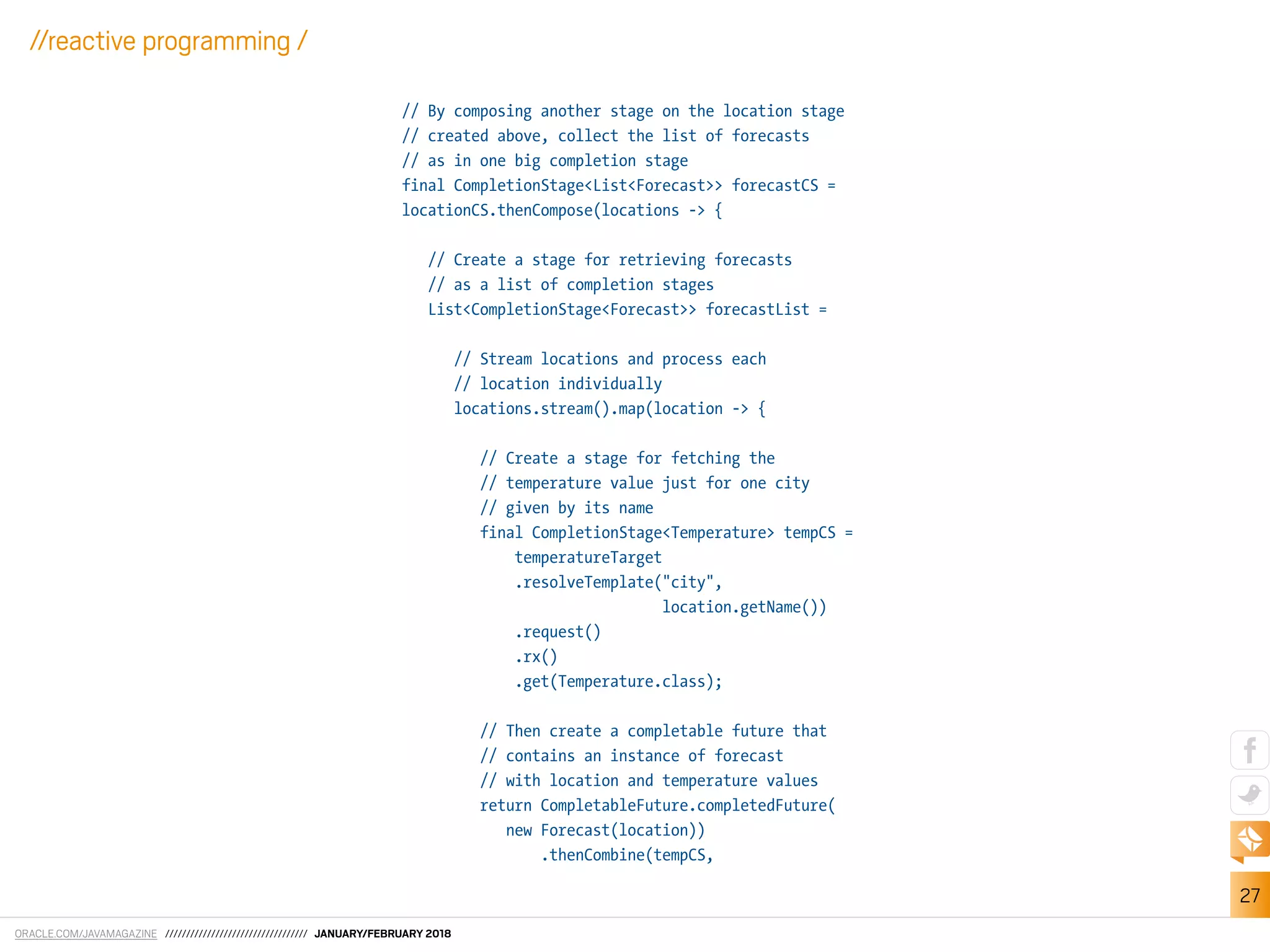
![ORACLE.COM/JAVAMAGAZINE ////////////////////////////////// JANUARY/FEBRUARY 2018
28
//reactive programming /
Forecast::setTemperature);
}).collect(Collectors.toList());
// Return a final completable future instance
// when all provided completable futures are
// completed
return CompletableFuture.allOf(
forecastList.toArray(
new CompletableFuture[forecastList.size()]))
.thenApply(v -> forecastList.stream()
.map(CompletionStage::toCompletableFuture)
.map(CompletableFuture::join)
.collect(Collectors.toList()));
});
// Create an instance of ServiceResponse,
// which contains the whole list of forecasts
// along with the processing time.
// Create a completed future of it and combine to
// forecastCS in order to retrieve the forecasts
// and set into service response
CompletableFuture.completedFuture(
new ServiceResponse())
.thenCombine(forecastCS,
ServiceResponse::forecasts)
.whenCompleteAsync((response, throwable) -> {
response.setProcessingTime(
System.currentTimeMillis() - startTime);
async.resume(response);
});
}
}](https://image.slidesharecdn.com/javamagazinejanfeb2018-181010114542/75/Java-magazine-jan-feb-2018-29-2048.jpg)
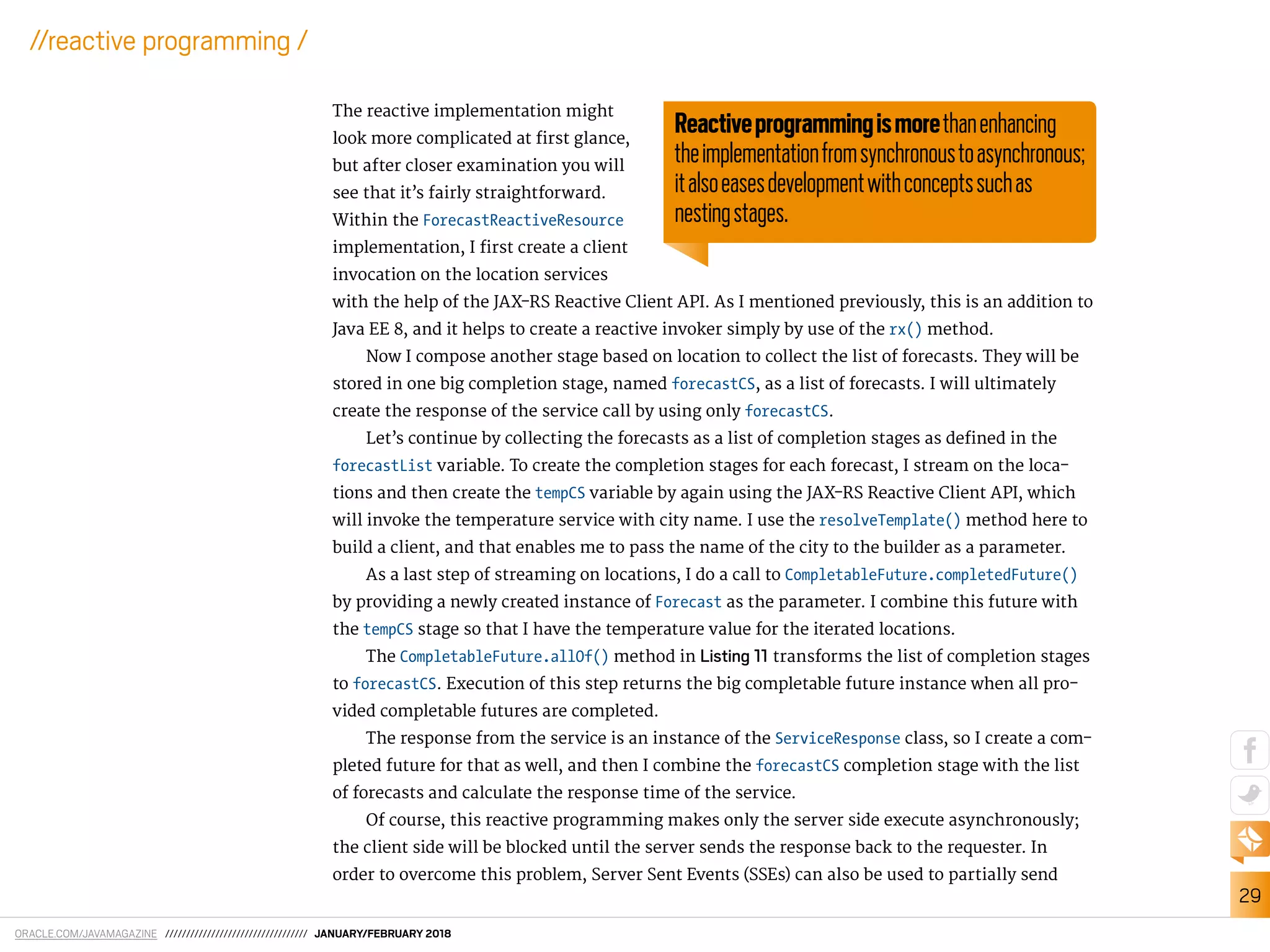

![ORACLE.COM/JAVAMAGAZINE ////////////////////////////////// JANUARY/FEBRUARY 2018
31
//reactive programming /
"scale": "Celsius",
"temperature": 45
}
}
],
"processingTime": 515
}
Conclusion
Throughout the examples in this article, I irst showed the synchronous way to retrieve the
forecast information by choreographing location and temperature services. Then I moved on
to the reactive approach in order to have the asynchronous processing occur between service
calls. When you leverage the use of the JAX-RS Reactive Client API of Java EE 8 and classes such
as CompletionStage and CompletableFuture shipping with Java 8, the power of asynchronous pro-
cessing is unleashed with the help of reactive-style programming.
Reactive programming is more than enhancing the implementation from a synchro-
nous to an asynchronous model; it also eases development with concepts such as nesting
stages. The more it is adopted, the easier it will be to handle complex scenarios in parallel
programming. </article>
Mert Çalis¸kan (@mertcal) is a Java Champion and a coauthor of PrimeFaces Cookbook (Packt Publishing,
2013) and Beginning Spring (Wiley Publications, 2015). He currently is working on his latest book, Java EE 8
Microservices, and he works as a developer on the Payara Server inside the Payara Foundation.](https://image.slidesharecdn.com/javamagazinejanfeb2018-181010114542/75/Java-magazine-jan-feb-2018-32-2048.jpg)

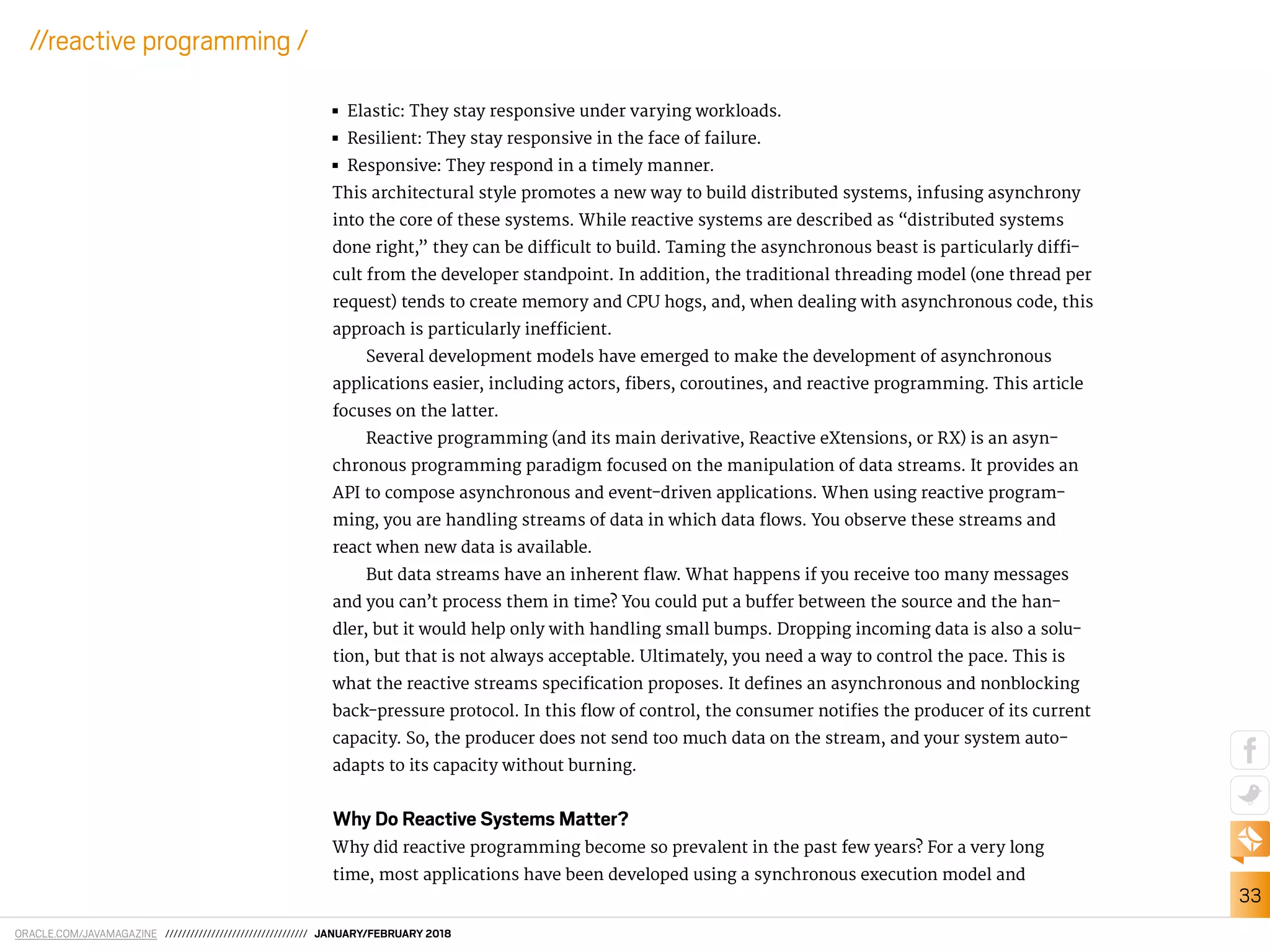

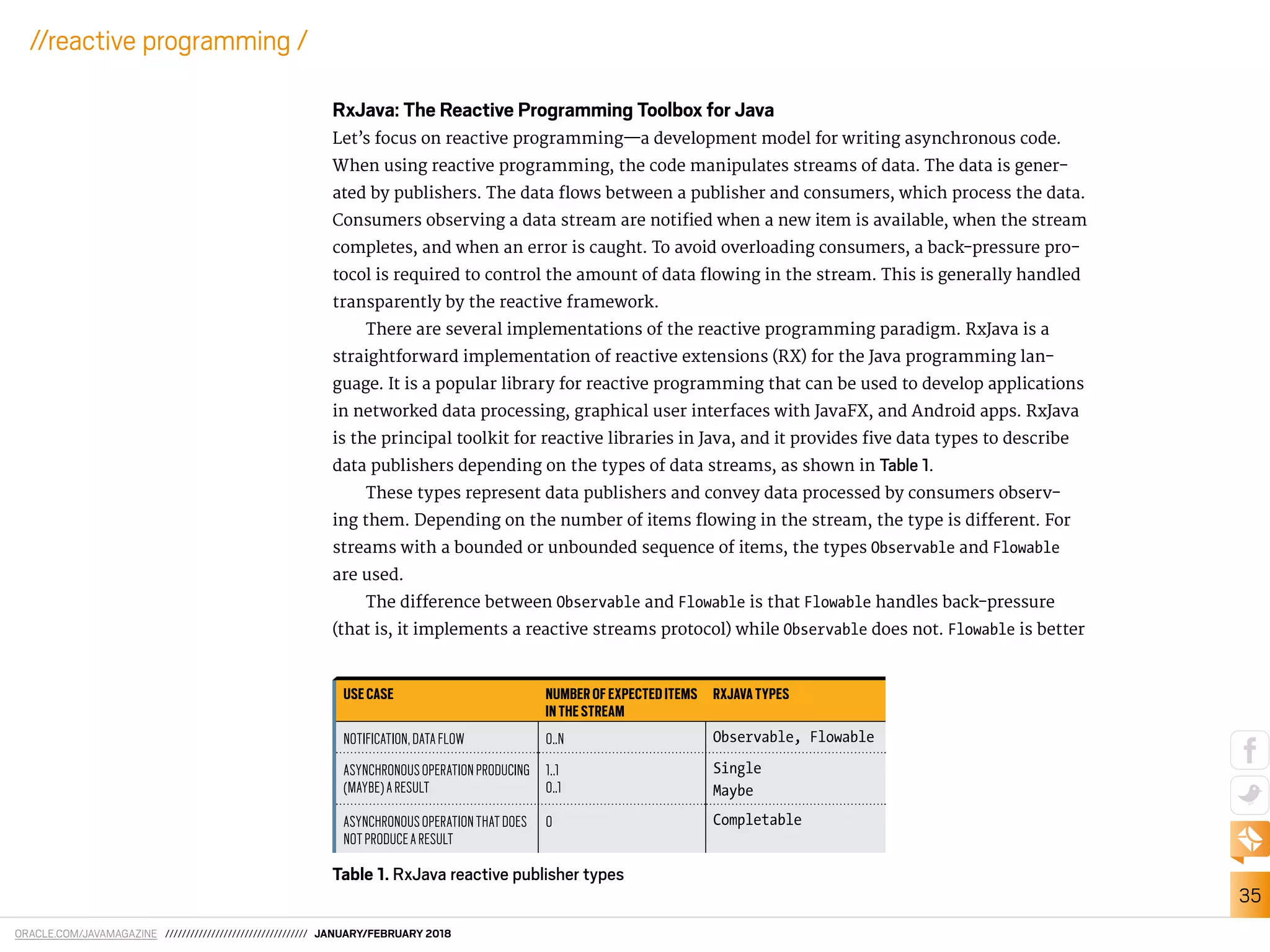
![ORACLE.COM/JAVAMAGAZINE ////////////////////////////////// JANUARY/FEBRUARY 2018
36
//reactive programming /
suited for large streams of data coming from a source that supports back-pressure (for exam-
ple, a TCP connection), while Observable is better suited at handling so-called “hot” observ-
ables for which back-pressure cannot be applied (such as GUI events and other user actions).
It is important to note that not all streams can support back-pressure. In fact, most of the
streams conveying data captured in the physical world are not capable of this. Reactive pro-
gramming libraries propose strategies such as bufers and acceptable data loss for handling
these cases.
Getting started with RxJava. It’s time to see some code and make reactive clearer. The com-
plete project source code is available online. Clone or download this project and check the
content of the rxjava-samples subproject. It uses RxJava 2.x and the logback-classic logging
library. You will see later how it helps you understand threading with RxJava.
In the previous section, we briely examined the diferent reactive types proposed by
RxJava. The following class creates instances of these types and applies some basic operations:
package samples;
import io.reactivex.Completable;
import io.reactivex.Flowable;
import io.reactivex.Maybe;
import io.reactivex.Single;
import io.reactivex.functions.Consumer;
import org.slf4j.Logger;
import org.slf4j.LoggerFactory;
public class RxHello {
private static final Logger logger =
LoggerFactory.getLogger(RxHello.class);
public static void main(String[] args) {](https://image.slidesharecdn.com/javamagazinejanfeb2018-181010114542/75/Java-magazine-jan-feb-2018-37-2048.jpg)
![ORACLE.COM/JAVAMAGAZINE ////////////////////////////////// JANUARY/FEBRUARY 2018
37
//reactive programming /
Single.just(1)
.map(i -> i * 10)
.map(Object::toString)
.subscribe((Consumer<String>) logger::info);
Maybe.just("Something")
.subscribe(logger::info);
Maybe.never()
.subscribe(o -> logger.info("Something is here..."));
Completable.complete()
.subscribe(() -> logger.info("Completed"));
Flowable.just("foo", "bar", "baz")
.filter(s -> s.startsWith("b"))
.map(String::toUpperCase)
.subscribe(logger::info);
}
}
Running this example yields output similar to this:
11:24:28.638 [main] INFO samples.RxHello - 10
11:24:28.661 [main] INFO samples.RxHello - Something
11:24:28.672 [main] INFO samples.RxHello - Completed
11:24:28.716 [main] INFO samples.RxHello - BAR
11:24:28.716 [main] INFO samples.RxHello - BAZ
It is important to note that as with Java collection streams, no processing happens until an end
event takes place. In RxJava, that event is a subscription. In this example, we used subscribe()](https://image.slidesharecdn.com/javamagazinejanfeb2018-181010114542/75/Java-magazine-jan-feb-2018-38-2048.jpg)
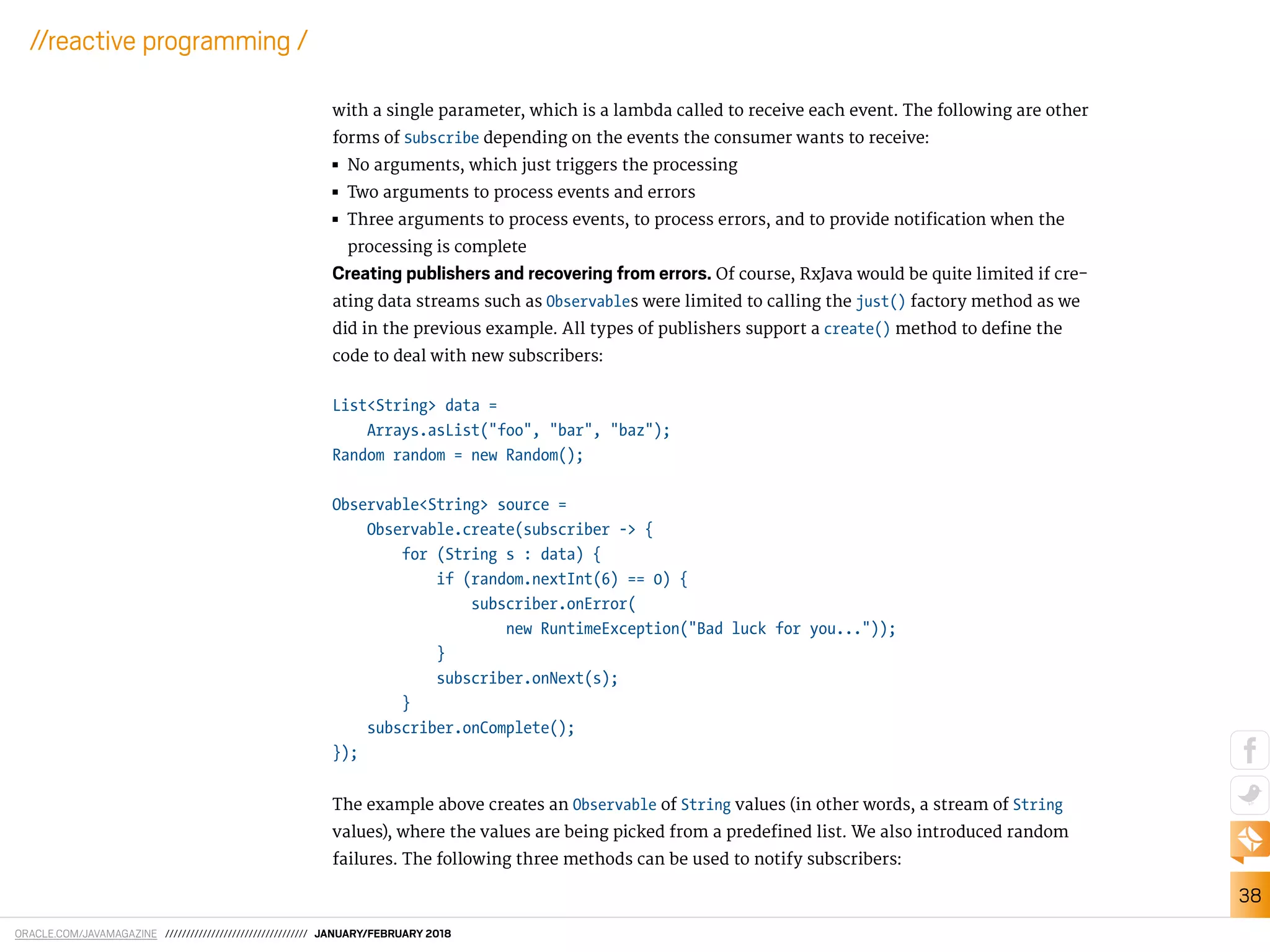
![ORACLE.COM/JAVAMAGAZINE ////////////////////////////////// JANUARY/FEBRUARY 2018
39
//reactive programming /
■■ onNext, when a new value is sent to the subscriber, possibly passing through intermediate
operators before it reaches the subscriber
■■ onComplete to indicate that no more values will be sent
■■ onError to indicate that an error happened and that no further value will be sent; any
Throwable can be used as an error value
Note that create() is not the only way to deine custom publishers, but presenting all
options would be outside the scope of this article.
Because there is a good probability that errors will happen, we can test this Observable
10 times:
for (int i = 0; i < 10; i++) {
logger.info("=======================================");
source.subscribe(
next -> logger.info("Next: {}", next),
error -> logger.error("Whoops"),
() -> logger.info("Done"));
}
We can observe successful completions as well as errors in the execution traces:
11:51:47.469 [main] INFO samples.RxCreateObservable -
=======================================
11:51:47.469 [main] INFO samples.RxCreateObservable - Next: foo
11:51:47.469 [main] INFO samples.RxCreateObservable - Next: bar
11:51:47.469 [main] INFO samples.RxCreateObservable - Next: baz
11:51:47.469 [main] INFO samples.RxCreateObservable - Done
11:51:47.469 [main] INFO samples.RxCreateObservable -
=======================================
11:51:47.469 [main] INFO samples.RxCreateObservable - Next: foo
11:51:47.469 [main] INFO samples.RxCreateObservable - Next: bar](https://image.slidesharecdn.com/javamagazinejanfeb2018-181010114542/75/Java-magazine-jan-feb-2018-40-2048.jpg)
![ORACLE.COM/JAVAMAGAZINE ////////////////////////////////// JANUARY/FEBRUARY 2018
40
//reactive programming /
11:51:47.469 [main] ERROR samples.RxCreateObservable - Whoops
11:51:47.469 [main] INFO samples.RxCreateObservable -
=======================================
11:51:47.469 [main] INFO samples.RxCreateObservable - Next: foo
11:51:47.469 [main] ERROR samples.RxCreateObservable - Whoops
RxJava supports various ways to recover from errors, such as switching to another stream or
providing a default value. Another option is to use retry():
source
.retry(5)
.subscribe(next -> logger.info("Next: {}", next),
error -> logger.error("Whoops"),
() -> logger.info("Done"));
Above, we speciied that in case of error, we should retry at most ive times with new subscrip-
tions. Note that retries might use another thread for execution. Because errors are random,
your exact output trace will vary across executions, but the following output shows an example
of retries:
11:51:47.472 [main] INFO samples.RxCreateObservable - Next: foo
11:51:47.472 [main] INFO samples.RxCreateObservable - Next: bar
11:51:47.472 [main] INFO samples.RxCreateObservable - Next: foo
11:51:47.472 [main] INFO samples.RxCreateObservable - Next: bar
11:51:47.472 [main] INFO samples.RxCreateObservable - Next: baz
11:51:47.472 [main] INFO samples.RxCreateObservable - Done
RxJava and threads. So far, we haven’t cared much about multithreading. Let’s take another
example and run it:
Flowable.range(1, 5)](https://image.slidesharecdn.com/javamagazinejanfeb2018-181010114542/75/Java-magazine-jan-feb-2018-41-2048.jpg)
![ORACLE.COM/JAVAMAGAZINE ////////////////////////////////// JANUARY/FEBRUARY 2018
41
//reactive programming /
.map(i -> i * 10)
.map(i -> {
logger.info("map({})", i);
return i.toString();
})
.subscribe(logger::info);
Thread.sleep(1000);
You can see from the logs that all processing happens on the main thread:
12:01:01.097 [main] INFO samples.RxThreading - map(10)
12:01:01.100 [main] INFO samples.RxThreading - 10
12:01:01.100 [main] INFO samples.RxThreading - map(20)
12:01:01.100 [main] INFO samples.RxThreading - 20
12:01:01.100 [main] INFO samples.RxThreading - map(30)
12:01:01.100 [main] INFO samples.RxThreading - 30
12:01:01.100 [main] INFO samples.RxThreading - map(40)
12:01:01.100 [main] INFO samples.RxThreading - 40
12:01:01.100 [main] INFO samples.RxThreading - map(50)
12:01:01.100 [main] INFO samples.RxThreading - 50
In fact, both the operator processing and the subscriber notiications happen from that main
thread. By default, a publisher (and the chain of operators that you apply to it) will do its work,
and will notify its consumers, on the same thread on which its subscribe method is called.
RxJava ofers Schedulers to oload work to specialized threads and executors. Schedulers are
responsible for notifying the subscribers on the correct thread even if it’s not the thread used
to call subscribe.
The io.reactivex.schedulers.Schedulers class ofers several schedulers, with the most
interesting being these:](https://image.slidesharecdn.com/javamagazinejanfeb2018-181010114542/75/Java-magazine-jan-feb-2018-42-2048.jpg)
![ORACLE.COM/JAVAMAGAZINE ////////////////////////////////// JANUARY/FEBRUARY 2018
42
//reactive programming /
■■ computation() for CPU-intensive work with no blocking I/O operations
■■ io() for all blocking I/O operations
■■ single(), which is a shared thread for operations to execute in order
■■ from(executor) to oload all scheduled work to a custom executor
Now, back to our previous example, we can specify how the subscription and observation will
be scheduled:
Flowable.range(1, 5)
.map(i -> i * 10)
.map(i -> {
logger.info("map({})", i);
return i.toString();
})
.observeOn(Schedulers.single())
.subscribeOn(Schedulers.computation())
.subscribe(logger::info);
Thread.sleep(1000);
logger.info("===================================");
The subscribeOn method speciies the scheduling for the subscription and operator processing,
while the observeOn method speciies the scheduling for observing the events. In this example,
the map operations are invoked on the computation thread pool while the subscribe callback
(logger::info) is invoked by a diferent thread (which does not change). Running the example
gives an execution trace where you clearly see diferent threads being involved:
12:01:03.127 [RxComputationThreadPool-1] INFO
samples.RxThreading - map(10)
12:01:03.128 [RxComputationThreadPool-1] INFO
samples.RxThreading - map(20)](https://image.slidesharecdn.com/javamagazinejanfeb2018-181010114542/75/Java-magazine-jan-feb-2018-43-2048.jpg)
![ORACLE.COM/JAVAMAGAZINE ////////////////////////////////// JANUARY/FEBRUARY 2018
43
//reactive programming /
12:01:03.128 [RxSingleScheduler-1] INFO
samples.RxThreading - 10
12:01:03.128 [RxComputationThreadPool-1] INFO
samples.RxThreading - map(30)
12:01:03.128 [RxSingleScheduler-1] INFO
samples.RxThreading - 20
12:01:03.128 [RxComputationThreadPool-1] INFO
samples.RxThreading - map(40)
12:01:03.128 [RxSingleScheduler-1] INFO
samples.RxThreading - 30
12:01:03.128 [RxSingleScheduler-1] INFO
samples.RxThreading - 40
12:01:03.128 [RxComputationThreadPool-1] INFO
samples.RxThreading - map(50)
12:01:03.128 [RxSingleScheduler-1] INFO
samples.RxThreading - 50
12:01:04.127 [main] INFO
samples.RxThreading
===================================
Combining observables. RxJava ofers many ways to combine streams. We’ll illustrate that with
the merge and zip operations. Merging streams provides a single stream that mixes elements
from the various sources, as the following example shows:
package samples;
import io.reactivex.Flowable;
import io.reactivex.schedulers.Schedulers;
import org.slf4j.Logger;
import org.slf4j.LoggerFactory;](https://image.slidesharecdn.com/javamagazinejanfeb2018-181010114542/75/Java-magazine-jan-feb-2018-44-2048.jpg)
![ORACLE.COM/JAVAMAGAZINE ////////////////////////////////// JANUARY/FEBRUARY 2018
44
//reactive programming /
import java.util.UUID;
import java.util.concurrent.TimeUnit;
public class RxMerge {
private static final Logger logger =
LoggerFactory.getLogger(RxMerge.class);
public static void main(String[] args)
throws InterruptedException {
Flowable<String> intervals = Flowable
.interval(100, TimeUnit.MILLISECONDS,
Schedulers.computation())
.limit(10)
.map(tick -> "Tick #" + tick)
.subscribeOn(Schedulers.computation());
Flowable<String> strings = Flowable.just(
"abc", "def", "ghi", "jkl")
.subscribeOn(Schedulers.computation());
Flowable<Object> uuids = Flowable
.generate(emitter -> emitter.onNext(UUID.randomUUID()))
.limit(10)
.subscribeOn(Schedulers.computation());
Flowable.merge(strings, intervals, uuids)
.subscribe(obj -> logger.info("Received: {}", obj));
Thread.sleep(3000);](https://image.slidesharecdn.com/javamagazinejanfeb2018-181010114542/75/Java-magazine-jan-feb-2018-45-2048.jpg)
![ORACLE.COM/JAVAMAGAZINE ////////////////////////////////// JANUARY/FEBRUARY 2018
45
//reactive programming /
}
}
Running this example gives a trace in which elements from the various sources may be inter-
leaved. Another useful option is zip(), which takes elements from various sources and assem-
bles them:
Flowable.zip(intervals, uuids, strings,
(i, u, s) -> String.format("%s {%s} -> %s", i, u, s))
.subscribe(obj -> logger.info("Received: {}", obj));
It produces a trace similar to this:
14:32:40.127 [RxComputationThreadPool-7] INFO
samples.RxMerge - Received: Tick #0
{67e7cde0-3f29-49cb-b569-e01474676d98} -> abc
14:32:40.224 [RxComputationThreadPool-7] INFO
samples.RxMerge - Received: Tick #1
{a0a0cc83-4bed-4793-9ee0-11baa7707610} -> def
14:32:40.324 [RxComputationThreadPool-7] INFO
samples.RxMerge - Received: Tick #2
{7b7d81b6-cc39-4ec0-a174-fbd61b1d5c71} -> ghi
14:32:40.424 [RxComputationThreadPool-7] INFO
samples.RxMerge - Received: Tick #3
{ae88eb02-52a5-4af7-b9cf-54b29b9cdb85} -> jkl
In real-world scenarios, zip() is useful for gathering data from other parties, such as services,
and then producing a result based on what was received.](https://image.slidesharecdn.com/javamagazinejanfeb2018-181010114542/75/Java-magazine-jan-feb-2018-46-2048.jpg)
![ORACLE.COM/JAVAMAGAZINE ////////////////////////////////// JANUARY/FEBRUARY 2018
46
//reactive programming /
Implementing Reactive Systems with Reactive Programming
While reactive programming lets you compose asynchronous and event-driven applications,
don’t lose sight of the overall goal. To successfully build responsive distributed systems in
a world of cloud and containers, embracing the asynchronous execution model is essential.
Reactive programming addresses the asynchronous development model, but you still need a
task-based concurrency model and nonblocking I/O. Eclipse Vert.x provides these two missing
pieces as well as RxJava-friendly APIs.
The Vert.x execution model is based on the concept of an event loop. An event loop is a
thread consuming events from a queue. For each event, it looks for a handler interested in the
event and calls it. Handlers are methods that receive an event as a parameter. In this model,
your code can be single-threaded while handling lots of concurrent and entangled tasks.
However, this approach comes with some drawbacks. The executed handlers must never block
the event loop: if they do, the system loses its responsiveness and the number of unprocessed
events in the queue rises.
Fortunately, Vert.x comes with a large ecosystem for implementing almost anything in an
asynchronous and nonblocking way. For instance, Vert.x provides building blocks for building
modern web applications, accessing databases, and interacting with legacy systems. Let’s look
at a few examples. The Vert.x “hello world” application (code available online) is the following:
package samples;
import io.vertx.core.Vertx;
public class HttpApplication {
public static void main(String[] args) {
// 1 - Create a Vert.x instance
Vertx vertx = Vertx.vertx();
// 2 - Create the HTTP server](https://image.slidesharecdn.com/javamagazinejanfeb2018-181010114542/75/Java-magazine-jan-feb-2018-47-2048.jpg)
![ORACLE.COM/JAVAMAGAZINE ////////////////////////////////// JANUARY/FEBRUARY 2018
47
//reactive programming /
vertx.createHttpServer()
// 3 - Attach a request handler processing the requests
.requestHandler(req -> req.response()
.end("Hello, request handled from "
+ Thread.currentThread().getName()))
// 4 - Start the server on the port 8080
.listen(8080);
}
}
For each incoming HTTP request (event), the request handler is called. Notice that the handler is
always called by the same thread: the event loop thread. Now, if you want to call another service
(using HTTP) in the request handler, you would do something like this:
package samples;
import io.vertx.core.Vertx;
import io.vertx.ext.web.client.WebClient;
public class TwitterFeedApplication {
public static void main(String[] args) {
Vertx vertx = Vertx.vertx();
// 1 - Create a Web client
WebClient client = WebClient.create(vertx);
vertx.createHttpServer()
.requestHandler(req -> {
// 2 - In the request handler, retrieve a Twitter feed
client
.getAbs("https://twitter.com/vertx_project")
.send(res -> {](https://image.slidesharecdn.com/javamagazinejanfeb2018-181010114542/75/Java-magazine-jan-feb-2018-48-2048.jpg)
![ORACLE.COM/JAVAMAGAZINE ////////////////////////////////// JANUARY/FEBRUARY 2018
48
//reactive programming /
// 3 - Write the response based on the result
if (res.failed()) {
req.response().end("Cannot access "
+ "the twitter feed: "
+ res.cause().getMessage());
} else {
req.response().end(res.result()
.bodyAsString());
}
});
})
.listen(8080);
}
}
This example relies on the Vert.x nonblocking I/O, so the entire code runs on the Vert.x event
loop (in a single-thread manner). This does not prevent handling concurrent requests. It’s
actually the opposite; a single thread handles all the requests. However, you can quickly see the
issue: the code becomes diicult to understand because of the nested callbacks. This is where
RxJava comes into play. The previous code can be rewritten as follows:
package samples;
import io.vertx.reactivex.core.Vertx;
import io.vertx.reactivex.core.http.HttpServer;
import io.vertx.reactivex.ext.web.client.HttpResponse;
import io.vertx.reactivex.ext.web.client.WebClient;
public class RXTwitterFeedApplication {
public static void main(String[] args) {](https://image.slidesharecdn.com/javamagazinejanfeb2018-181010114542/75/Java-magazine-jan-feb-2018-49-2048.jpg)
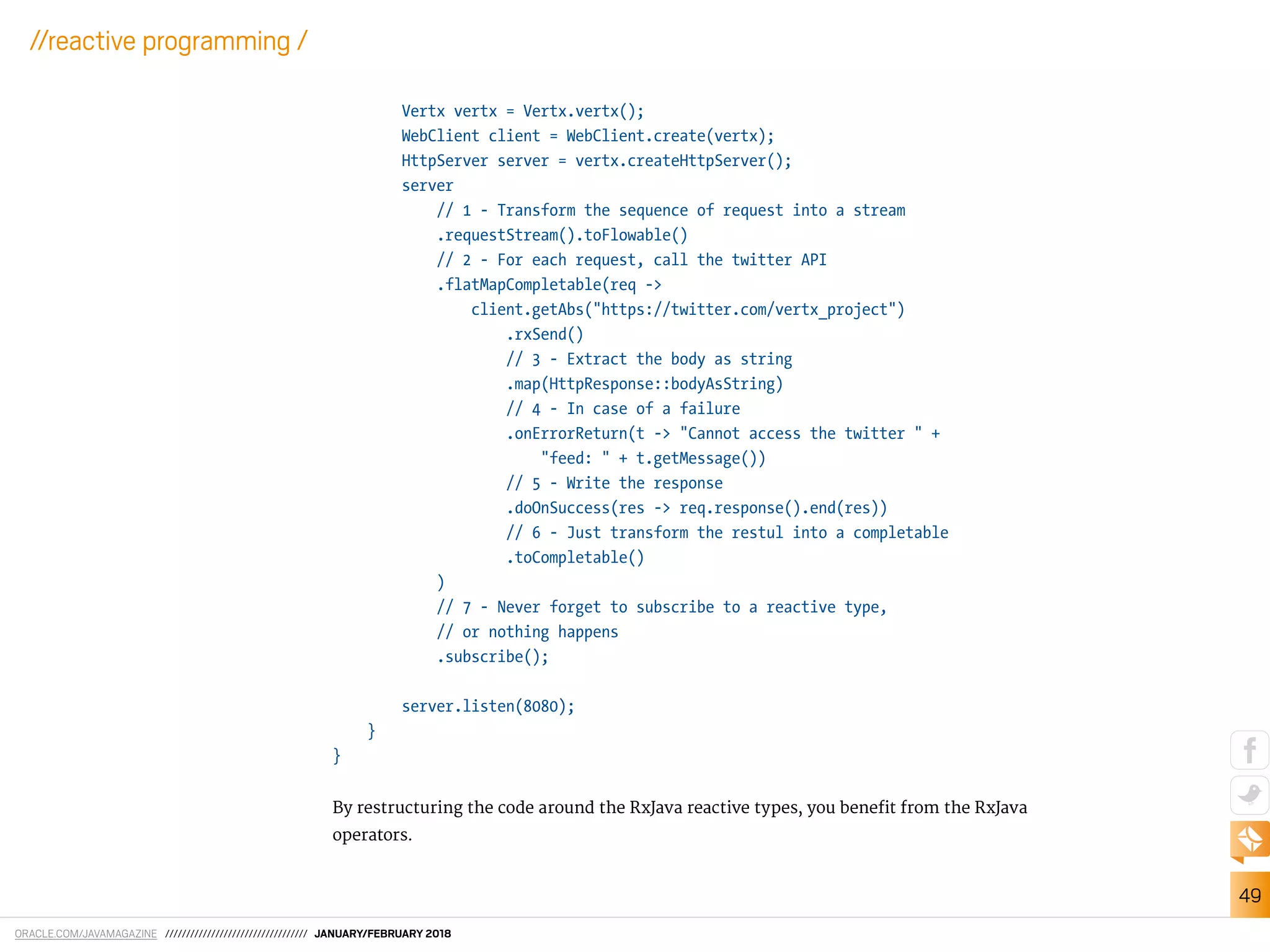
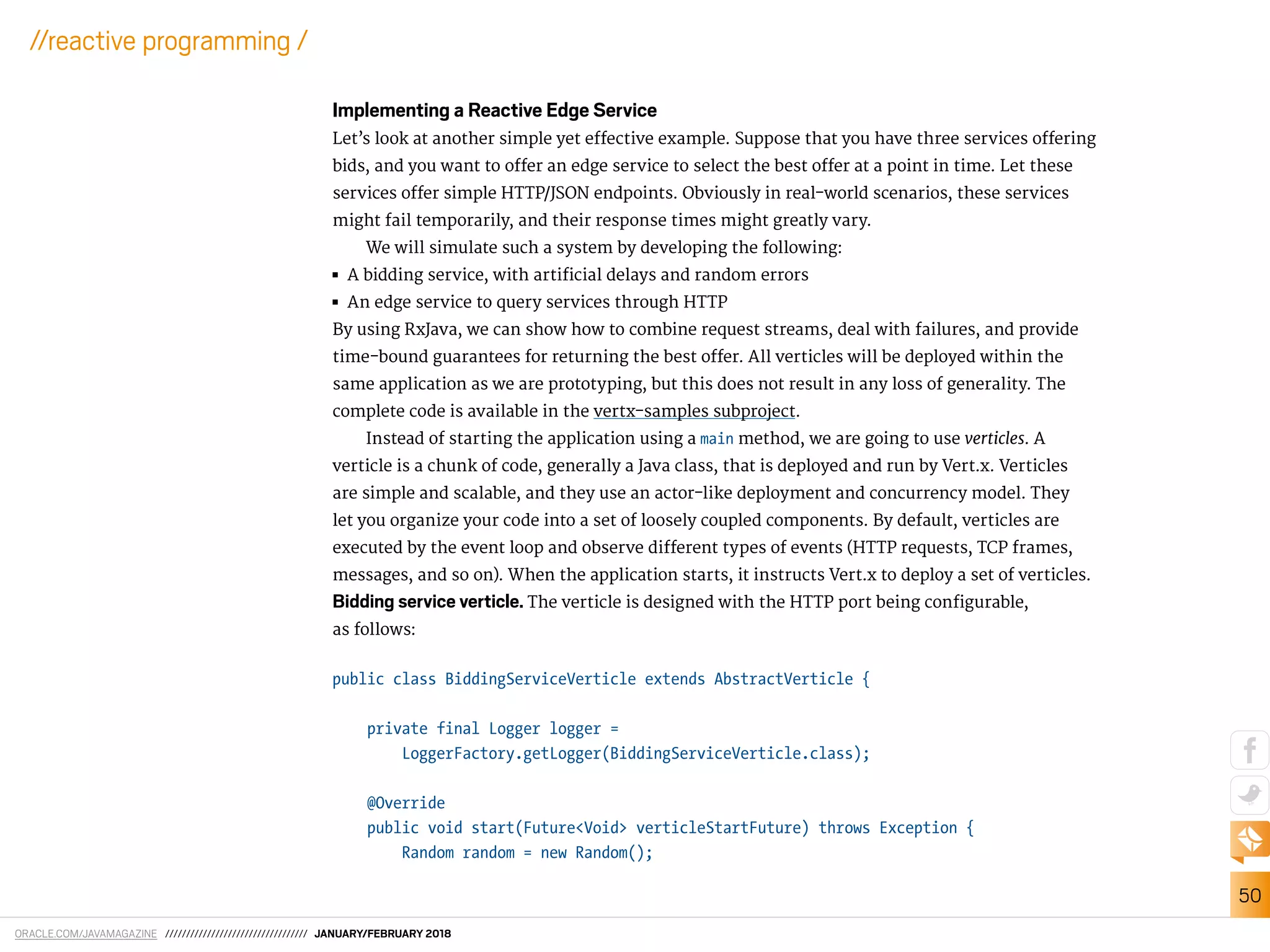

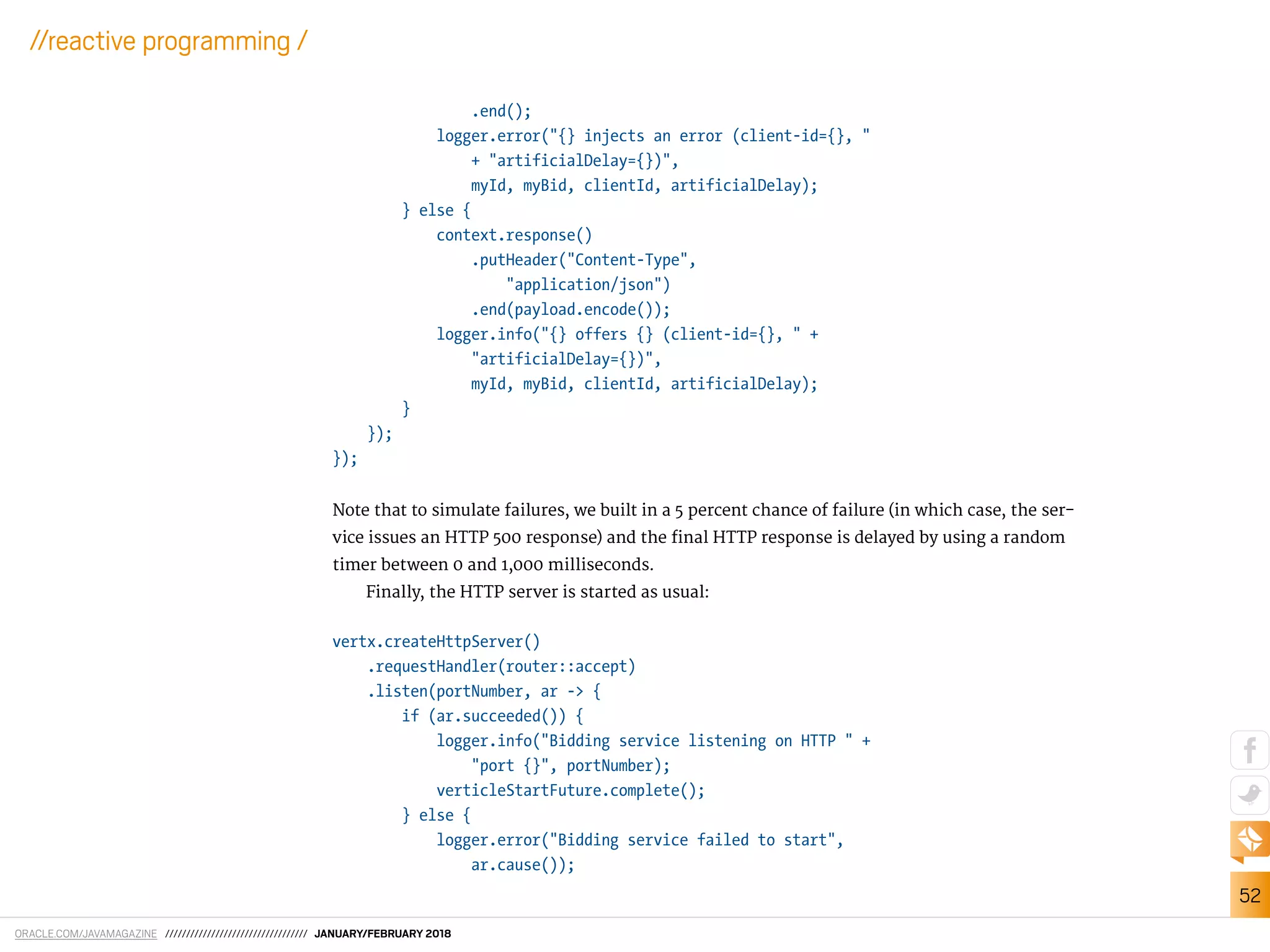

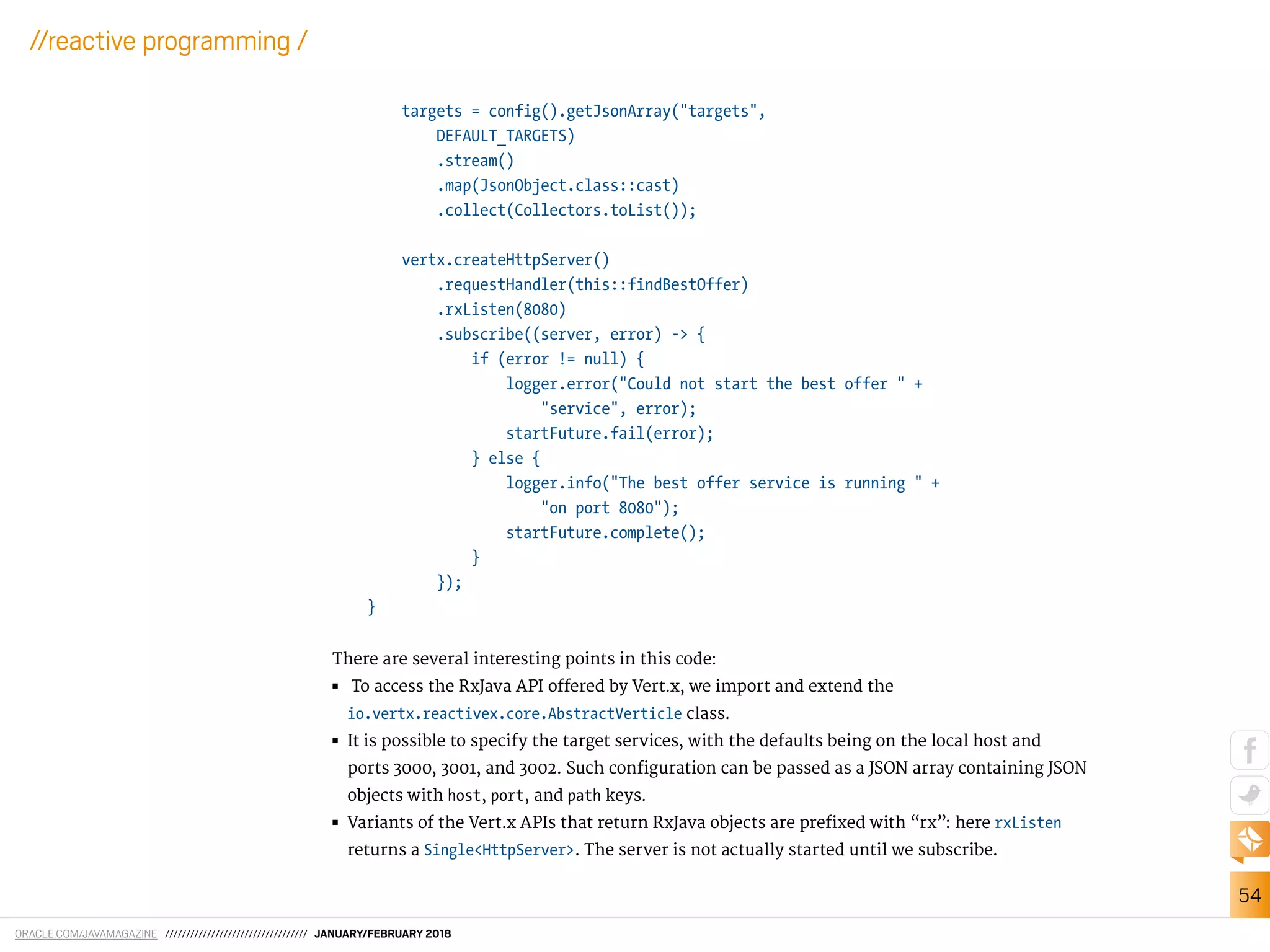
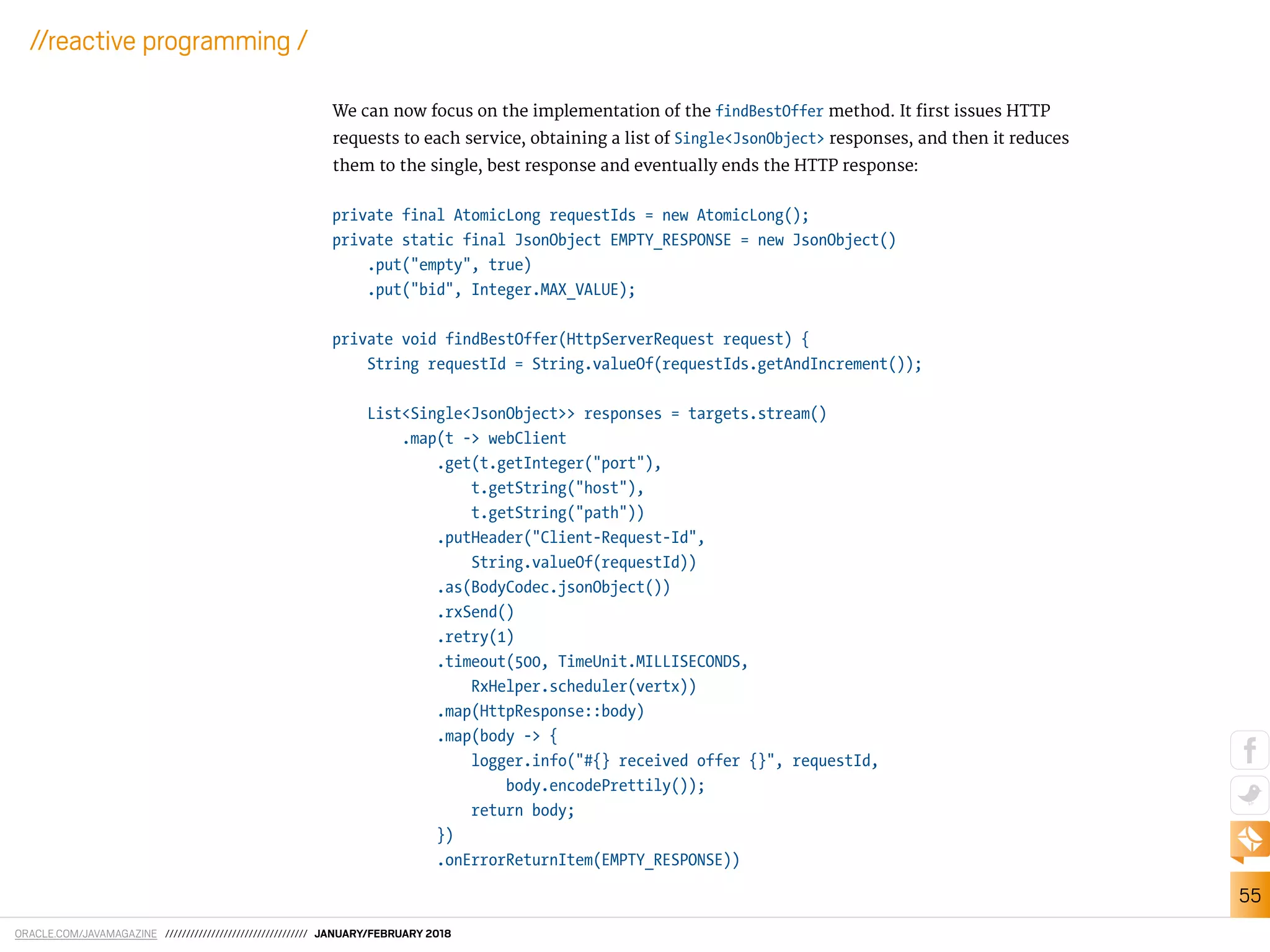
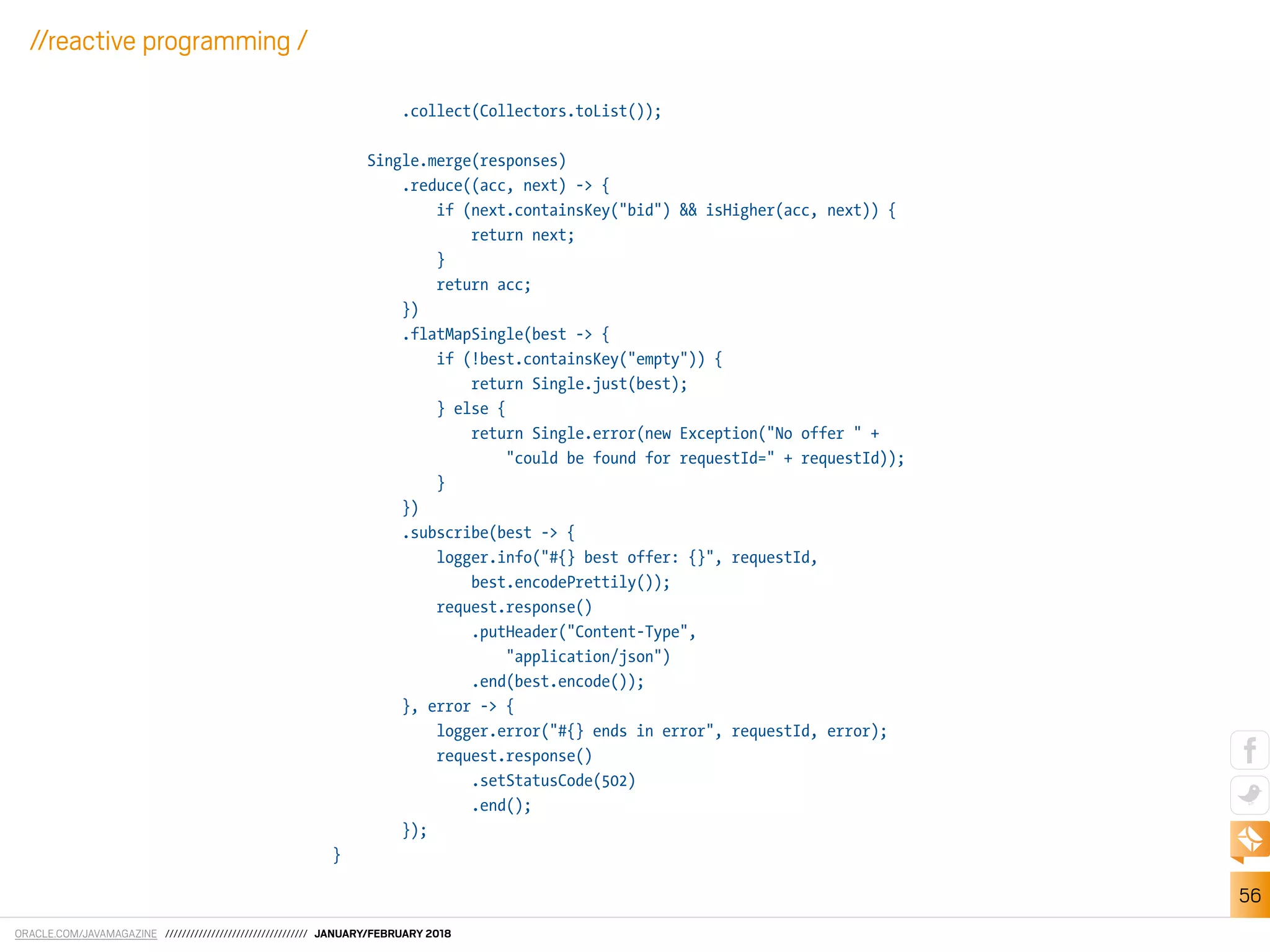
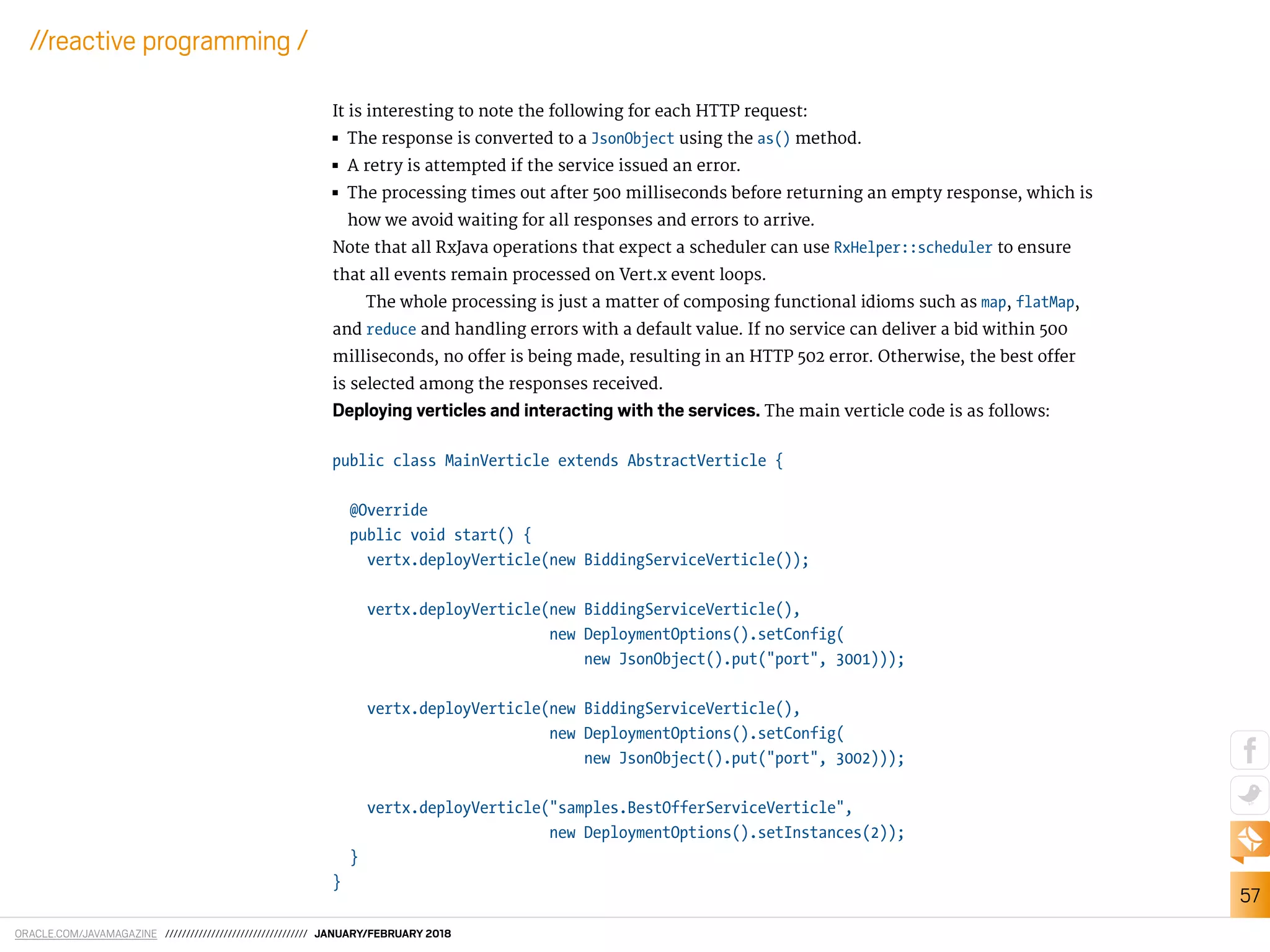
![ORACLE.COM/JAVAMAGAZINE ////////////////////////////////// JANUARY/FEBRUARY 2018
58
//reactive programming /
We deploy the bidding service three times on diferent ports to simulate three services, pass-
ing the HTTP port those services should listen on in the JSON coniguration. We also deploy
the edge service verticle with two instances to process the incoming traic on two CPU cores
rather than one. The two instances will listen on the same HTTP port, but note that there will
be no conlict because Vert.x distributes the traic in a round-robin fashion.
We can now interact with the HTTP services, for instance, by using the HTTPie command-
line tool. Let’s talk to the service on port 3000:
$ http GET localhost:3000/offer 'Client-Request-Id:1234' --verbose
GET /offer HTTP/1.1
Accept: */*
Accept-Encoding: gzip, deflate
Client-Request-Id: 1234
Connection: keep-alive
Host: localhost:3000
User-Agent: HTTPie/0.9.9
HTTP/1.1 200 OK
Content-Length: 83
Content-Type: application/json
{
"bid": 21,
"clientRequestId": "1234",
"origin": "fe299565-34be-4a7b-ac09-d88fcc1e42e2"
}
The logs reveal both artiicial delays and errors:
[INFO] 16:08:03.443 [vert.x-eventloop-thread-1] ERROR
samples.BiddingServiceVerticle -](https://image.slidesharecdn.com/javamagazinejanfeb2018-181010114542/75/Java-magazine-jan-feb-2018-59-2048.jpg)
![ORACLE.COM/JAVAMAGAZINE ////////////////////////////////// JANUARY/FEBRUARY 2018
59
//reactive programming /
6358300b-3f2d-40be-93db-789f0f1cde17 injects an error (
client-id=1234, artificialDelay=N/A)
[INFO] 16:11:10.644 [vert.x-eventloop-thread-1]
INFO samples.BiddingServiceVerticle -
6358300b-3f2d-40be-93db-789f0f1cde17 offers 10 (
client-id=1234, artificialDelay=934)
Similarly, you can play with the edge service, observe responses, and check the logs to see how
a response is being assembled. Sometimes you will get an error:
$ http GET localhost:8080 'Client-Request-Id:1234'
HTTP/1.1 502 Bad Gateway
Content-Length: 0
This is because all responses took longer than 500 milliseconds to arrive and some services
injected an error:
[INFO] 16:12:51.869 [vert.x-eventloop-thread-2]
INFO samples.BiddingServiceVerticle -
d803c4dd-1e9e-4f76-9029-770366e82615 offers 16 (
client-id=0, artificialDelay=656)
[INFO] 16:12:51.935 [vert.x-eventloop-thread-1]
INFO samples.BiddingServiceVerticle -
6358300b-3f2d-40be-93db-789f0f1cde17 offers 17 (
client-id=0, artificialDelay=724)
[INFO] 16:12:52.006 [vert.x-eventloop-thread-3]
INFO samples.BiddingServiceVerticle -
966e8334-4543-463e-8348-c6ead441c7da offers 14 (
client-id=0, artificialDelay=792)](https://image.slidesharecdn.com/javamagazinejanfeb2018-181010114542/75/Java-magazine-jan-feb-2018-60-2048.jpg)
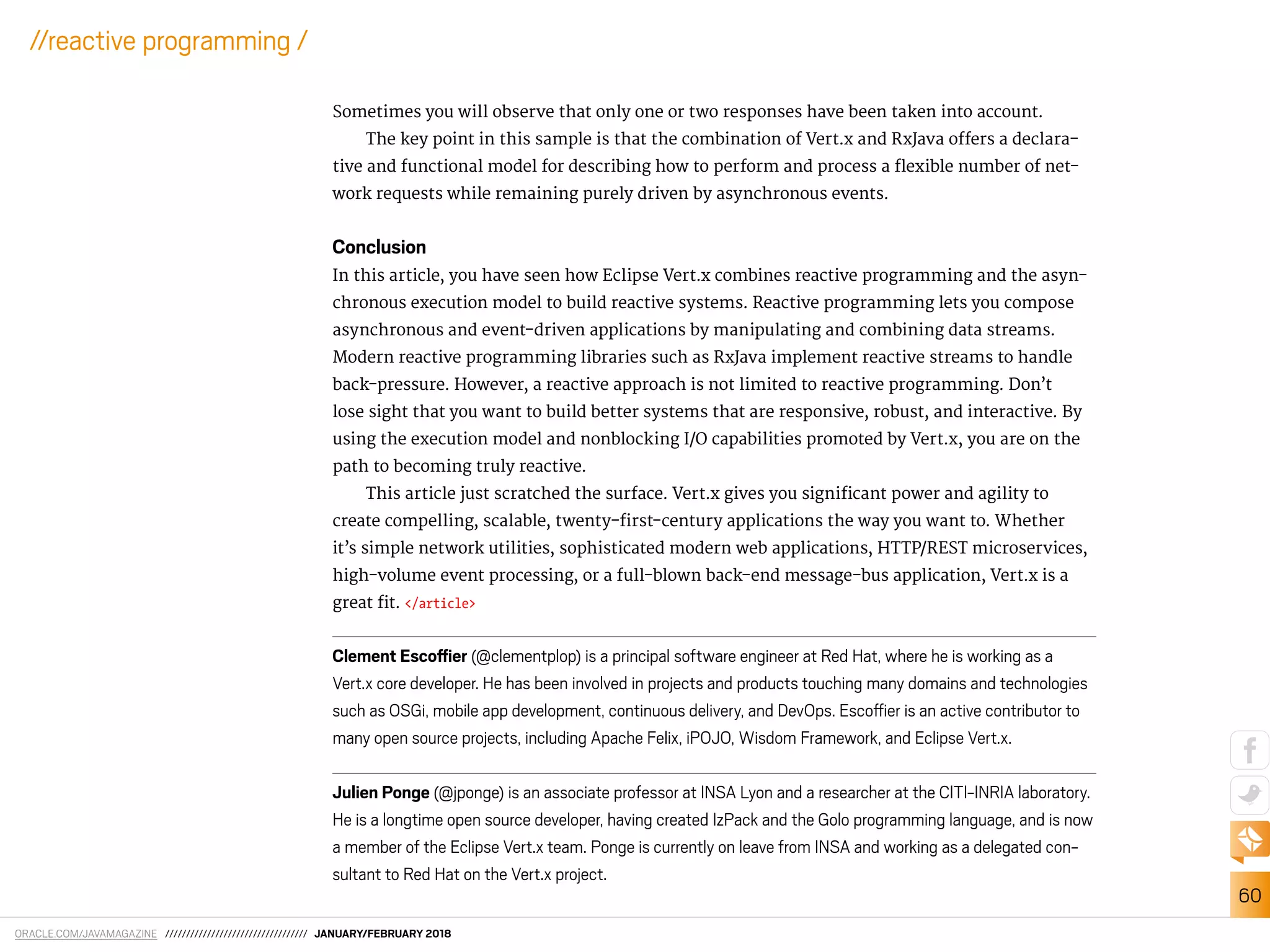
![ORACLE.COM/JAVAMAGAZINE ////////////////////////////////// JANUARY/FEBRUARY 2018
61
//reactive programming /
Reactive programming is an approach to writing software that embraces asynchronous I/O.
Asynchronous I/O is a small idea that portends big changes for software. The idea is simple:
alleviate ineicient resource utilization by using resources that would otherwise sit idle as they
waited for I/O activity. Asynchronous I/O inverts the normal design of I/O processing: clients are
notiied of new data instead of asking for it. This approach frees the client to do other things
while waiting for new notiications.
There is, of course, always the risk that too many notiications will overwhelm a client; so, a
client must be able to push back, rejecting work it can’t handle. This is a fundamental aspect of
low control in distributed systems. In reactive programming, the ability of the client to signal
how much work it can manage is called back-pressure.
Many projects, such as Akka Streams, Vert.x, and RxJava, support reactive programming.
[Vert.x and RxJava are examined in detail in the accompanying article, “Going Reactive with
Eclipse Vert.x and RxJava,” on page 32. —Ed.] The Spring team has a project called Reactor,
which provides reactive capabilities for the Spring Framework. There’s common ground across
these diferent approaches, which has been summarized in the Reactive Streams initiative—an
informal standard of sorts.
The Fundamental Data Types
The Reactive Streams initiative deines four data types. Publisher is a producer of values that
might eventually arrive. A Publisher produces values of type T, as shown in Listing 1.
Reactive Spring
Proceeding from fundamentals, use the Spring Framework to quickly build
a reactive application.
JOSHLONG](https://image.slidesharecdn.com/javamagazinejanfeb2018-181010114542/75/Java-magazine-jan-feb-2018-62-2048.jpg)
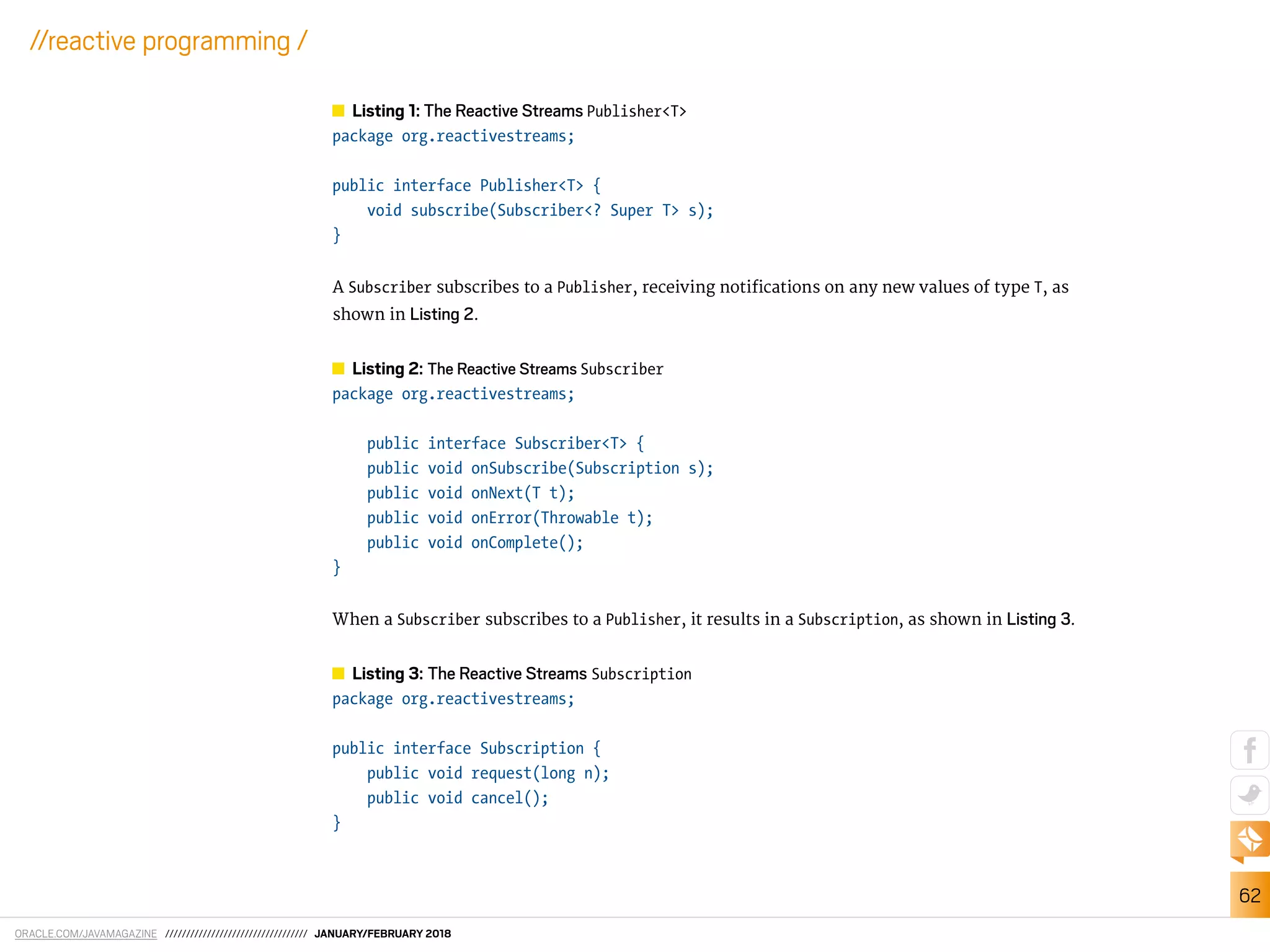
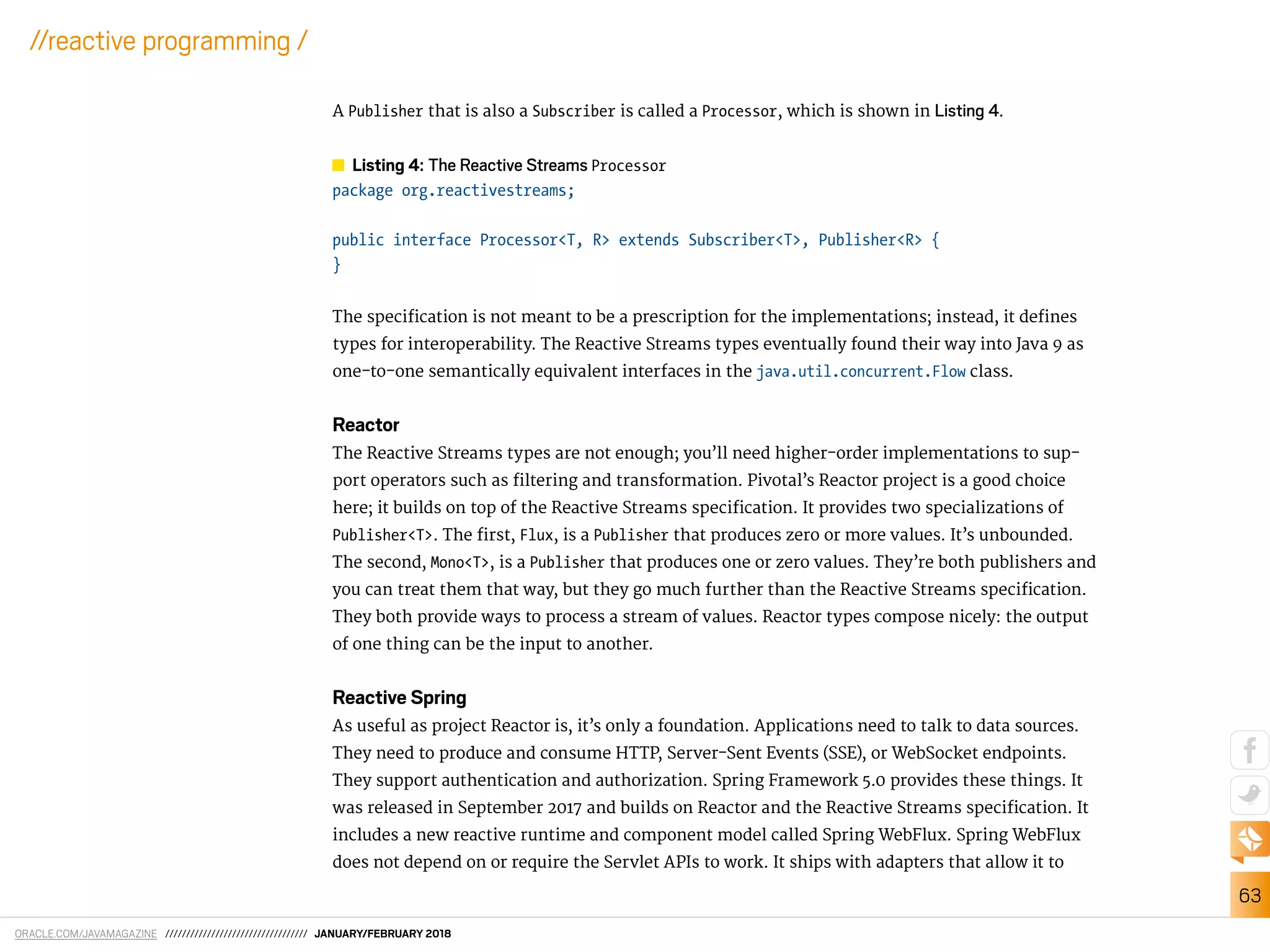
![ORACLE.COM/JAVAMAGAZINE ////////////////////////////////// JANUARY/FEBRUARY 2018
64
//reactive programming /
work on top of a servlet engine, if need be, but that is not required. It also provides a Netty-
based web server. Spring Framework 5, which works with a baseline of Java 8 and Java EE 7, is
the foundation for changes in much of the Spring ecosystem. Let’s look at an example.
Example Application
Let’s build a simple Spring Boot 2.0 application that represents a service to manage books. You
could call the project Library or something like that. Go to the Spring Initializr. Make sure that
some version of Spring Boot 2.0 (or later) is selected in the version drop-down menu. You’re
writing a service to manage access to books in the library, so give this project the artifact ID
library-service. Select the elements you’ll need: Reactive Web, Actuator, Reactive MongoDB,
Reactive Security, and Lombok.
I often use the Kotlin language, even if most of the project I am building is in Java. I keep
Java artifacts collocated in a Kotlin project. Click Generate and it’ll download an archive. Unzip
it and open it in your favorite IDE that supports Java 8 (or later), Kotlin (optionally), and Maven.
While you could have chosen Gradle in the Spring Initializr, I chose Maven for the purposes
of this article. The stock standard Spring Boot application has an entry class that looks like
Listing 5.
Listing 5: The empty husk of a new Spring Boot project
package com.example.libraryservice;
import org.springframework.boot.SpringApplication;
import org.springframework.boot.autoconfigure.SpringBootApplication;
@SpringBootApplication public class LibraryServiceApplication {
public static void main(String[] args) {
System.setProperty("spring.profiles.active",
"security,authorization,frpjava");
SpringApplication.run(LibraryServiceApplication.class, args);](https://image.slidesharecdn.com/javamagazinejanfeb2018-181010114542/75/Java-magazine-jan-feb-2018-65-2048.jpg)
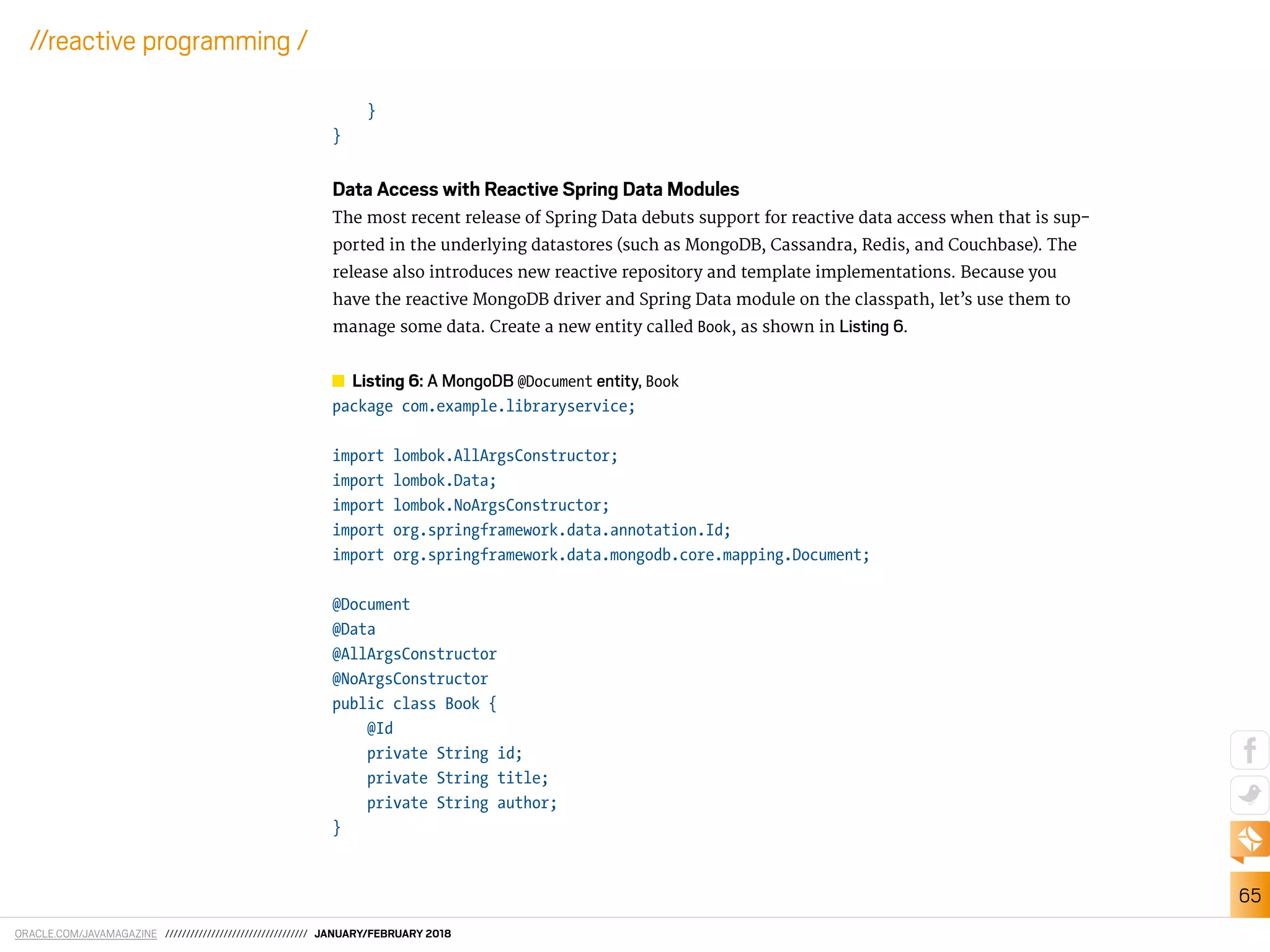
![ORACLE.COM/JAVAMAGAZINE ////////////////////////////////// JANUARY/FEBRUARY 2018
66
//reactive programming /
Next, create a Spring Data repository to support the data management lifecycle of the entity.
This should look very familiar to anyone who has ever used Spring Data, except that the reposi-
tory supports reactive interactions: methods return Publisher types, and input can be given as
Publisher instances. See Listing 7.
Listing 7: A reactive Spring Data MongoDB repository
package com.example.libraryservice;
import org.springframework.data.mongodb.repository.ReactiveMongoRepository;
import reactor.core.publisher.Flux;
public interface BookRepository extends ReactiveMongoRepository {
Flux findByAuthor(String author);
}
Install Some Sample Data
With that, you now have enough to install some sample data (just for your demo). Spring
Boot invokes the #run(ApplicationArguments) method when the application has started,
passing wrappers for the arguments (String [] args) into the application. Let’s create an
ApplicationRunner that deletes all the data in the data source, then emits a few book titles, then
maps them to Book entities, and then persists those books. Finally, it queries all the records in
the data source and then prints out everything. Listing 8 shows all this.
Listing 8: An ApplicationRunner to write data
package com.example.libraryservice;
import lombok.extern.slf4j.Slf4j;
import org.springframework.boot.ApplicationArguments;
import org.springframework.boot.ApplicationRunner;](https://image.slidesharecdn.com/javamagazinejanfeb2018-181010114542/75/Java-magazine-jan-feb-2018-67-2048.jpg)
![ORACLE.COM/JAVAMAGAZINE ////////////////////////////////// JANUARY/FEBRUARY 2018
67
//reactive programming /
import org.springframework.stereotype.Component;
import reactor.core.publisher.Flux;
@Slf4j
@Component
class SampleBookInitializer implements ApplicationRunner {
private final BookRepository bookRepository;
SampleBookInitializer(BookRepository bookRepository) {
this.bookRepository = bookRepository;
}
@Override
public void run(ApplicationArguments args) throws Exception {
this.bookRepository
.deleteAll()
.thenMany(
Flux.just(
"Cloud Native Java|jlong",
"Spring Security 3.1|rwinch",
"Spring in Action|cwalls"))
.map(t -> t.split("|"))
.map(tuple -> new Book(null, tuple[0], tuple[1]))
.flatMap(this.bookRepository::save)
.thenMany(this.bookRepository.findAll())
.subscribe(book -> log.info(book.toString()));
}
}
The example looks at the titles of various books and one of the (possibly numerous) books’
authors, and then it writes them to the database. First the strings are split by the | delimiter.](https://image.slidesharecdn.com/javamagazinejanfeb2018-181010114542/75/Java-magazine-jan-feb-2018-68-2048.jpg)
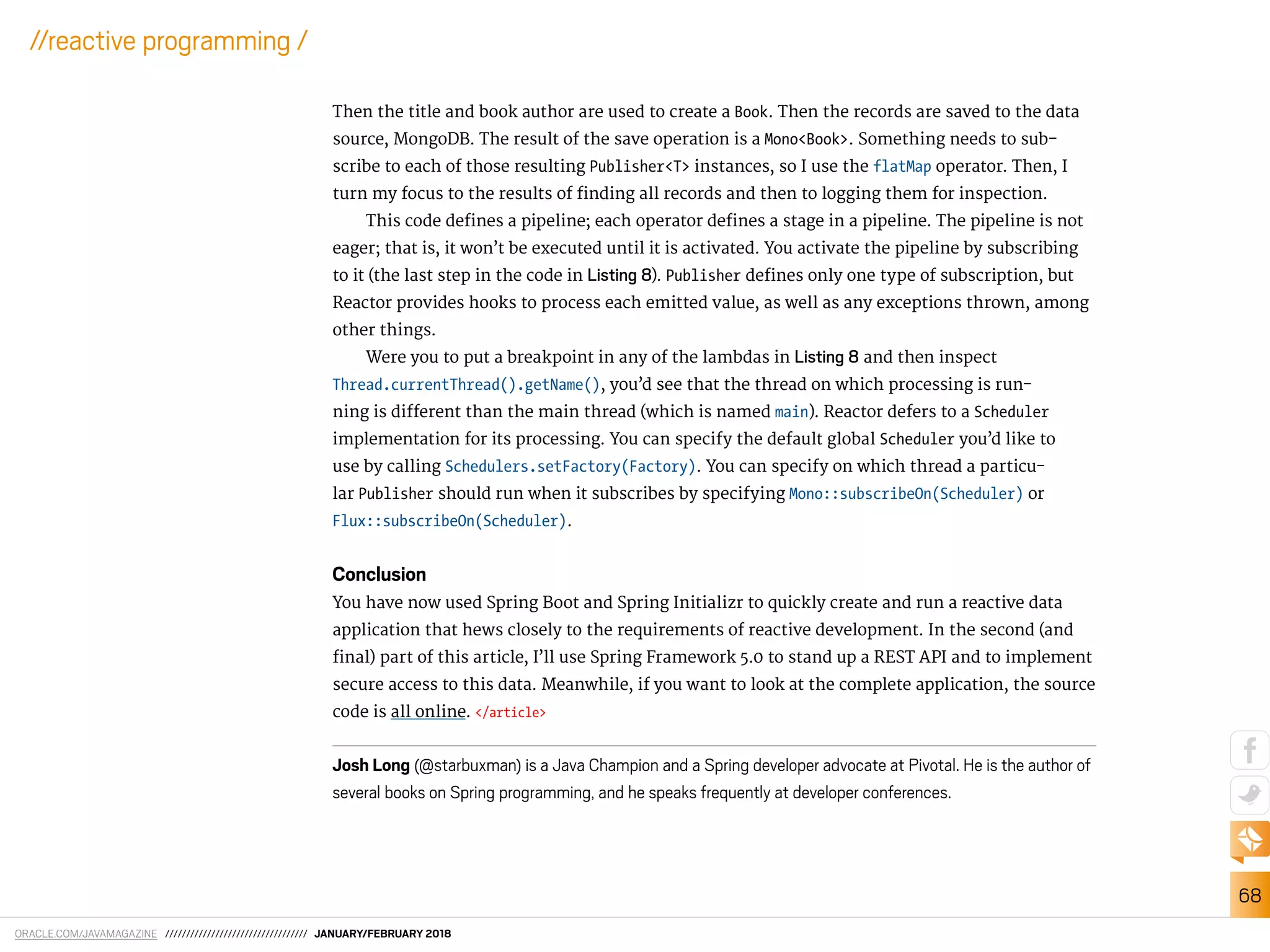
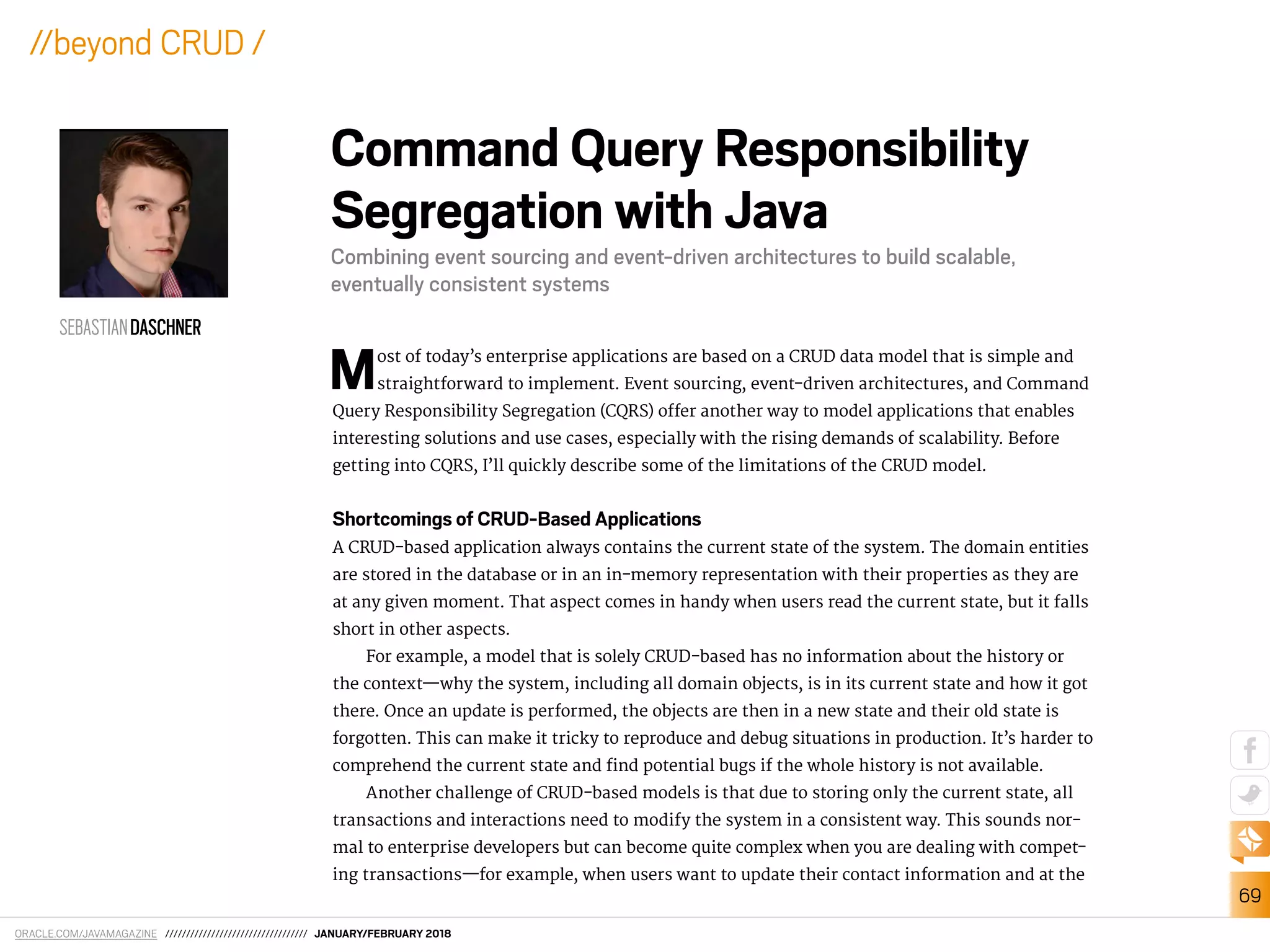
![ORACLE.COM/JAVAMAGAZINE ////////////////////////////////// JANUARY/FEBRUARY 2018
70
//beyond CRUD /
same time some other use case updates their
account balance. If this information afects the
same database entries, the two activities lead
to a locking situation. Usually, this optimis-
tic locking results in one transaction winning
over the other. However, strictly speaking,
there should be no need to mutually exclude
either transaction.
A similar problem occurs when a use case updates business objects whose new states
require veriication to keep the system in a consistent state. Verifying and maintaining these
consistent states can become both redundant and complex.
Because CRUD-based applications need to store the status quo and keep a consistent state
within their data model, they cannot scale horizontally. To maintain consistency, such applica-
tions need to lock the data (as in good old atomicity, consistency, isolation, and durability [ACID]
transactions) until the update has taken place. If several distributed systems are involved, the
synchronization will become a bottleneck.
Event Sourcing
In contrast to a CRUD data model, event-sourced systems store all modiications that happen to
a system as atomic entities. The application does not necessarily contain the current state, but
it can be calculated by applying all events that have happened in the past. These events are the
single source of truth in the system.
The most prominent example for this model is bank accounts. You can calculate your cur-
rent balance by starting at zero and adding or subtracting the amounts of all transactions
accordingly. The example in Figure 1 shows a simple set of customer-related events that can be
used to arrive at a customer representation.
The events are atomic and immutable, because they happened in the past and cannot be
undone. This implies that, for example, a deletion action also changes the current state by just
adding a CustomerDeleted event to the log—no entry is actually deleted.
Becausetherealworldisallabout
distributedcollaboration—ofteninan
asynchronousway—itmakessensetomodel
applicationsinanevent-drivenway.](https://image.slidesharecdn.com/javamagazinejanfeb2018-181010114542/75/Java-magazine-jan-feb-2018-71-2048.jpg)
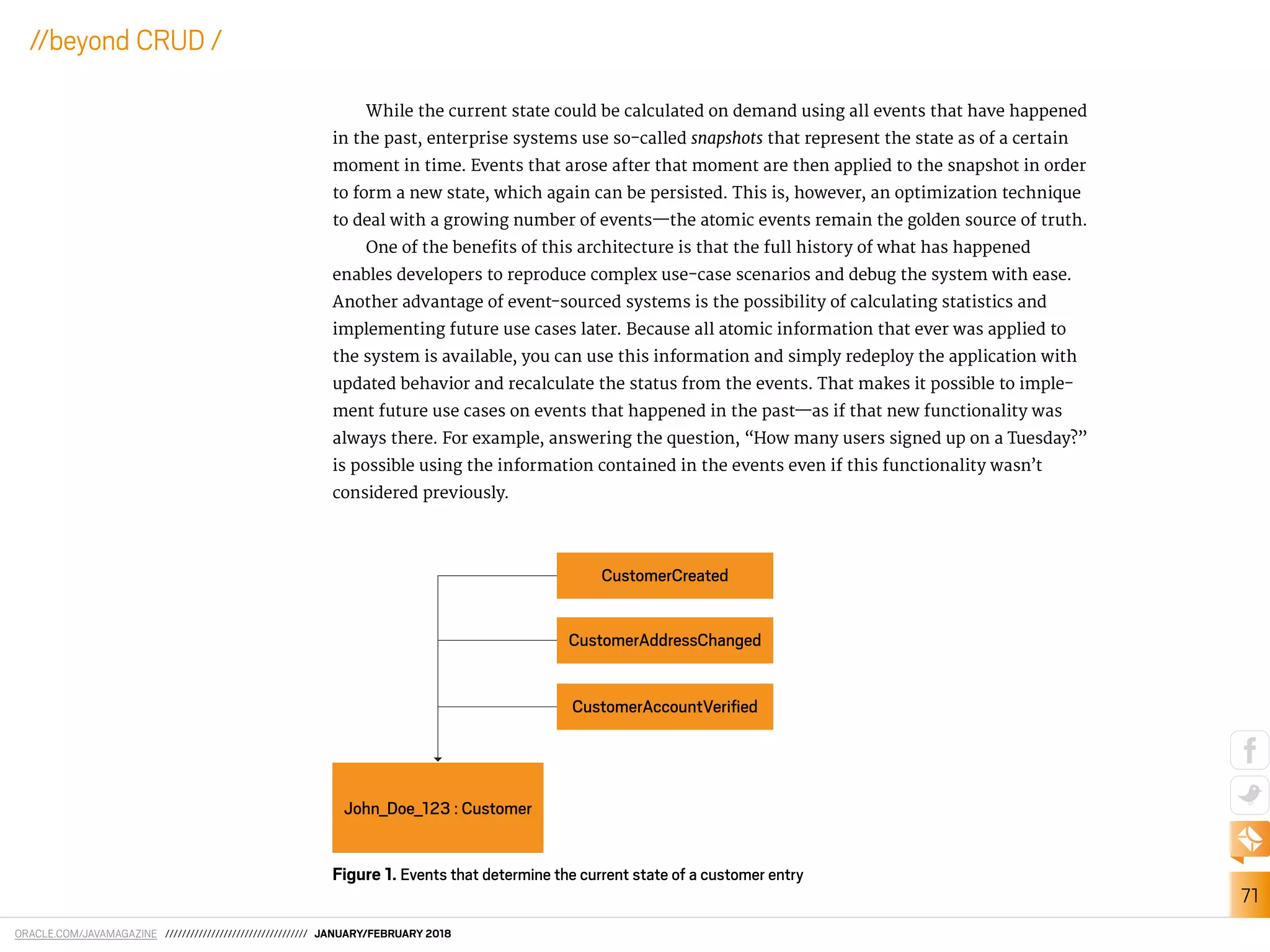
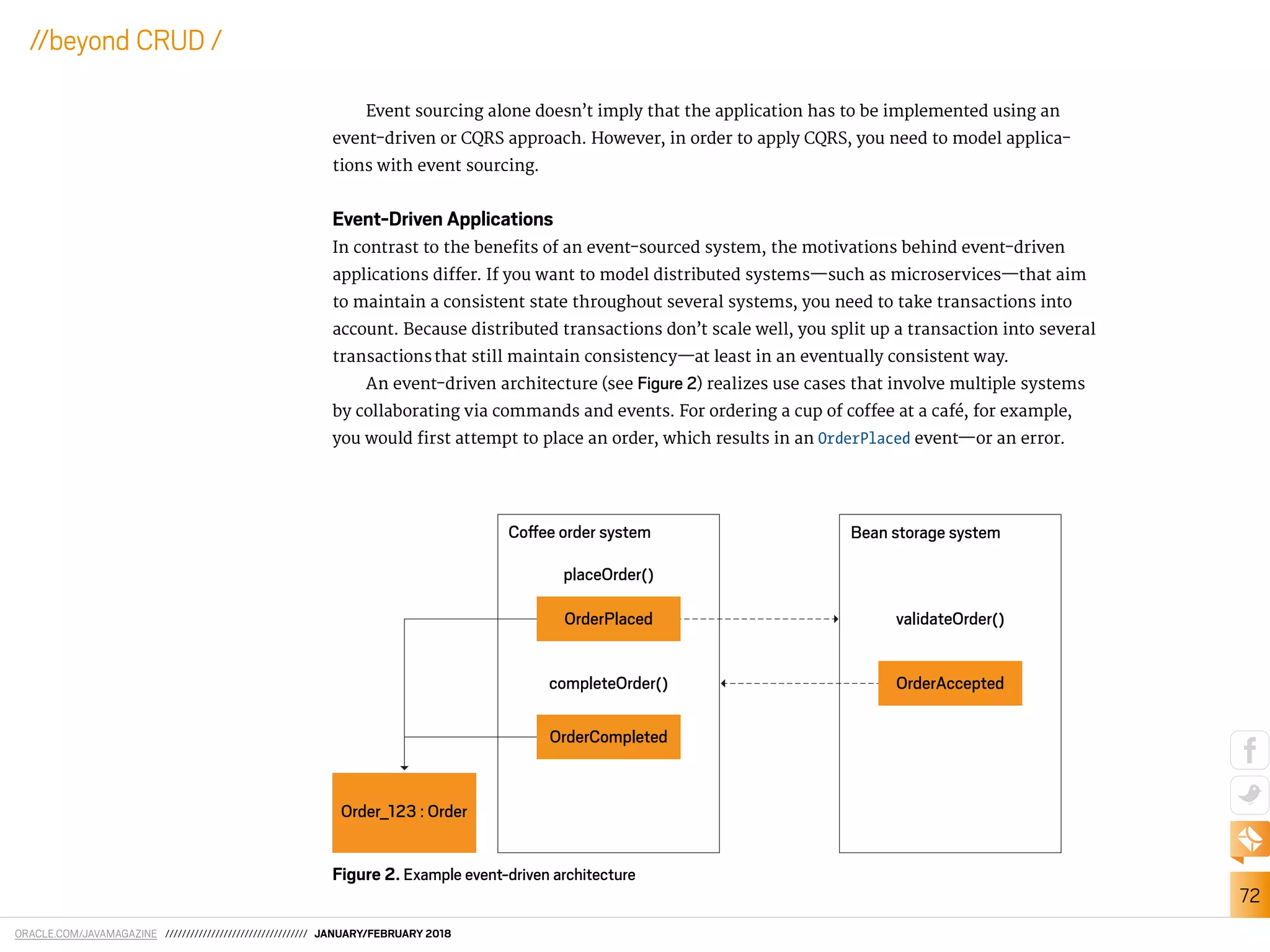
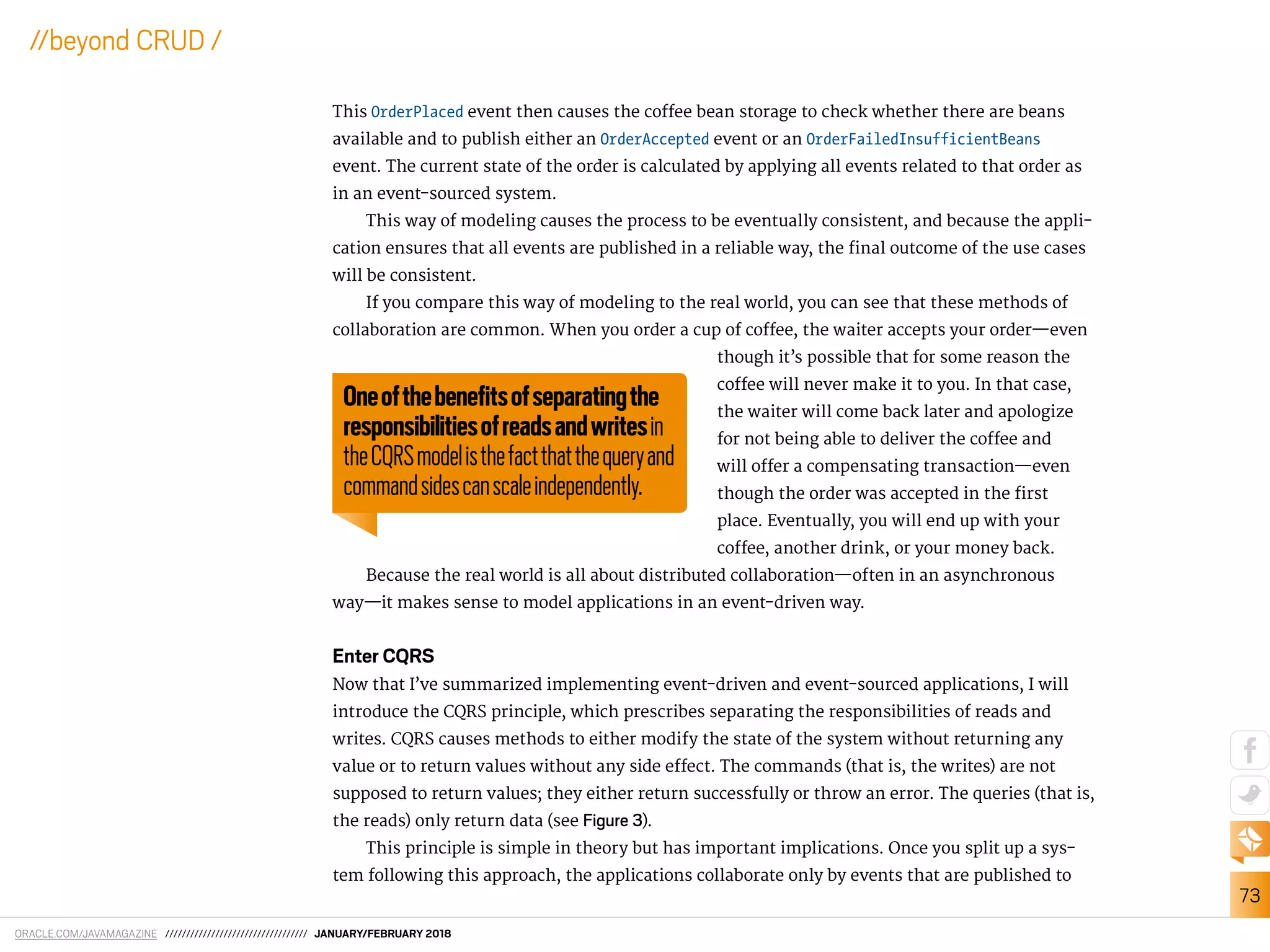

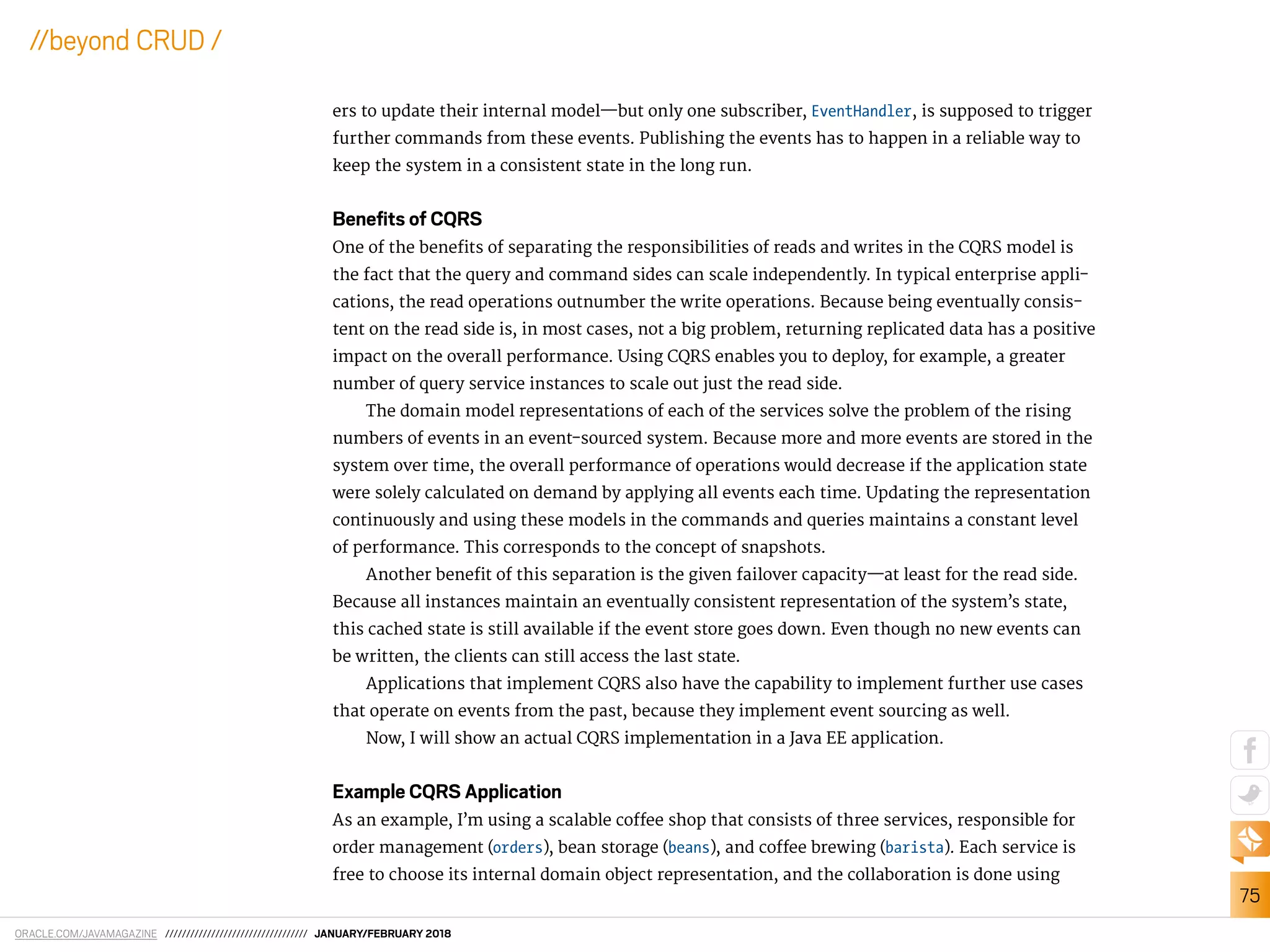
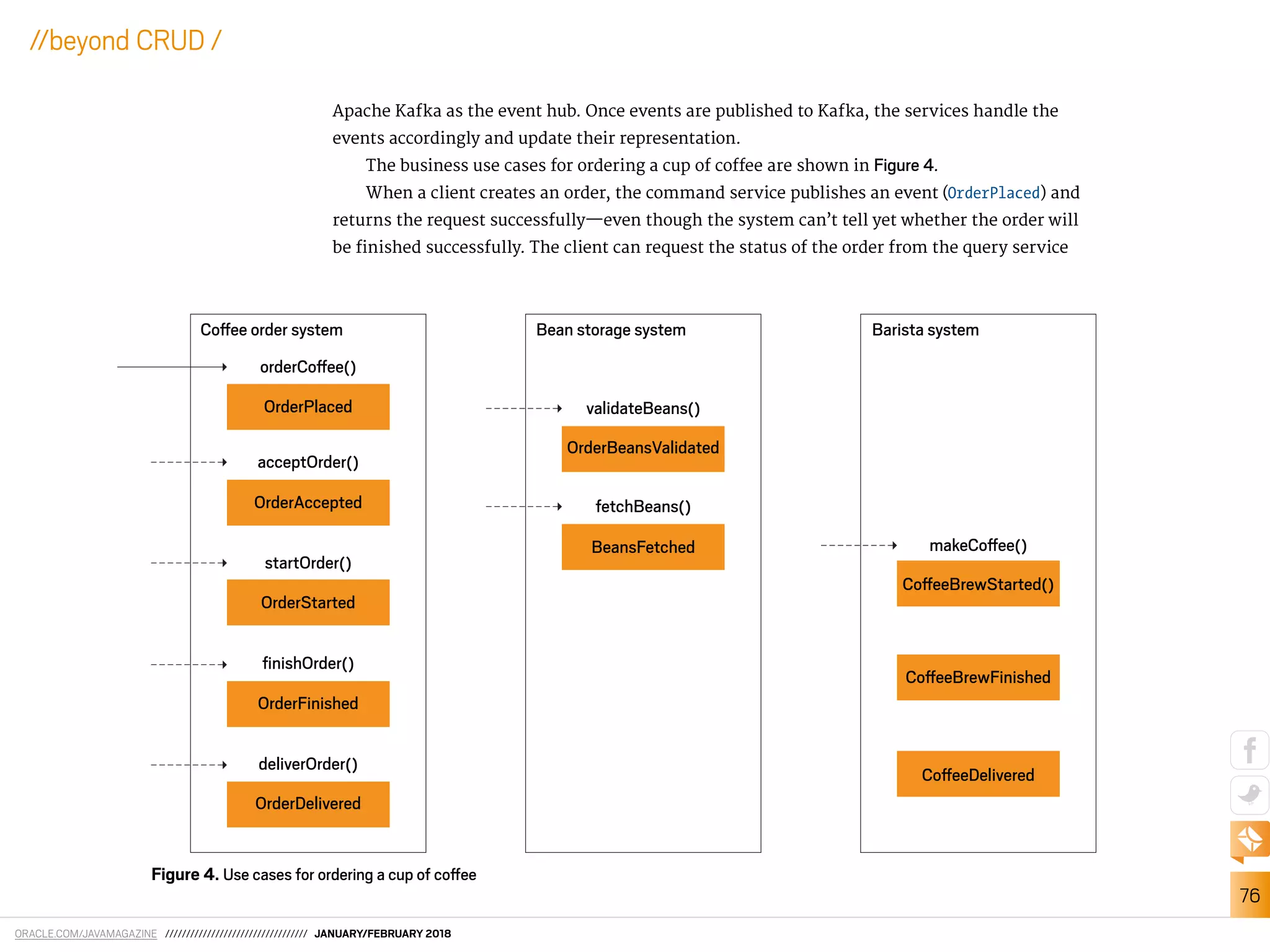
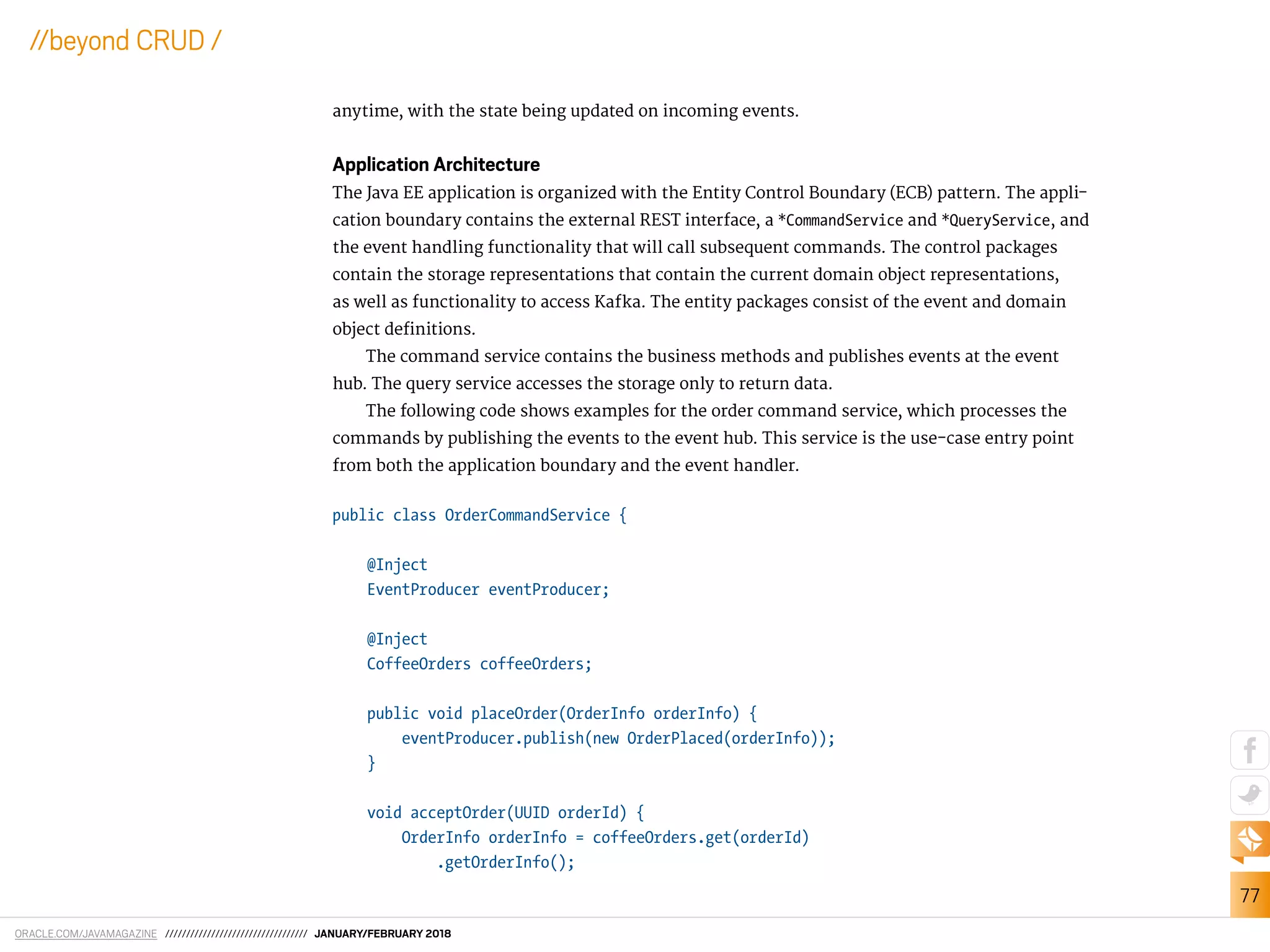


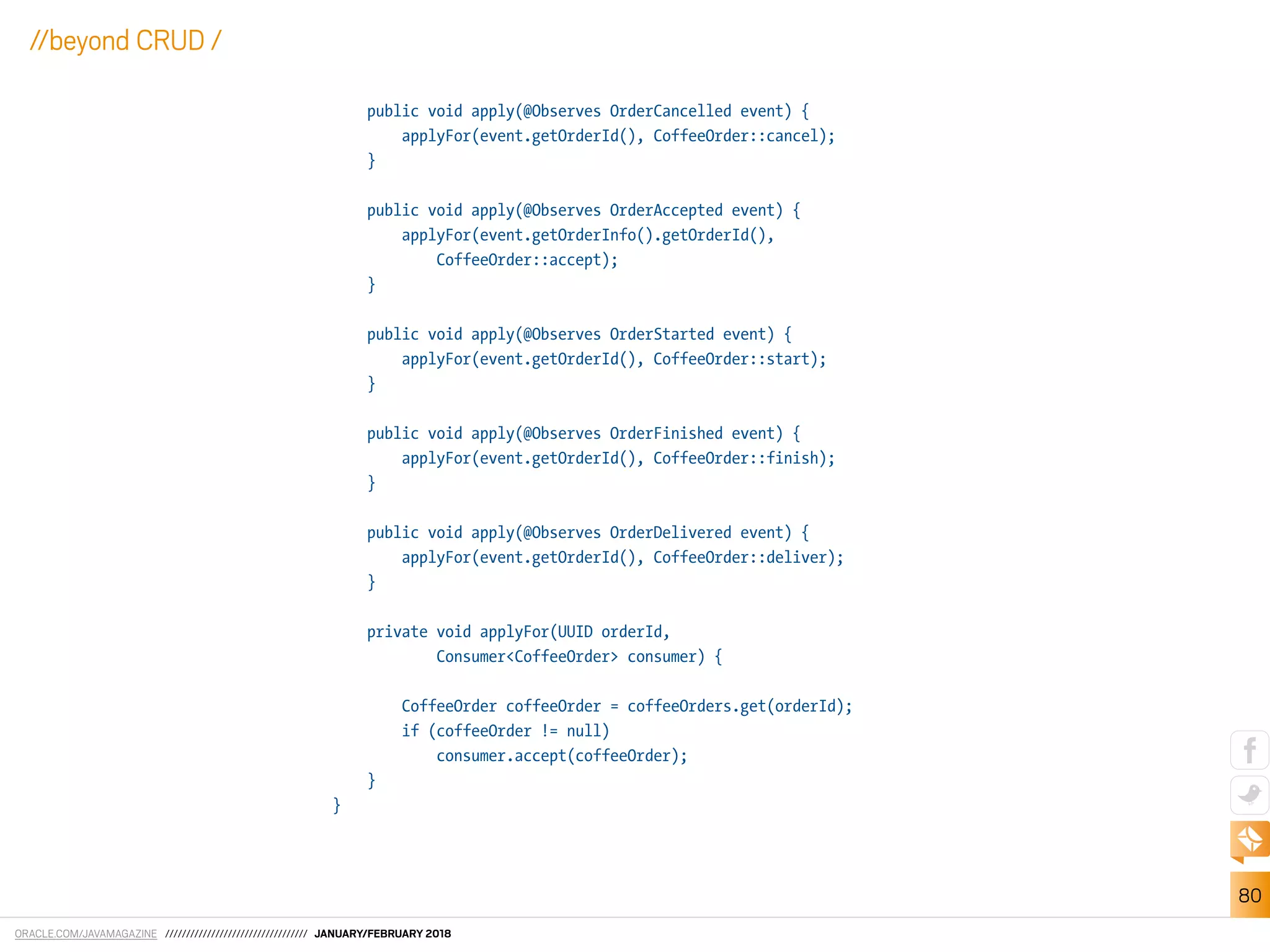

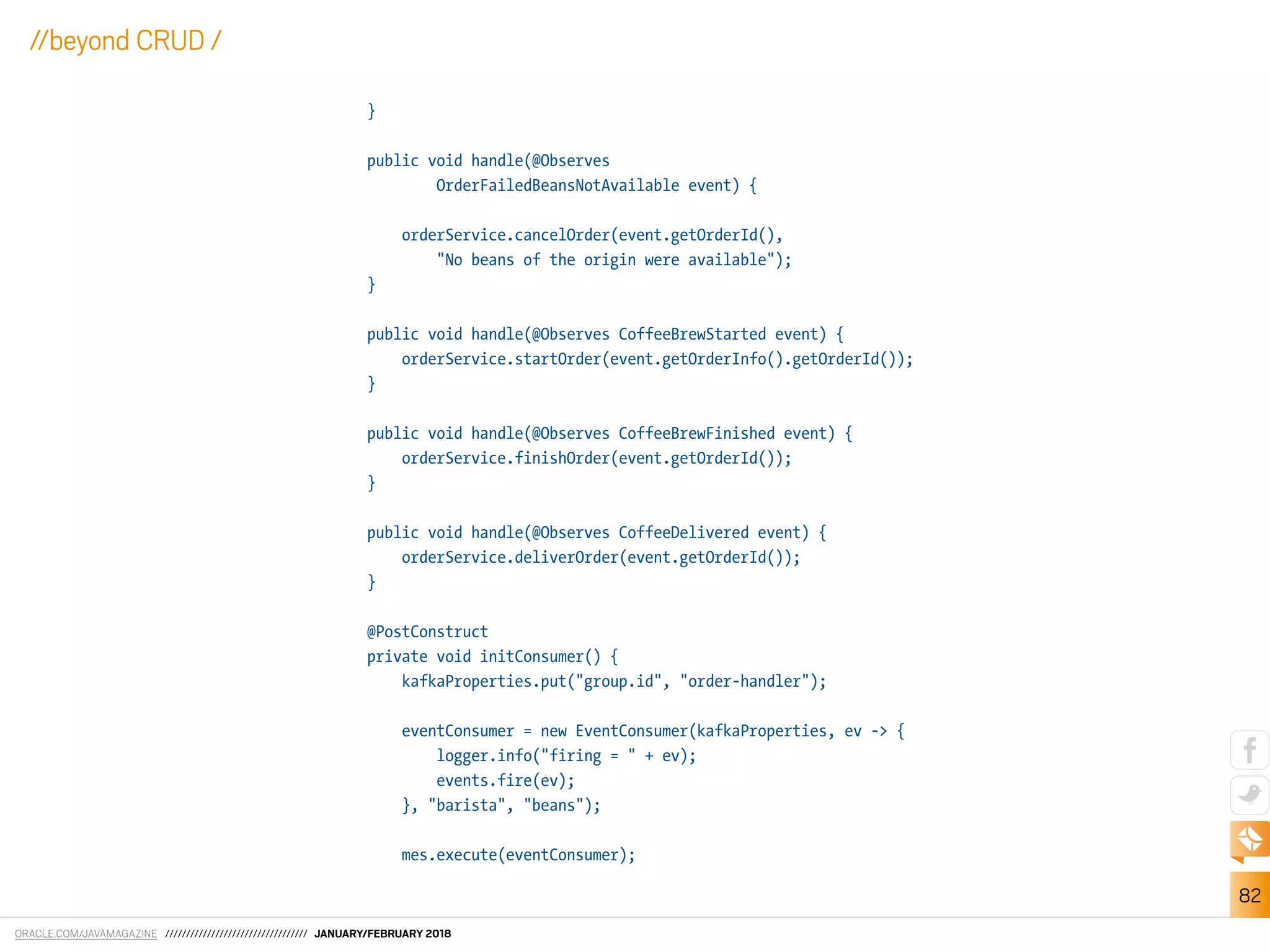
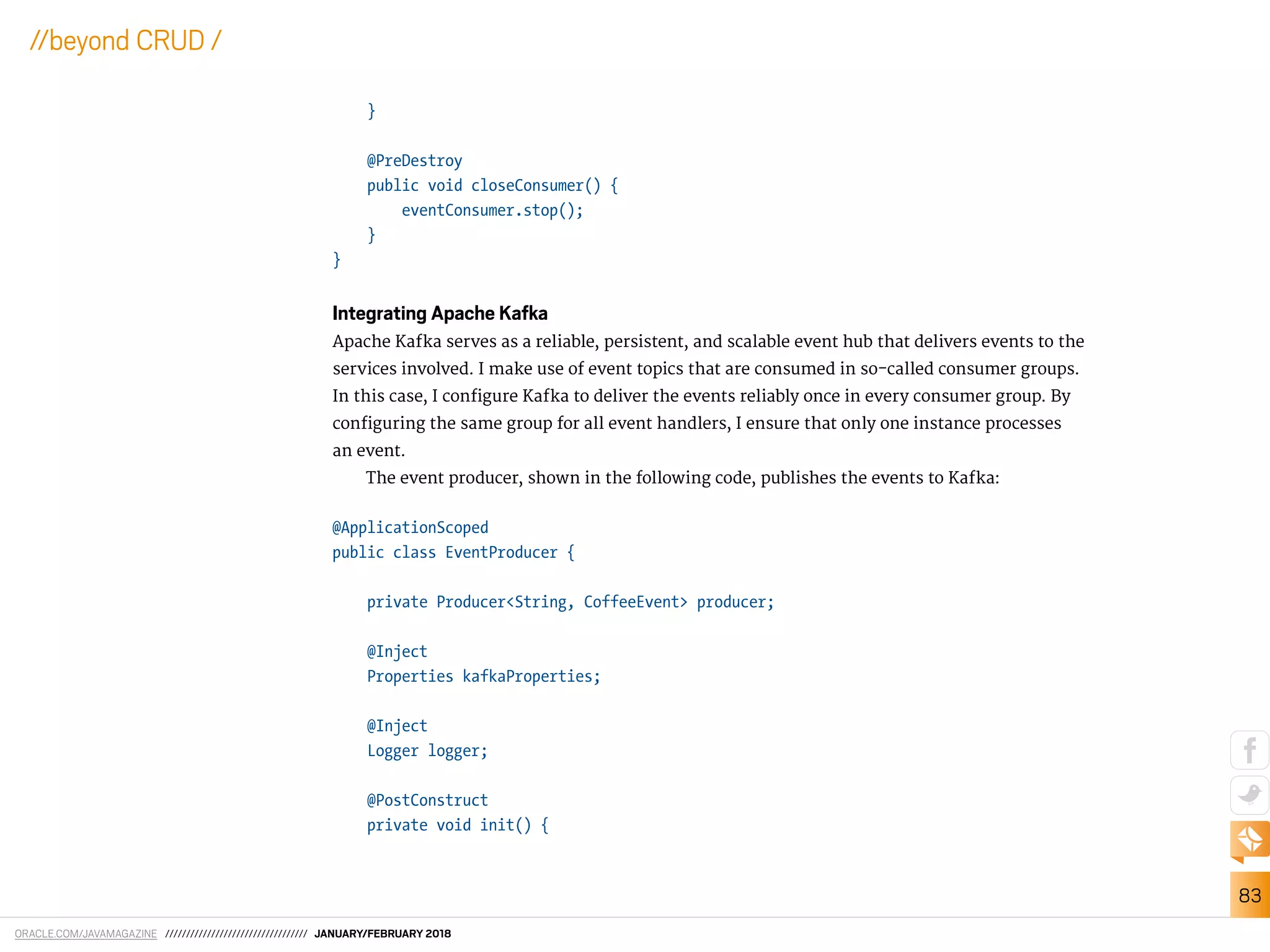
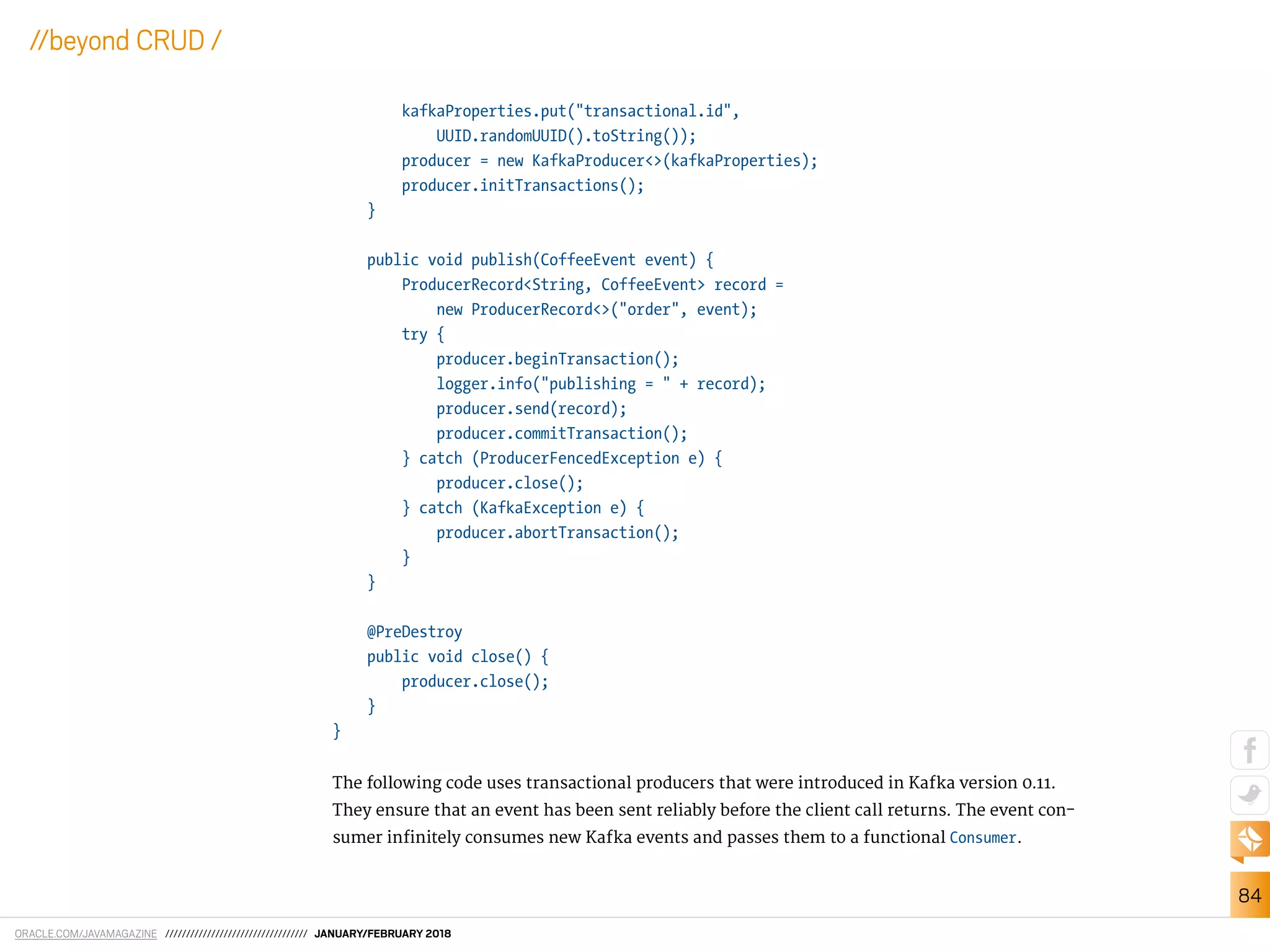
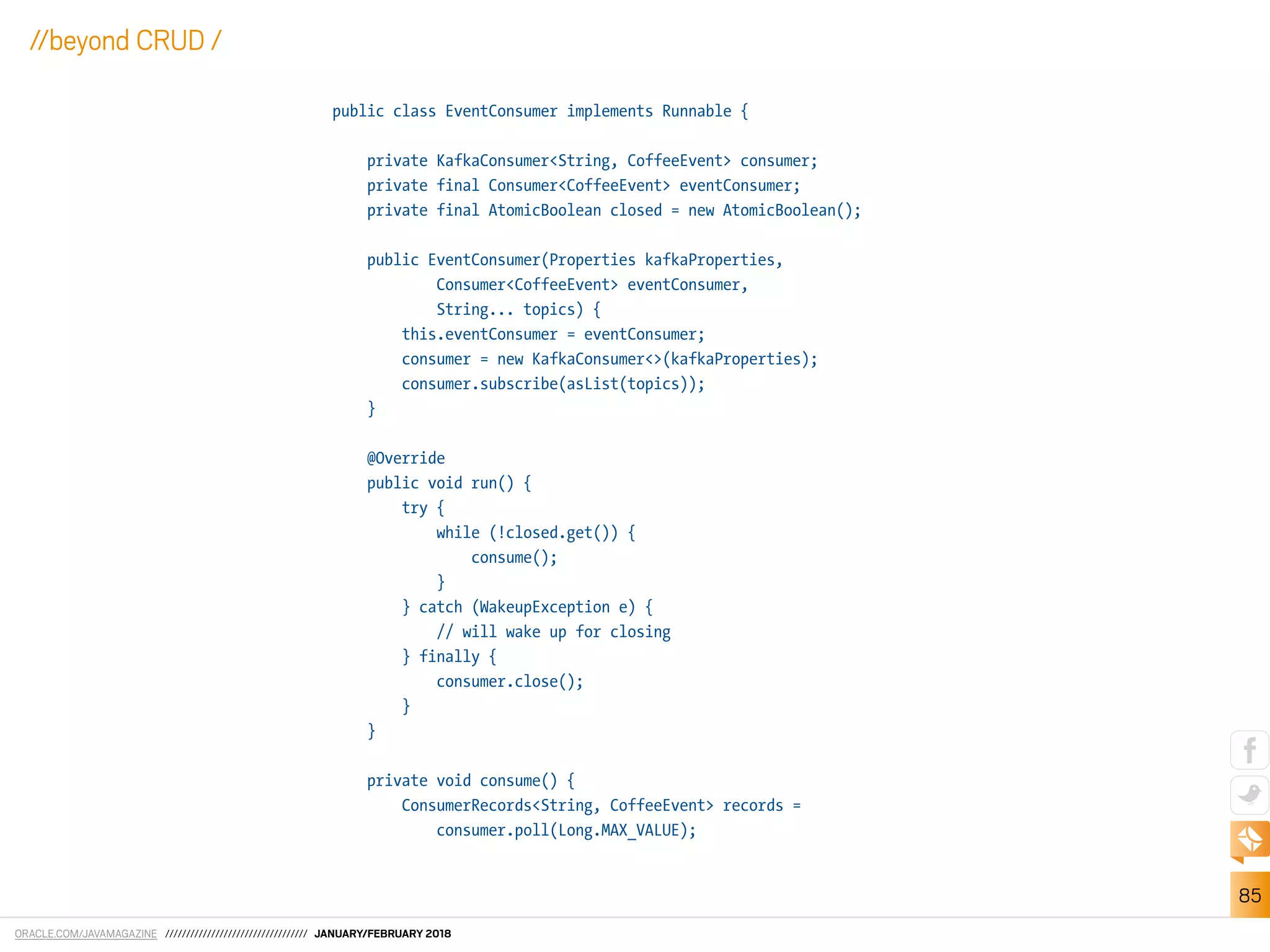
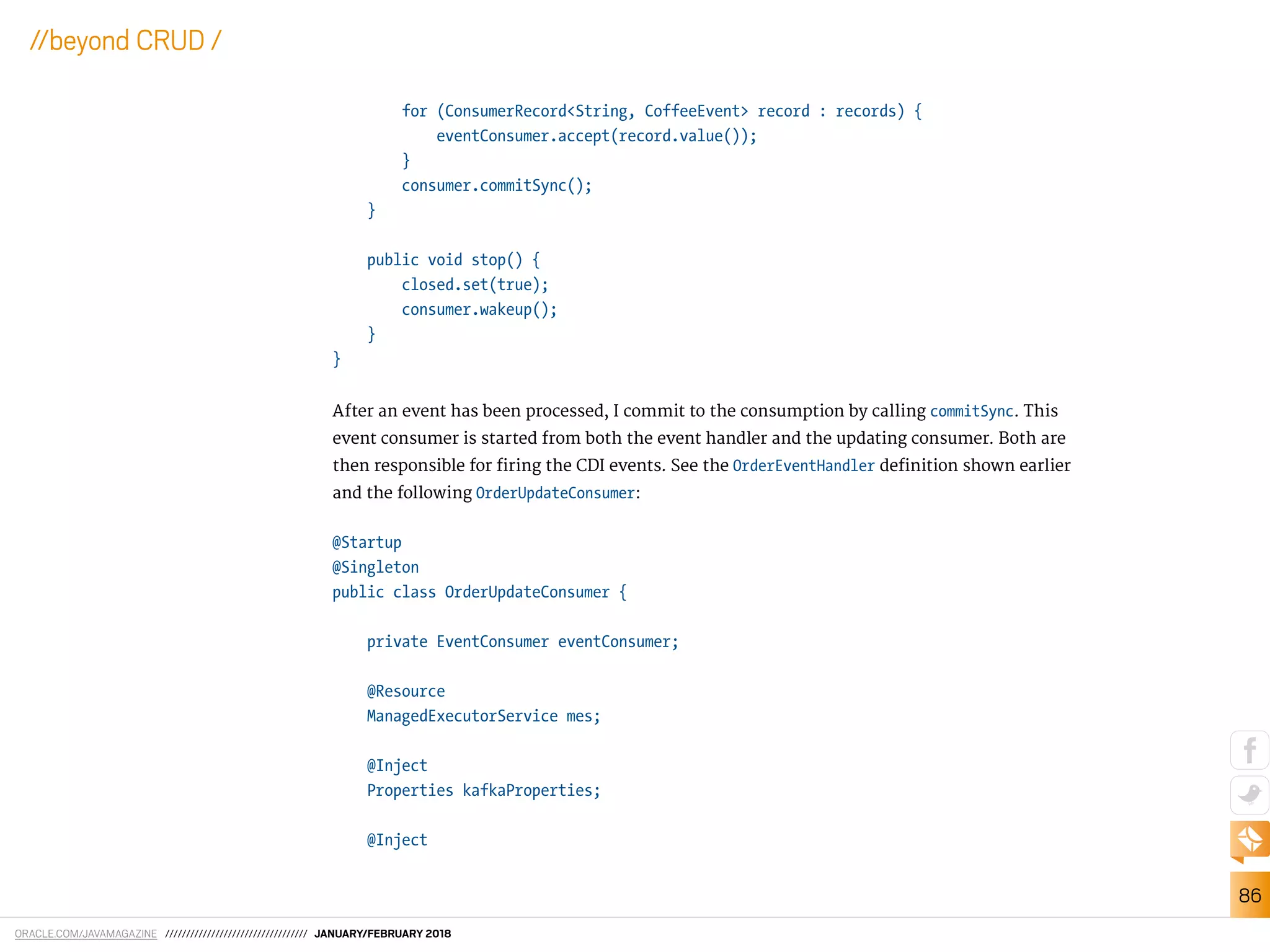

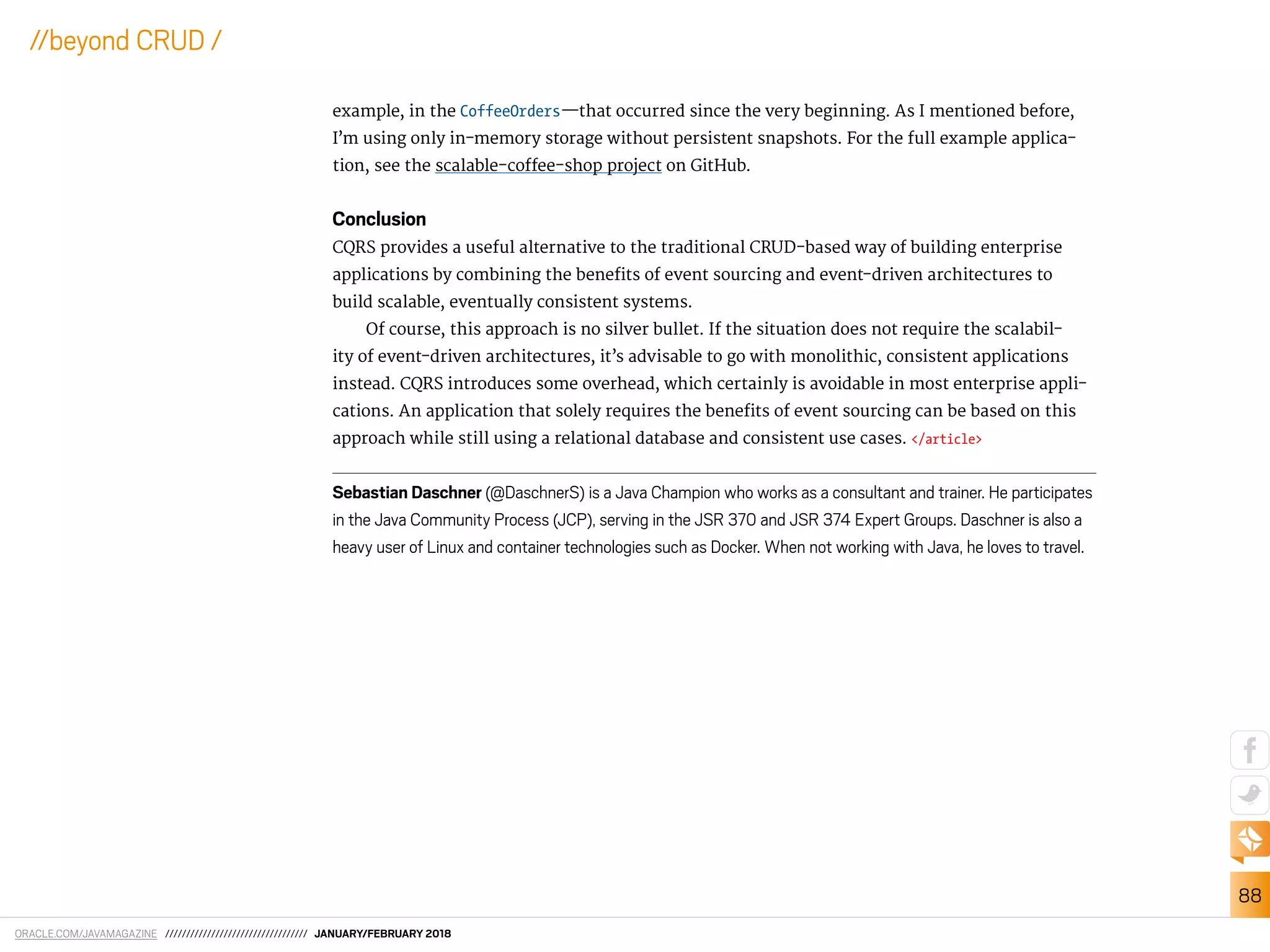

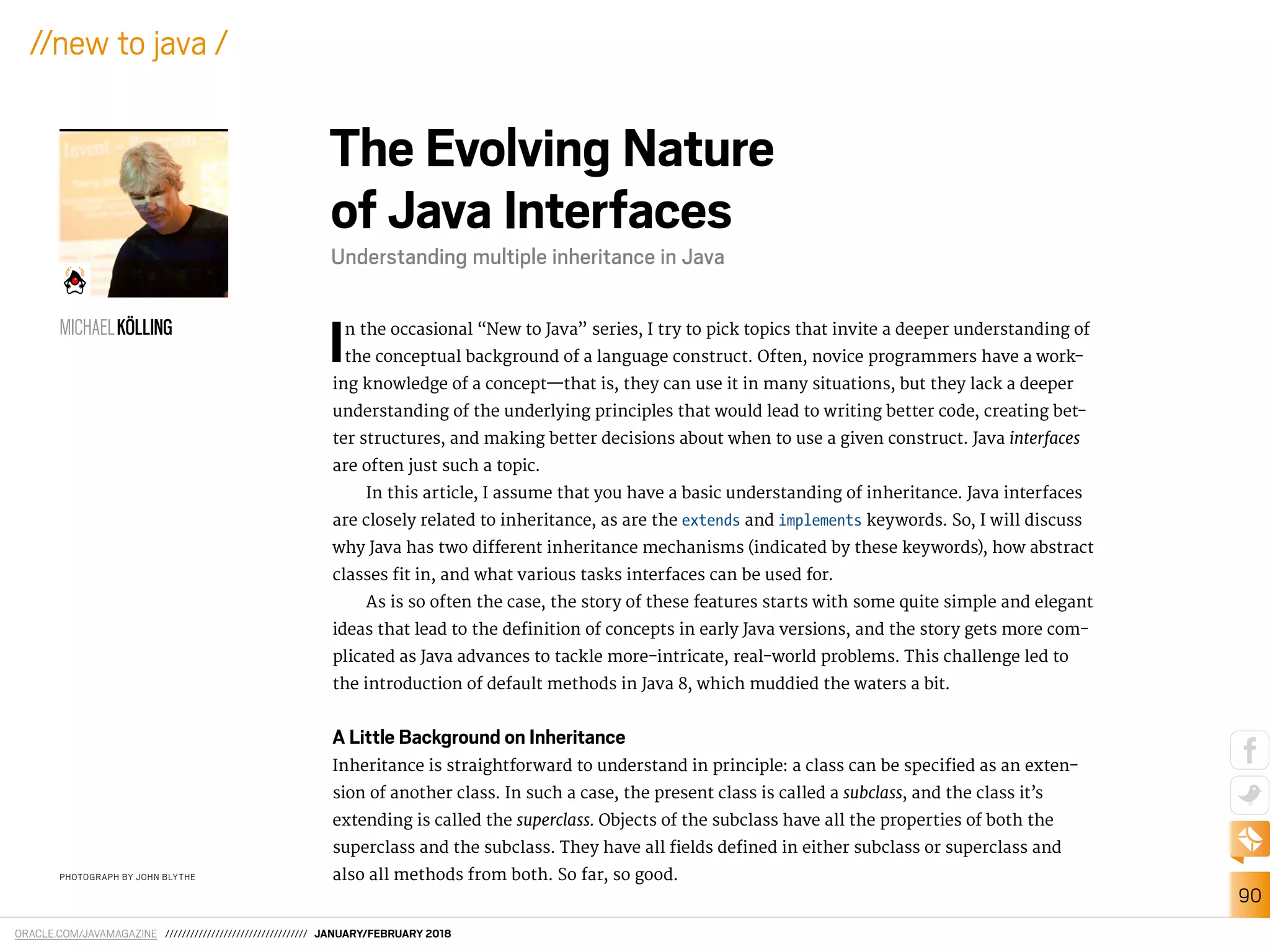
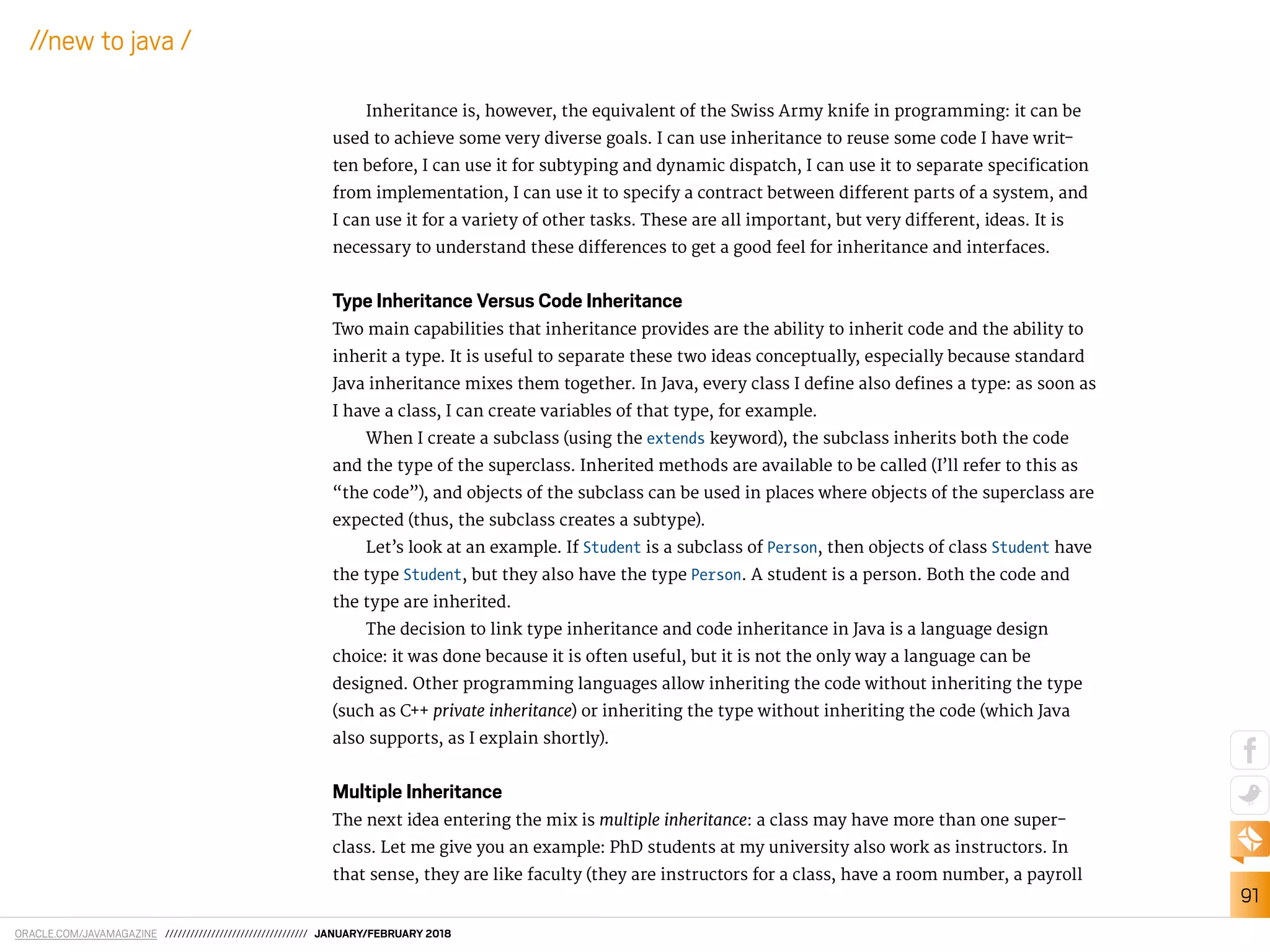

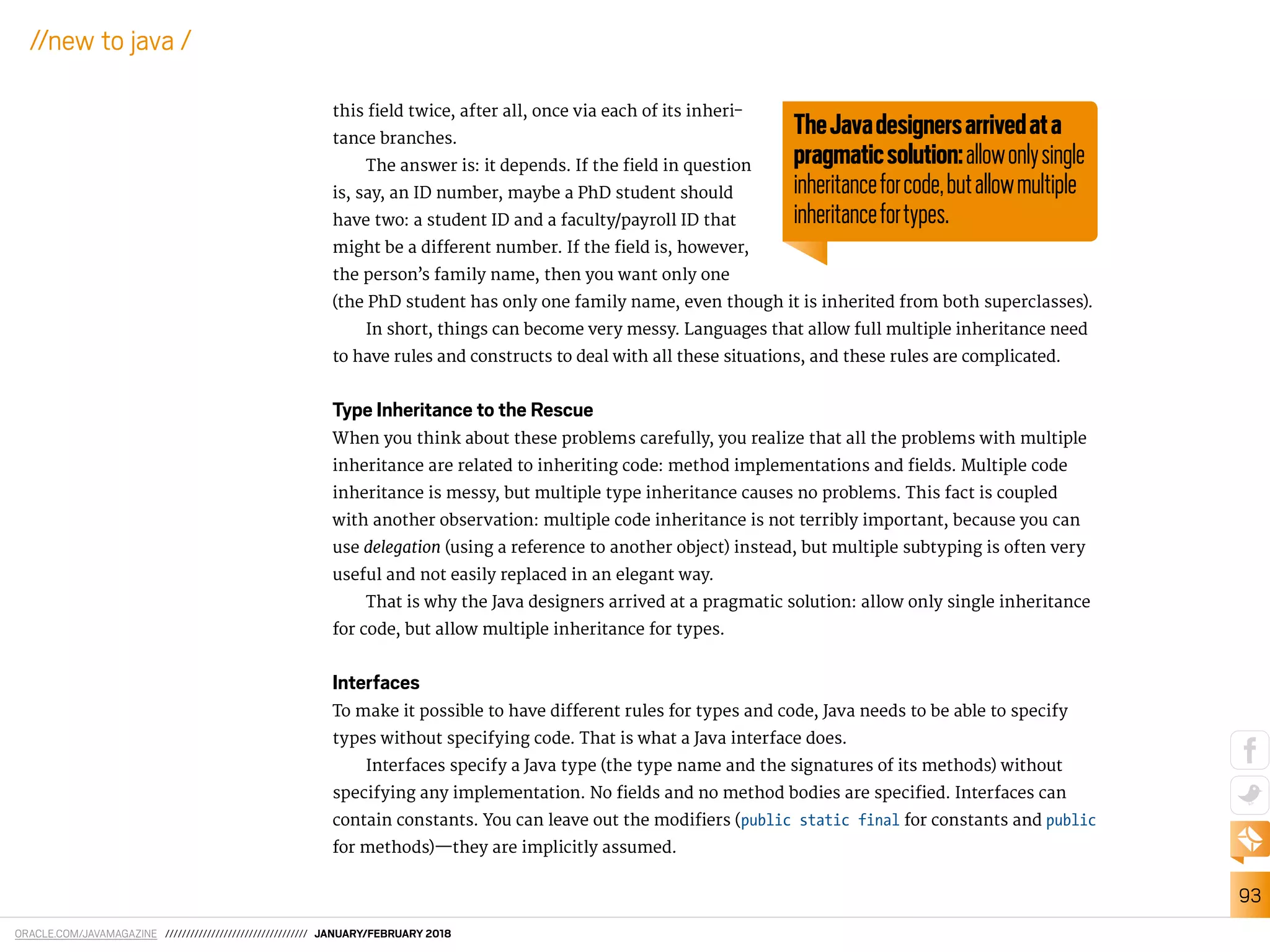
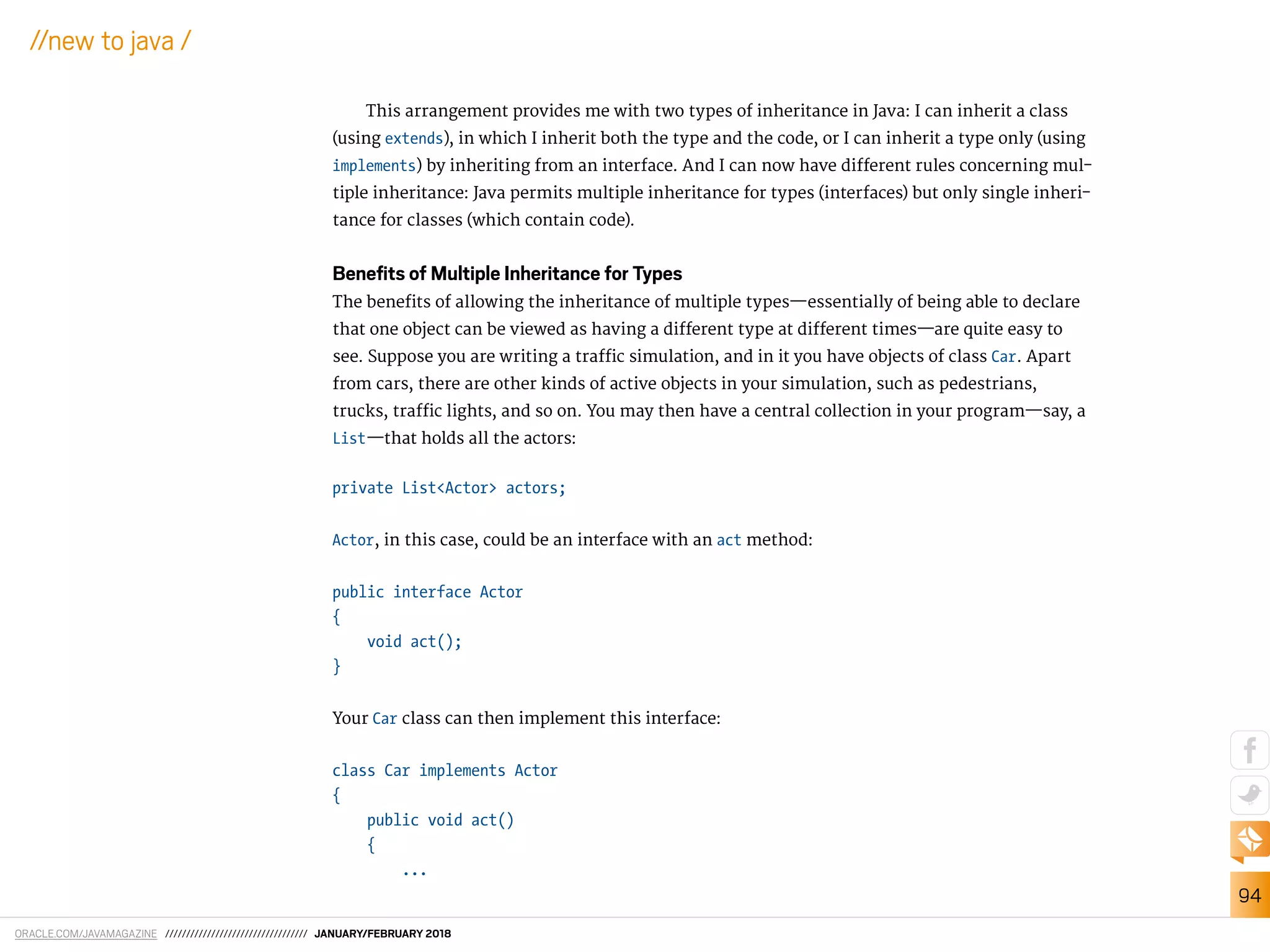

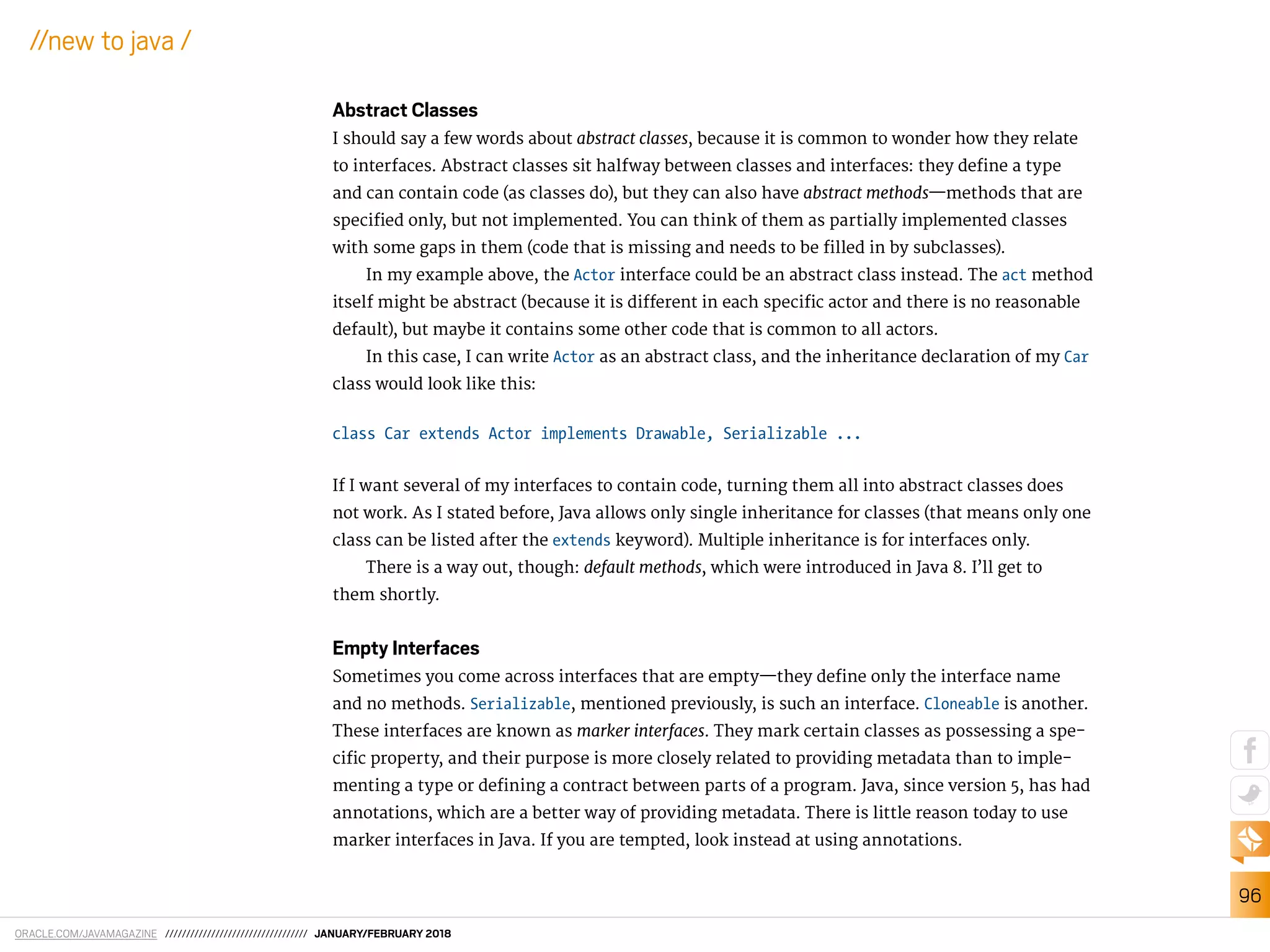
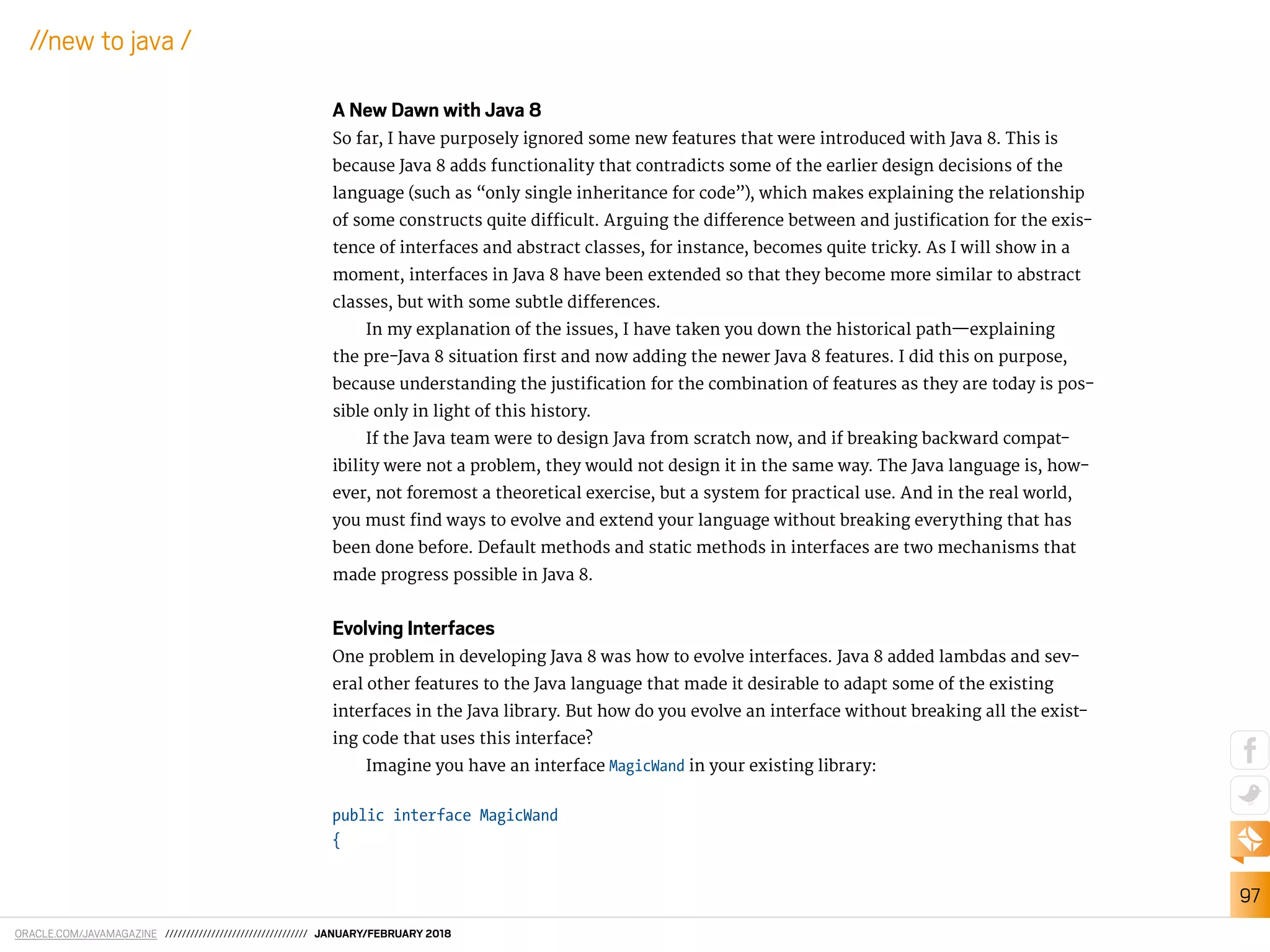
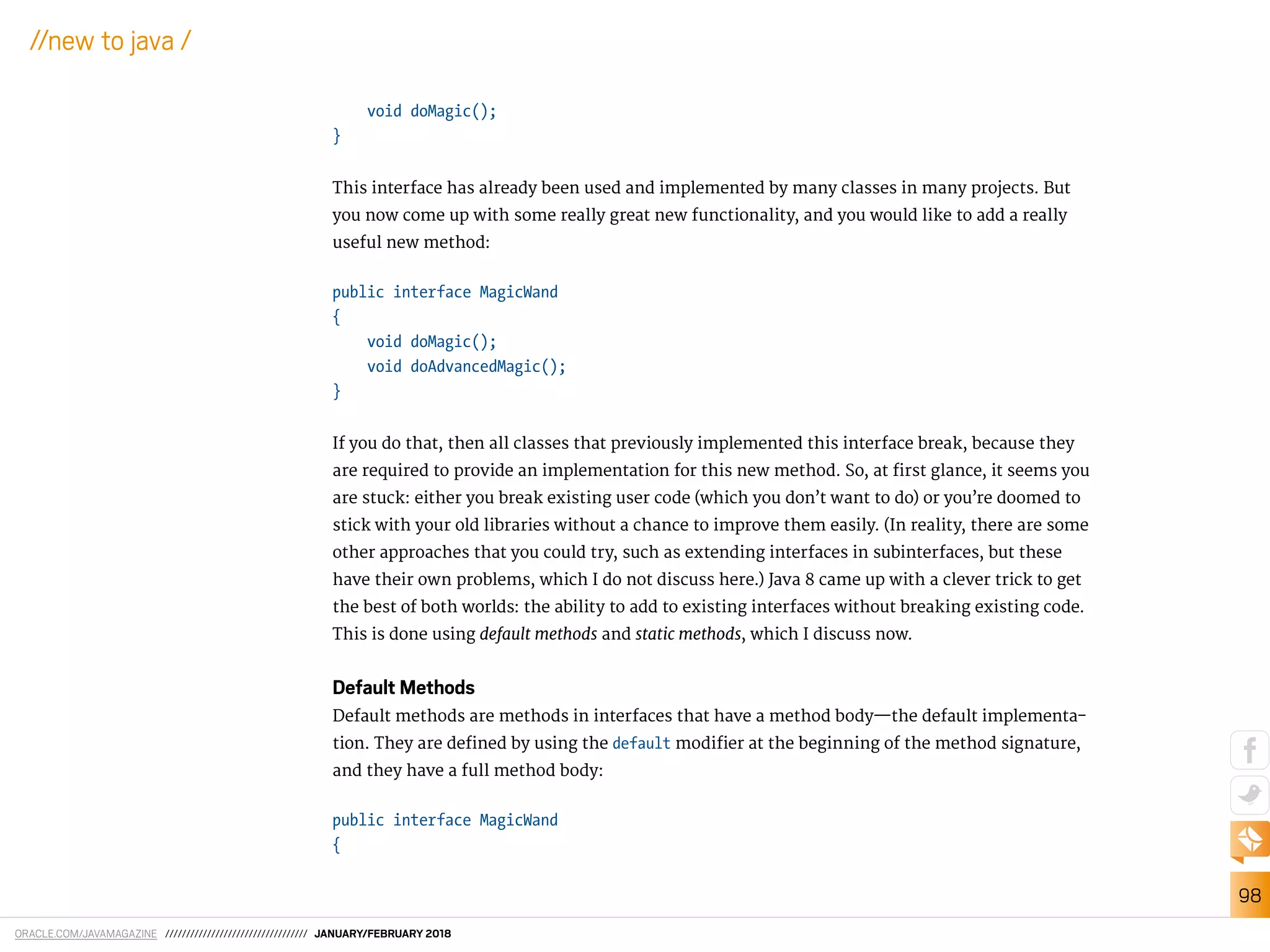
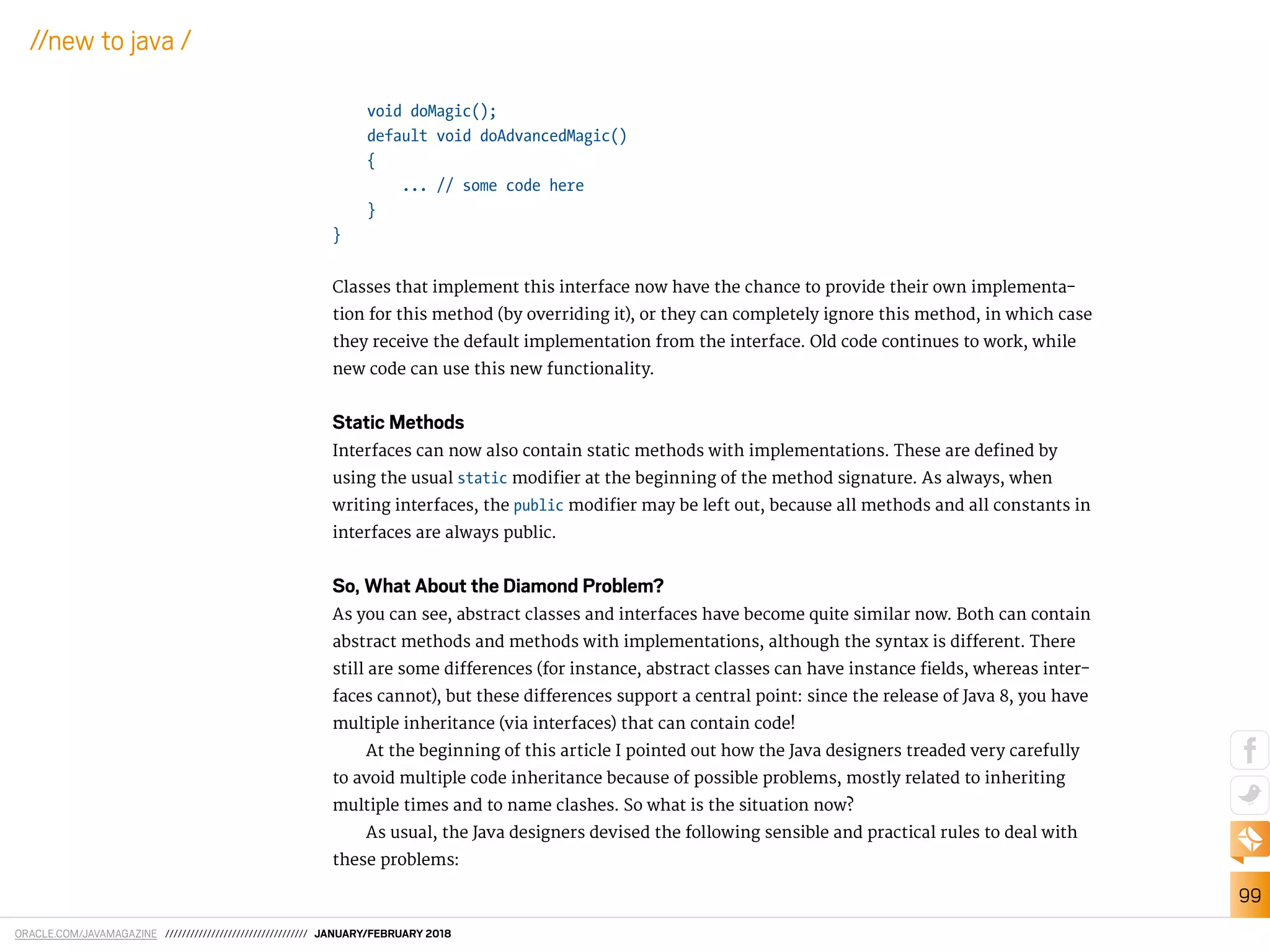
![ORACLE.COM/JAVAMAGAZINE ////////////////////////////////// JANUARY/FEBRUARY 2018
100
//new to java /
■■ Inheriting multiple abstract methods with the same name is not a problem—they are viewed
as the same method.
■■ Diamond inheritance of ields—one of the diicult problems—is avoided, because interfaces
are not allowed to contain ields that are not constants.
■■ Inheriting static methods and constants (which are also static by deinition) is not a problem,
because they are preixed by the interface name when they are used, so their names do not clash.
■■ Inheriting from diferent interfaces multiple default methods with the same signature and
diferent implementations is a problem. But here Java chooses a much more pragmatic solu-
tion than some other languages: instead of deining a new language construct to deal with
this, the compiler just reports an error. In other words, it’s your problem. Java just tells you,
“Don’t do this.”
Conclusion
Interfaces are a powerful feature in Java. They are useful in many situations, including for
deining contracts between diferent parts of the program, deining types for dynamic dispatch,
separating the deinition of a type from its implementation, and allowing for multiple inheri-
tance in Java. They are very often useful in your code; you should make sure you understand
their behavior well.
The new interface features in Java 8, such as default methods, are most useful when you
write libraries; they are less likely to be used in application code. However, the Java libraries
now make extensive use of them, so make sure you know what they do. Careful use of interfaces
can signiicantly improve the quality of your code. </article>
[An earlier version of this article ran in the September/October 2016 issue of Java Magazine. —Ed.]
Michael Kölling is a Java Champion and a professor at the University of Kent, England. He has published two
Java textbooks and numerous papers on object orientation and computing education topics, and he is the lead
developer of BlueJ and Greenfoot, two educational programming environments. Kölling is also a Distinguished
Educator of the ACM.](https://image.slidesharecdn.com/javamagazinejanfeb2018-181010114542/75/Java-magazine-jan-feb-2018-101-2048.jpg)
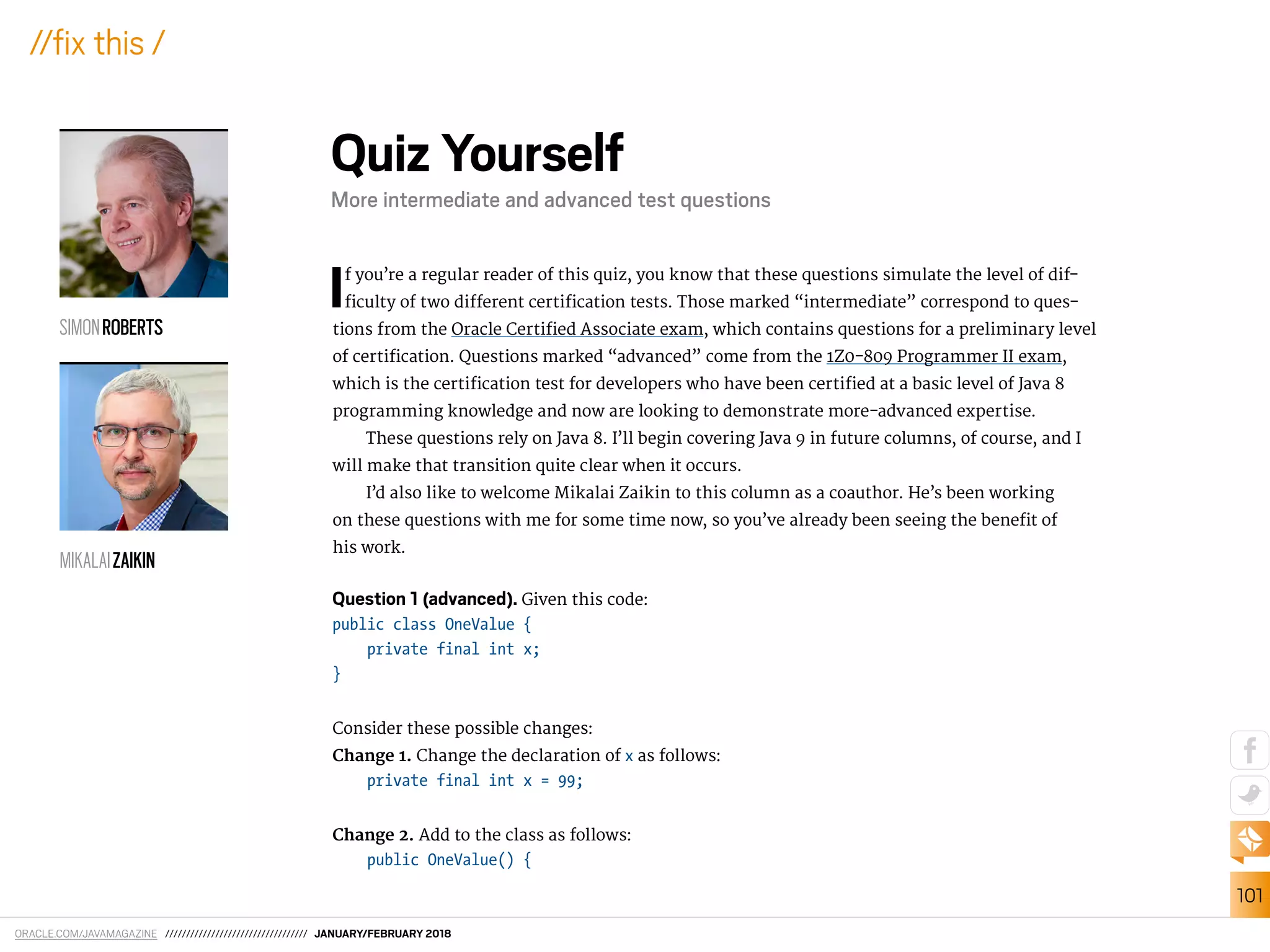
![ORACLE.COM/JAVAMAGAZINE ////////////////////////////////// JANUARY/FEBRUARY 2018
102
//ix this /
x = 100;
}
Change 3. Add to the class as follows:
private void setX(int x) {
this.x = x;
}
public OneValue() {
setX(100);
}
Which are true? Choose two.
A. The code compiles as it is.
B. The code compiles if change 1 is done.
C. The code compiles if change 2 is done.
D. The code compiles if change 3 is done.
E. The code compiles if change 1 and change 2 are both done.
Question 2 (advanced). Which of the following classes produce immutable objects? Choose two.
A.
public class Immut1 {
final int[] data = { 1, 1, 2, 3, 5, 8, 13 };
String name;
public Immut1(String n) { this.name = n; }
}
B.
public class Immut2 {
final int[] data = { 1, 1, 2, 3, 5, 8, 13 };
final String name;](https://image.slidesharecdn.com/javamagazinejanfeb2018-181010114542/75/Java-magazine-jan-feb-2018-103-2048.jpg)
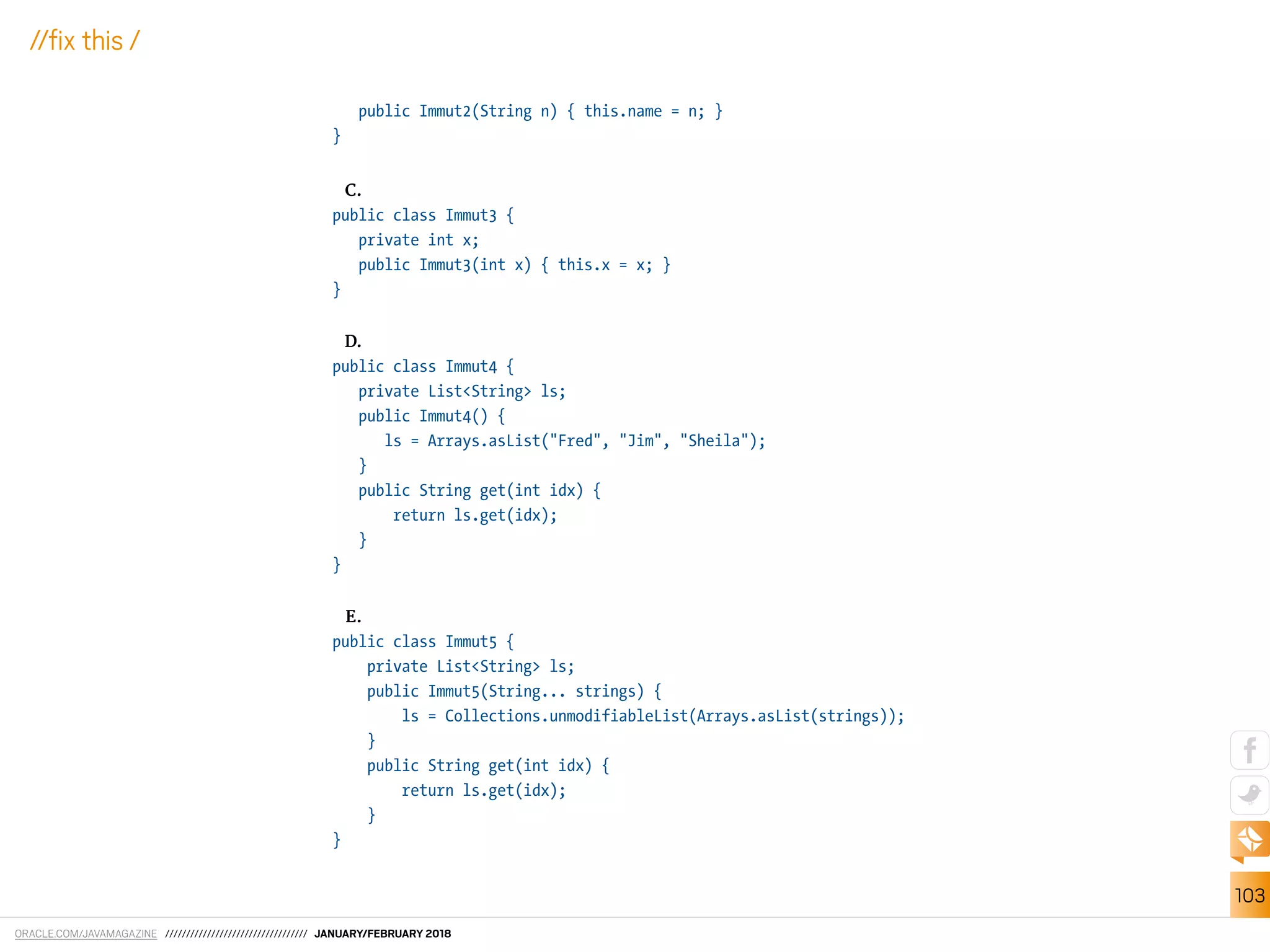

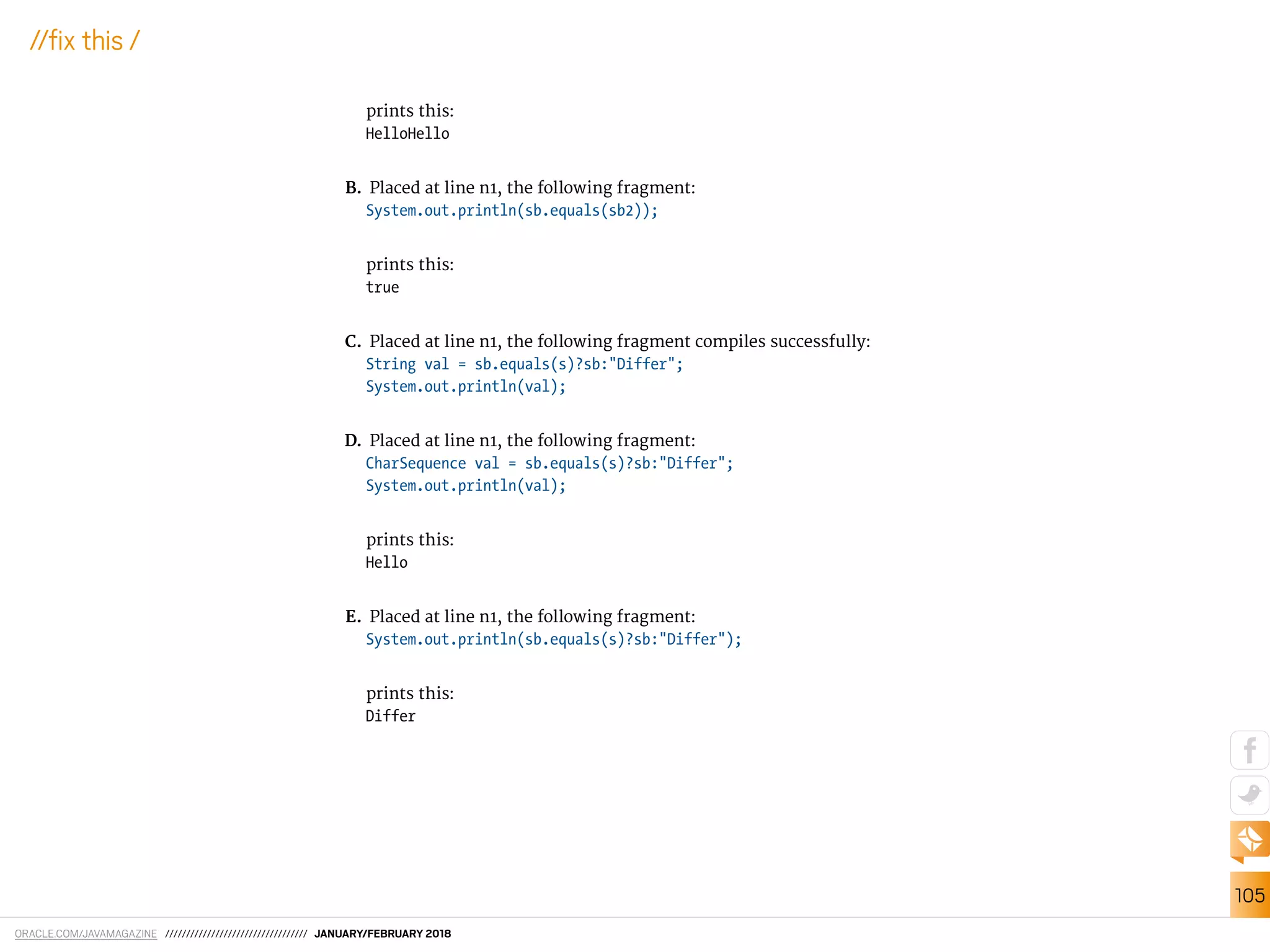
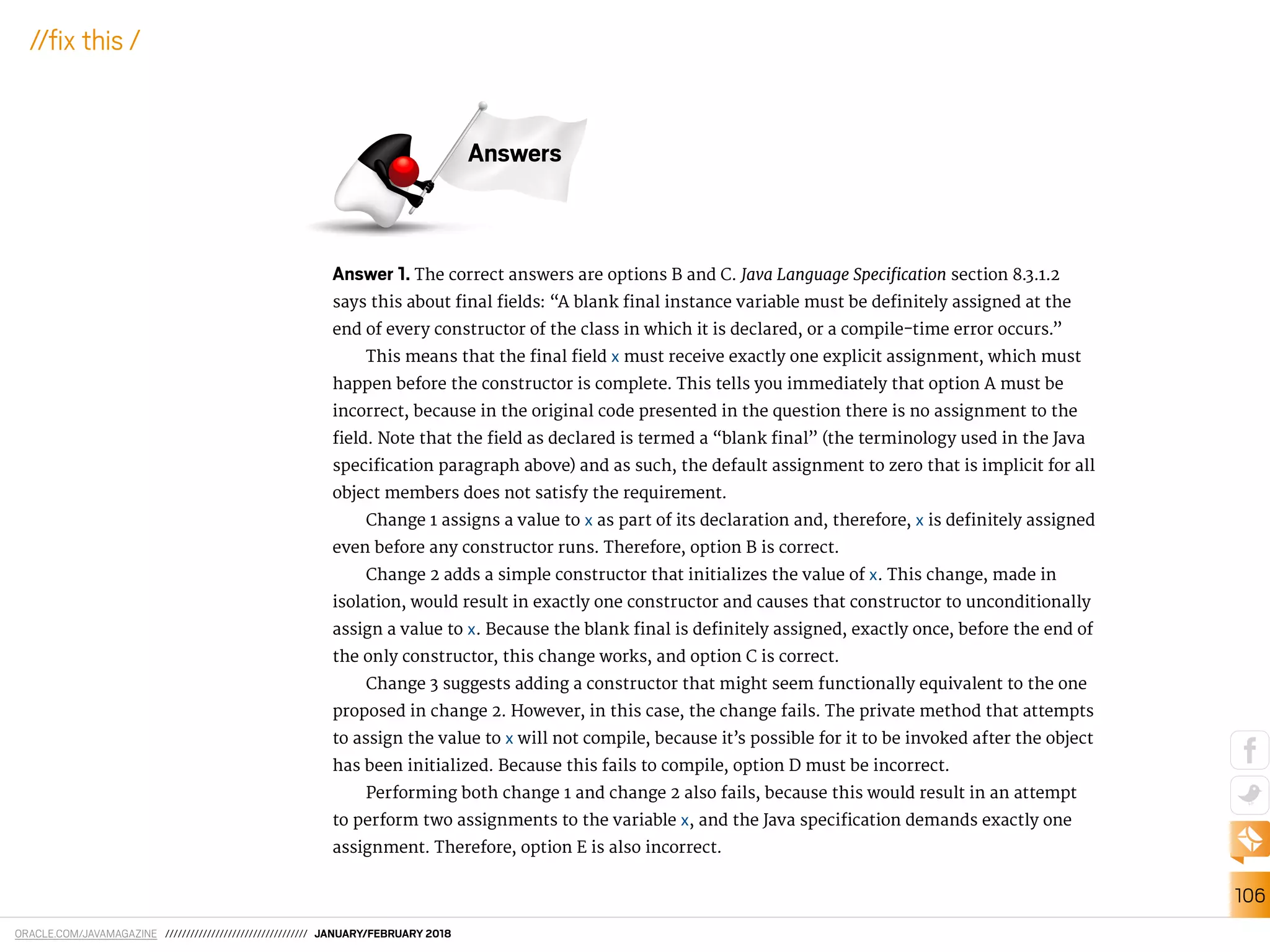
![ORACLE.COM/JAVAMAGAZINE ////////////////////////////////// JANUARY/FEBRUARY 2018
107
//ix this /
Answer 2. The correct answers are options C and D. An object is immutable if no syntactically
permissible interaction with it by external code can change its state after construction, and no
code within the class ever makes any such change either. Literally, once it is created, the value
remains the same.
Now, before analyzing this question, be aware that if you decide to create classes that yield
immutable objects (which is a design style that can reap signiicant rewards in terms of correct-
ness, particularly in concurrent systems), you should do a better job than the examples shown
here. In particular, although you’ll see that
the final keyword is not suicient to render
everything it touches unalterable, it should
almost certainly be used anyway. In particu-
lar, it has some value in concurrency that
is not part of this discussion. Also keep in
mind that it’s possible to break many forms
of immutability through relection, which
might have unexpected consequences.
In option A, the ields have default accessibility, rather than being private, so it’s a simple
matter for any other class that has access (that is, any other class in the same package) to mutate
the value of the String name to point to a diferent string. Therefore, option A is incorrect.
In option B, the String name ield has been marked inal, so even though it’s accessible to
other members of the package, it cannot be mutated; it must refer to the string object that’s
passed into the constructor. Strings themselves are immutable, so that ield’s value can never
be changed. However, the contents of final int [] data can, in fact, be changed (and actually, it
could be changed in option A, too, although you already know option A is incorrect based on the
string ield). This is because the final keyword prevents the value of data—which is a pointer—
from being modiied. So, data can never refer to any array other than the one with which it’s
initialized. Of course, the length of arrays can never change after they are created, but their
contents can be changed. Therefore, the values in the data array are actually mutable by any
code in other classes in the same package. Hence, option B is incorrect.
Thisquestioninvestigatestherulesand
purposeofJava’sexceptionmechanism,
anditalsodarestostrayintothattroublesome
territoryofaskingwhat’s“best”ratherthan
merelywhat’s“correct.”](https://image.slidesharecdn.com/javamagazinejanfeb2018-181010114542/75/Java-magazine-jan-feb-2018-108-2048.jpg)
![ORACLE.COM/JAVAMAGAZINE ////////////////////////////////// JANUARY/FEBRUARY 2018
108
//ix this /
In option C, there is a single ield: int x. The ield is private but not inal. The value of the
ield is initialized with a copy of the value passed to the constructor. (All arguments in non-
remote Java method invocations are passed by value, and with primitive types, the “value”
really is the value being represented, not the “value of the reference.”) Because of this, changes
to the original variable that was passed as an argument to the constructor do not afect the
value of x. Also, no code in the class ever changes the value of x after the object is constructed.
So, even though the ield is not marked inal, instances of this class are immutable, and option
C is correct.
In option D, you again see a private, noninal ield. This time, it’s List<String> ls. Because
it’s private, and nothing outside the class ever has a copy of the reference value in ls, nothing
will ever change the contents of the list
or point the variable at a diferent list.
Therefore, option D is correct.
Option E is a little more subtle. You
have a variable, ls, which is identical
to the one described in option D.
Therefore, you know that nothing
changes the value of ls to make it refer to a diferent list object. If you can be sure that the list
that ls refers to cannot be altered in any way, you would know the object is immutable.
The variable ls is initialized to refer to a list created by the Arrays.asList method, which
is a utility that describes itself as creating a “structurally immutable list”—which sounds
promising; the list will not allow the addition or removal of elements. However, the list cre-
ated by Arrays.asList actually honors attempts to reassign any given element of the list. But to
counter that, this list is wrapped in Collections.unmodifiableList, which puts a proxy wrapper
around the object, so that any attempt to modify the list will throw an exception. Surely this
must be immutable, right? Well, it turns out that the list that’s created uses the provided array
as its backing storage. Therefore, if the caller of the constructor chooses to provide an explicit
String [] as its argument, any changes made to that array will be relected in the list. Because
of this, the objects are not reliably immutable and option E is incorrect.
It’sprohibitedforanoverridingmethodto
declarecheckedexceptionsthatwerenotalready
permittedinthecontextoftheoverriddenmethod.](https://image.slidesharecdn.com/javamagazinejanfeb2018-181010114542/75/Java-magazine-jan-feb-2018-109-2048.jpg)
![ORACLE.COM/JAVAMAGAZINE ////////////////////////////////// JANUARY/FEBRUARY 2018
109
//ix this /
If you want to examine this efect, try running this code:
String [] names = {"Tony", "Jane"};
Immut5 i5 = new Immut5(names);
System.out.println("i5.get(0) " + i5.get(0));
names[0] = "Anthony";
System.out.println("i5.get(0) " + i5.get(0));
Answer 3. The correct answer is option D. This question investigates the rules and purpose of
Java’s exception mechanism, and it also dares to stray into that troublesome territory of asking
what’s “best” rather than merely what’s “correct.” However, we hope to make a good case for
that value judgment, and while we are happy to include this question because it creates a useful
discussion—both about Java’s exception mechanism and about how to evaluate a judgment like
this—we doubt that this question would survive unchanged in the real exam.
The irst point is that Java distinguishes checked exceptions from unchecked exceptions
and errors. In particular, a method that might throw a checked exception must announce this
in that method’s signature. In this question, the appropriate point for the syntax that declares
such information is marked /* point A */. Therefore, the question is really asking what excep-
tion declaration would best suit this method. It’s pretty clear that any situation that doesn’t
even compile cannot be considered satisfactory, so as long as some of the options would compile
they must be “better than” any that do not. Consider the issue of compilation irst.
If the method might throw any checked exceptions, it must carry a declaration that
announces that. In this case, the only checked exception that is potentially thrown is the
IOException; so at a minimum, the method must declare something that encompasses that
exception. Options B and E fail on that point, because they declare unchecked exceptions.
(Note that OutOfMemoryError falls into the category of “unchecked,” although it’s a subclass of
Throwable, not of Exception.) For convenience, we’ll simply use the term unchecked exceptions to
include errors that are not parents of IOException. Therefore, options B and E are incorrect.](https://image.slidesharecdn.com/javamagazinejanfeb2018-181010114542/75/Java-magazine-jan-feb-2018-110-2048.jpg)
